
Industrial Ethernet choices for networking Industrial Edge machine connectivity solutions 21 Intelligent gateways for manufacturing 24 Emergence of TSN Technology Q&A 40 Visit us on the web n www.iebmedia.com ISSN 1470-5745 July/August 2023 Industrial Edge Impact on Smart Manufacturing 137 Industrial Ethernet Automation Networking & IIoT Technology Update Twenty Years of EtherCAT Communications Page 34 53 6

Industrial Edge/Cloud Technology
INDUSTRIAL EDGE COMPUTING AND CLOUD technologies are working together to shape the future of industrial plant networks as more and more companies work to merge IT and OT operations and deal with cybersecurity threats. Here are highlights of the series of the articles in this issue on this important topic.

In our special report beginning on page 6, the Industrial Ethernet Book presents a series of inputs from industry experts to gain their insights into the megatrends driving Industrial Edge and Cloud technology, new applications and the challenges facing automation engineers.
According to Benson Hougland, VP Product Strategy & Marketing, Opto 22, “Industrial Edge architectures use edge computing devices with built-in cybersecurity features to process, analyze, and control data where it’s produced, at the network's edge. Local processing improves data quality and reduces the amount of data sent to the cloud, for faster response times and improved connectivity.”
A combination of edge and cloud computing is allowing automation engineers to adopt a multi-layered security approach, achieve scalability for increasing workloads, and enhance accessibility to OT data. By leveraging these advancements, engineers can design resilient architectures that address key challenges and unlock the full potential of industrial automation data.
On page 21, Dr. Christopher Anhalt, Vice President Product Marketing at Softing presents how edge computing is the next big thing for manufacturing. After providing a definition of “edge” itself, this article goes on to describe the current technological advances and market development for industrial edge computing, paying special attention to the interplay of machine connectivity and edge, as well as questions of operating models and the scalability of industrial IoT solutions.

In the "Intelligent Gateways for Manufacturing in the Digital Era" article starting on page 24, Vladimír Ševcík, Product Manager at Siemens presents how benefits at multiple levels can be obtained by centralizing the collection of accurate data directly from production systems, its transmission, and subsequent processing. Digitalization helps to integrate enterprisewide operations, optimize the manufacturing process, and facilitate the work of operators, maintenance staff, planners, programmers, quality assurance officers, and management.
Al Presher
Industrial Ethernet Book
The next issue of Industrial Ethernet Book will be published in September/October 2023. Deadline for editorial: September 13, 2023

Editor: Al Presher, editor@iebmedia.com
Advertising: info@iebmedia.com
Tel.: +1 585-598-6627
Free Subscription: iebmedia.com/subscribe
Advertising deadline: September 13, 2023
3 Contents Industry news 4 How the Industrial Edge is impacting smart manufacturing 6 Emergence of edge and cloud computing enabled by IEC-62443 19 Machine connectivity and industrial edge computing 21 Intelligent gateways for manufacturing in the digital era 24 Securing industrial automation systems using IEC 62443-4-2 28 Edge computing set to revolutionize manufacturing 30 New AI edge computing products 33 20 years of compatible, open EtherCAT communications 34 Standardization promotes user safety and opens new markets 38 Emergence of Time-Sensitive Networking Q&A 40 Ethernet of the future with TSN: connectivity on a new level 42 TSN revolutionises footwear manufacturing 43 Time Sensitive Networking in semiconductor manufacturing 44 Taking the proven benefits of TSN to the real world 46 Automation with remote motion control for intelligent nodes 49 Advancing Industrial Ethernet creates choices for networking 53 Wireless solutions for access points and bridges 56 Six benefits of augmented reality in manufacturing 58 New Products 61
07.2023 industrial ethernet book Contents
Visit our new website at: www.iebmedia.com AR in manufacturing: 58 New Products: 61
GET CONNECTED…
Published by IEB Media Corp., Box 1221, Fairport, NY, 14450 USA ISSN 1470-5745
Network automation market to cross USD 30 Billion by 2028
The network automation market is set to grow from its current market value of more than $5 billion to over $30 billion by 2028, as reported in the latest study by Global Market Insights, Inc.
THE NETWORK AUTOMATION INDUSTRY IS speculated to exhibit robust progress by 2028, owing to widespread adoption of cloud-based services across key regions.
The COVID-19 pandemic has significantly impacted the industry landscape with the advent of completely automated remote offices, increasing emphasis on cloud strategies, and the necessity to develop new communications software tools. This has led to an influx of investment from network automation solution vendors, which has accelerated market growth in recent years.
The network automation market has been segmented based on application, component, deployment model, type, network infrastructure, and region.
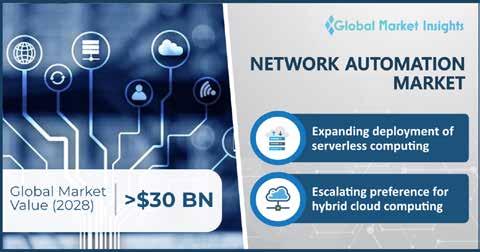
In terms of component, the market has further been classified into service and software. Under services, the market has been divided into managed and professional.
The professional segment accounted for a substantial market share of around 70% in 2021 and is slated to grow at a sturdy pace through the analysis period. Professional services enable enterprises to invest their critical resources in their core areas that directly generate revenue, which is set to boost segmental growth over the assessment timeline.
The managed segment is expected to witness staggering expansion, progressing at a CAGR of approximately 40% over the forecast timeframe. This is due to the increasing number of SMEs offering innovative solutions
at affordable prices.
With respect to the type, the network automation market has been categorized into wireless networks, local area network, cloud networks, wide area network, and data center networks. The wide area network (WAN) sub-segment is speculated to grow at a 20% CAGR through the estimated period. WAN provides the most extensive geographical coverage to deploy the latest technologies in existing networks, which is likely to fuel product adoption.
The data center networks sub-segment is foreseen to reach a significant valuation by 2028, registering a CAGR of more than 35% through the review timeframe. This growth is attributed to the prevalent adoption
of centralized network provisioning and integrated enterprise management.
Based on application, the market has been bifurcated into retail, manufacturing, BFSI, telecom & IT, energy & utilities, healthcare, and others.
The network automation market from the energy & utilities sub-segment is anticipated to grow at a 30% CAGR over the stipulated period on account of mounting demand for digitalization and adoption of the smart grid technology.
News report by Global Market Insights Visit Website
Integrating AI-based robotics and automation technology
Bridging both worlds will speed up the development process of flexible, AI-enabled robot work cells.
INTRINSIC, AN ALPHABET COMPANY, and Siemens have teamed up to explore integrations and interfaces between Intrinsic’s robotics software, which is designed for easy use of AI-based capabilities, and Siemens Digital Industries with their open and interoperable portfolio for automating and operating industrial production.
Intrinsic has a world-class team of robotics and AI experts with a strong footprint in advanced perception, machine learning and reinforcement learning. Siemens’ automation engineers and software developers have industry-leading domain know-how in
automation technology in the industrial space.
Currently, the development and runtime environments for AI-based robotics and automation components differ significantly in their development paradigms and make integration cumbersome. For example, deploying advanced robotic capabilities such as pose estimation, robot manipulation or automated path planning are complex processes that typically require teams of domain experts to operationalize. The two companies intend to investigate new methods to seamlessly bridge the gaps between
robotics, automation engineering and IT development.
Bridging both worlds will speed up the development process of flexible, AI-enabled robot work cells and facilitate their seamless operation. This will make industrial robotics more accessible and usable for more businesses, entrepreneurs, and developers - particularly for new market segments like small and medium-sized companies.
News report by Siemens and Intrinsic. Learn More
4 Industry news industrial ethernet book 07.2023
SOURCE: GLOBAL MARKET INSIGHTS
Entry to high-end measurement technology: precise, fast, robust
Basic line ELM3x0x 24 bit
10 ksps per channel
Simultaneous
Up to 25 ppm @ 23°C
The
expand the spectrum of system-integrated, highly scalable high-end measuring technology

extensive, variable filter functions
true RMS calculation and differentiator/integrator
standard EtherCAT interface for operation on any EtherCAT master
Basic line ELM3x0x
input wiring: voltage 20 mV … 60 V, current 20 mA, IEPE, DMS, RTD/TC, resistance
Economy line ELM3x4x
supplements the Basic line with the 1 kSps sample class at low channel costs
input wiring: voltage 1.25 … 10 V, current 20 mA, RTD/TC
Economy line ELM3x4x 24 bit
1 ksps per channel
Multiplex
Up to 100 ppm @ 0 … 50°C
EK11-18E
EtherCAT measurement modules in the ELM Basic and Economy lines:
Scan to learn everything you need to know about the benefits of systemintegrated high-end measurement technology
How the Industrial Edge is impacting smart manufacturing

Industrial Edge and cloud computing technologies provide scalable, flexible computing resources for storing, analyzing, and visualizing the vast amounts of data industrial systems generate, and increasingly deal with cybersecurity threats. Industry experts provide their perspective on what lies ahead for industrial applications.
INDUSTRIAL EDGE AND CLOUD TECHNOLOGIES
are working together to shape the future of industrial plant networks as more and more companies work to merge IT and OT operations and deal with cybersecurity threats.
In this special report, the Industrial Ethernet Book reached out to industry experts to gain their insights into the megatrends driving Industrial Edge and Cloud technology, new applications and the challenges facing automation engineers.
Edge computing with built-in cybersecurity
Leveraging MQTT, Sparkplug B to process, analyze and control data at the network’s edge.
MQTT, Sparkplug B, edge computing, and cloud applications are key technology trends for Industrial Edge and Cloud architectures, Benson Hougland, VP Product Strategy & Marketing at Opto 22 told the Industrial Ethernet Book recently.
MQTT is a messaging protocol that enables reliable real-time communication between edge devices, like sensors and actuators, and
cloud-based applications. Using MQTT, these devices and applications can exchange data seamlessly.
Sparkplug B is a specification built on top of MQTT. Designed specifically for industrial automation and control systems, it provides a standardized format for publishing and subscribing to data. This format ensures interoperability and easy integration between devices and applications.
“Industrial Edge architectures use edge computing devices with built-in cybersecurity features to process, analyze, and control data where it’s produced, at the network's edge. Local processing improves data quality and reduces the amount of data sent to the cloud, for faster response times and improved connectivity,” Hougland said.
“Cloud applications provide scalable, flexible computing resources for storing, analyzing, and visualizing the vast amounts of data industrial systems generate. Cloud applications can offer advanced analytics, machine learning, predictive maintenance, HMIs for remote monitoring and supervisory control (SCADA), and much more,” he added.
Looking at the benefits
For manufacturers, industrial edge and cloud computing offer cybersecurity, data democratization, scalability, and easier ways to manage industrial systems.
Industrial systems are often vulnerable to cyber threats, making robust cybersecurity measures critical. Edge and cloud architectures employ secure communication protocols, data encryption, access control, and authentication mechanisms that help protect industrial infrastructure, data, and operations from unauthorized access and data breaches. It is critical that these cybersecurity measures are employed at both the edge and at the cloud layers.
“Edge and cloud architectures democratize OT data, making it accessible to stakeholders across the organization,” Hougland said. “Centralizing data storage and analysis in the cloud means that authorized personnel can access real-time and historical data from anywhere, improving decision-making, optimizing performance, and making operations more efficient.”
Data volume constantly grows, and
6
“Industrial Edge architectures use edge computing devices with built-in cybersecurity features to process, analyze, and control data where it’s produced, at the network's edge. Local processing improves data quality and reduces the amount of data sent to the cloud, for faster response times and improved connectivity,” -- Benson Hougland, VP Product Strategy & Marketing, Opto 22.
industrial ethernet book 07.2023 Industrial Edge
SOURCE: ISTOCK
operational requirements expand, but industrial edge and cloud architectures can easily scale to accommodate them. Cloud computing provides virtually unlimited storage and computing resources. Edge computing distributes data processing to handle increasing workloads.
Hougland added that industrial edge and cloud architectures also make it easier to manage industrial systems. Edge computing offers local management and control for a granular level of oversight and autonomy in industrial environments. Meanwhile, cloud applications centralize management and monitoring, so administrators can oversee multiple edge devices, applications, and data streams from a single interface. This centralized management simplifies system configuration, updates, and maintenance, reducing operational overhead and improving overall system reliability.
Importance of cybersecurity
In industrial environments, cybersecurity is critical. Communication technologies like MQTT and TLS (transport layer security) address cybersecurity concerns in industrial edge-to-cloud architectures because they are edge-originated. Secure communications originate in the edge device, with no open inbound firewall ports needed to transport data. Edge devices publish their data outbound only, and software applications subscribe to this data using the same secure methods.
Hougland said that the key to democratizing operational data is reducing the tight coupling between data-generating devices and the software applications that need the data. MQTT provides this decoupled architecture: all data messages are brokered through a server. Many publishers can send their data to the broker, many subscribers can choose the data they need from what is published, and all can work with the data simultaneously.
In addition, this broker-based architecture provides a single point to manage all data participants and access to the data, from both access control and communication channel standpoints.
Applications focus
Hougland said that edge-to-cloud architectures are obviously well suited for industrial applications that are geographically dispersed, such as Oil & Gas, Water/Wastewater, and other remote monitoring applications.
But manufacturers are widely implementing these architectures as well. In particular, manufacturers find that Operational Equipment Effectiveness (OEE) can benefit from industrial edge and cloud solutions, where accessibility to machine status and production counts can help drive digital transformation initiatives.

OEE data can benefit plant-floor personnel who operate manufacturing equipment locally
at the edge. It can also provide valuable company-wide information to stakeholders such as finance and sales operations, whether on-premises or in the cloud. This information can drive efficiencies and aid in planning across the entire organization.
“Increasingly, automation engineers are faced with the expectation that operational data should be available for immediate use in corporate software applications,” Hougland said. “Yet these same engineers must keep all operations running safely and securely without interruption. And they often have proprietary or legacy systems whose data is locked inside, making data access difficult and costly.”
“Edge computing and cloud computing, however, give automation engineers powerful solutions to address these security, scalability, and OT data accessibility challenges,” he added.
Edge computing enhances security by processing data locally, minimizing exposure to cyber threats. It also enables local decisionmaking and control, improving scalability and responsiveness. Cloud computing complements edge security measures with robust centralized security protocols. It offers virtually unlimited storage and computing resources, allowing engineers to scale applications and data storage as needed.
Edge computing also provides local accessibility to real-time data, so engineers and operators can make faster decisions. Cloud computing, on the other hand, offers centralized access to OT data from anywhere for comprehensive analysis and informed decision-making. With advanced analytics and visualization tools in the cloud, engineers gain
valuable insights for process optimization.
“This combination of edge and cloud computing lets automation engineers adopt a multi-layered security approach, achieve scalability for increasing workloads, and enhance accessibility to OT data. By leveraging these advancements, engineers can design resilient architectures that address key challenges and unlock the full potential of industrial automation data,” Hougland said.
Impact of IoT real-time data collection
Shift of data processing requirements from the cloud to the industrial edge.
According to Georg Stöger, Director Training & Consulting at TTTech Industrial, the emergence of industrial edge and cloud technologies is fueled by several key technology trends that are revolutionizing the industrial landscape. One trend is the widespread adoption of Internet of Things (IoT) devices in industrial settings and the shift of data processing requirements from the cloud to the industrial edge.
“IoT devices provide real-time data collection, enabling enhanced visibility and control over industrial processes. These devices, such as sensors and actuators, connect the physical and digital worlds, facilitating data-driven decision-making,” Stöger said. “Accordingly, we observe advancements in edge computing capabilities. Edge computing brings data processing and analysis closer to the source, reducing latency and enabling faster response times. This trend is particularly
7 07.2023 industrial ethernet book Industrial Edge
SOURCE: TTTECH INDUSTRIAL
“The integration of artificial intelligence (AI) and machine learning (ML) algorithms is a key trend enabling the emergence of industrial edge and cloud technologies. AI and ML empower industrial systems to learn from data, derive actionable insights, and make intelligent decisions." -- Georg Stöger, Director Training & Consulting, TTTech Industrial.
crucial in industrial settings where real-time decision-making is critical.”
“Nevertheless, cloud technologies continue to play a vital role in the industrial edge ecosystem. Cloud platforms provide scalable and flexible computing resources, centralized data storage, and advanced analytics capabilities. They enable seamless integration, data sharing, and remote management of industrial systems, Stöger added.
AI and ML algorithms
Stöger said that the integration of artificial intelligence (AI) and machine learning (ML) algorithms is a key trend enabling the emergence of industrial edge and cloud technologies. AI and ML empower industrial systems to learn from data, derive actionable insights, and make intelligent decisions.
In summary, the key technology trends enabling the emergence of industrial edge and cloud technologies include IoT adoption, advancements in edge computing, the utilization of cloud platforms, and the integration of AI/ML. TTTech Industrial capitalizes on these trends to deliver cuttingedge industrial solutions that drive efficiency, productivity, and innovation.
The combination of industrial edge and cloud computing also offers several very relevant benefits in manufacturing from both
a technical and a commercial viewpoint.
“Industrial edge computing brings data processing and analysis closer to the source, enabling real-time decision-making and reducing latency. This allows for faster response times, improved operational efficiency, and enhanced productivity. Edge computing also facilitates local data storage and processing, ensuring data security and privacy, for example in situations where some edge-local data should not be accessible from the cloud, or needs to be pseudonymized before being uploaded to the cloud,” Stöger said.
“Cloud computing, on the other hand, provides scalable and flexible computing resources. It enables centralized data storage, advanced analytics, and remote management of industrial systems. Cloud platforms offer the ability to handle large volumes of data, perform complex computations, and provide real-time insights. They also enable seamless collaboration and data sharing across different locations,” he added.
In combination, industrial edge and cloud technologies provide manufacturers with real-time visibility into production processes, enabling proactive maintenance, quality optimization, and resource allocation. They facilitate predictive analytics, enable predictive maintenance, and help to reduce
downtime. Manufacturers can also leverage the cloud for remote monitoring and control, facilitating more agile and flexible production processes.
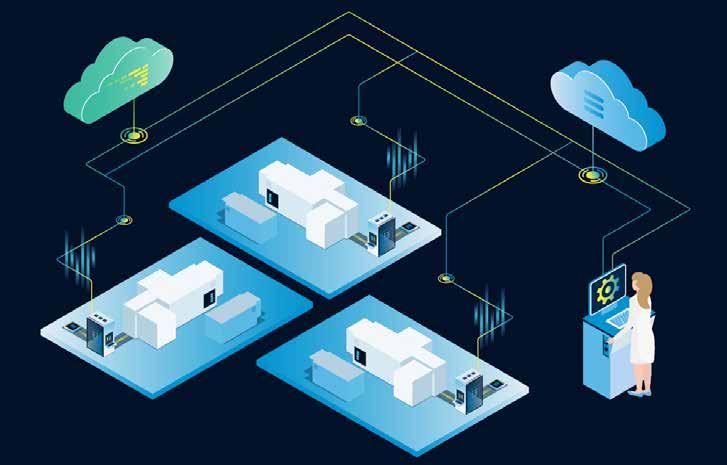
To summarize, the combination of industrial edge and cloud computing provides technical benefits such as real-time decisionmaking, scalability, data security, and advanced analytics. Its potential impact on manufacturing includes improved efficiency, productivity, quality, and flexibility, ultimately driving digital transformation in the industry.
Cloud-based Nerve platform
TTTech Industrial's cloud-based edge computing platform, Nerve, offers unique technical capabilities that set it apart in the industrial landscape. Nerve combines the power of edge computing and cloud technologies with open interfaces to access and process data in the OT domains, host all kinds of user-specific applications at the edge, and provide seamless connectivity, real-time analytics, and remote management for industrial applications.
What makes Nerve unique is its ability to ingest, process, and analyze OT data including real-time fieldbus data robustly and securely directly at the edge, close to the source, while also leveraging the scalability and flexibility of the cloud. It provides a distributed
8 industrial ethernet book 07.2023
SOURCE: TTTECH INDUSTRIAL
Industrial Edge
An edge computing platform like TTTech Industrial’s Nerve enables secure connectivity between machines and production locations, as well as remote access and remote management of data, applications, and software.
architecture that enables field devices, such as sensors and machines, to collect and process data locally, reducing latency and enabling faster response times. Nerve then seamlessly integrates with the cloud, allowing for centralized data storage, advanced analytics, and remote monitoring and control.
This technology finds application in various industrial scenarios. For example, in manufacturing, Nerve enables real-time monitoring of production lines, predictive maintenance, and quality optimization. It facilitates the collection and analysis of data from diverse industrial assets, enabling actionable insights for operational improvements. Nerve's edge computing capabilities enable local decision-making, reducing dependence on cloud connectivity and ensuring continuity in critical operations.
Furthermore, Nerve's cloud-based management system allows for secure data storage, efficient collaboration, and scalability. It provides a centralized platform for remote management, enabling organizations to monitor and control industrial processes from anywhere. Nerve easily connects to advanced analytics capabilities provided by various hyperscaler cloud offerings, supporting the development and deployment of intelligent applications e.g., for anomaly detection and predictive analytics.
TTTech Industrial's Nerve platform stands out by combining edge computing and cloud technologies, offering secure connectivity, real-time analytics, and remote management for industrial applications. Its unique features enhance operational efficiency, enable predictive maintenance, and facilitate the development of intelligent industrial solutions.
Industrial edge and cloud solutions

“The newest industrial edge and cloud solutions are targeting specific application areas across various industries. One prominent area is manufacturing, where these solutions enable real-time monitoring of production lines, predictive maintenance, quality optimization, and resource allocation. They empower manufacturers with data-driven insights, improving efficiency and productivity,” Stöger said.
He added that another key application area is energy and utilities, where industrial edge and cloud solutions support smart grid management, energy optimization, and asset monitoring. These solutions enable real-time analysis of energy consumption patterns, predictive maintenance of infrastructure, and optimization of energy distribution.
In transportation, industrial edge and cloud solutions facilitate fleet management, route optimization, and vehicle health monitoring. They enable real-time tracking and analysis of data from vehicles, contributing to operational
efficiency and enhancing safety.
These solutions play a significant role in the broader Internet of Things (IoT) and enterprise connectivity landscape. Leveraging industrial edge computing enables data processing and analytics to occur closer to the data source, reducing latency and enabling real-time insights. The cloud aspect provides scalable and flexible computing resources, centralized data storage, and advanced analytics capabilities. This integration of edge and cloud technologies ensures seamless connectivity, enabling IoT devices and enterprise systems to communicate and share data efficiently.
Overall, the newest industrial edge and cloud solutions are targeting application areas such as manufacturing, energy, and transportation. They contribute to IoT and enterprise connectivity by enabling real-time insights, optimizing operations, and facilitating seamless data exchange between devices and enterprise systems.
“Advances in edge computing and cloud computing address several challenges that automation engineers face in their work. One key challenge is the increasing complexity and scale of industrial automation systems. With the integration of edge computing, automation engineers can distribute computing resources and processing capabilities closer to the edge devices, reducing the burden on central control systems and improving system performance and responsiveness,” Stöger said.
Another challenge is the need for real-time decision-making and data analysis. Edge computing enables automation engineers to process and analyze data locally at the edge devices, enabling faster response times and real-time insights. This is particularly crucial
in time-sensitive industrial processes. Cloud computing addresses challenges related to data storage, scalability, and collaboration. Automation engineers can leverage cloud platforms to securely store and manage vast amounts of industrial data, eliminating the need for on-premises infrastructure. Cloud-based solutions also provide scalability, allowing for the expansion of computing resources based on demand. Furthermore, cloud platforms facilitate seamless collaboration and data sharing, enabling automation engineers to work together efficiently and access real-time insights from anywhere.
“Overall, the advances in edge computing and cloud computing help automation engineers overcome challenges related to system complexity, real-time decision-making, data storage, scalability, and collaboration, enabling them to design, deploy, and manage automation systems more effectively,” Stöger said.
Real-time, actionable data
Local edge computing and cloud transfers for long-term storage, analytics, AI, machine learning, and visualization.
According to Barry Turner, Technical Business Development at Red Lion, “Industrial edge IoT devices capable of capturing data directly from virtually any element within the plant floor, locally processing it, and securely transmitting the output to a cloud provider via MQTT, has dramatically transformed the industrial sector. Now, organizations have the capability to access superior real-time
9
07.2023 industrial ethernet book
SOURCE: ISTOCK Industrial Edge
“By combining industrial edge technology with cloud infrastructure, an organization can access real-time, actionable data. This is achieved through bidirectional communication with the industrial application, executed securely, swiftly, and easily. " -- Barry Turner, Technical Business Development, Red Lion.
data through the combination of local edge computing and cloud transfers for long-term storage, analytics, AI, machine learning, and visualization.”
“Moreover, there is a growing trend among industrial users towards harmonizing their security policies with those established by the IT department. As the connectivity of industrial devices to the internet expands, the necessity of applying robust security measures to safeguard these critical assets becomes paramount. The implementation of cybersecurity policies that are in sync with those of the IT department represents the gold standard approach in securing industrial applications,” Turner added.
By combining industrial edge technology with cloud infrastructure, an organization can access real-time, actionable data. This is achieved through bidirectional communication with the industrial application, executed securely, swiftly, and easily. One significant challenge within the realm of IIoT application is the so-called 'first mile' – capturing data directly from the industrial application's components.
“Red Lion simplifies this crucial step by offering a solution capable of directly interfacing with almost any component within the plant floor or other industrial applications. Additionally, local computation becomes a necessity when the data is originating from multiple diverse sources. Red Lion's Crimson software and industrial hardware platforms, like FlexEdge or Graphite, function as excellent edge devices. They're able to access diverse data device types, perform edge computation, and then securely transmit the data to its intended destination. Often, this implies sending data to the cloud for storage, analysis, visualization, and AI application,” Turner said.
OT devices at core of innovation
Turner said that connecting the output of OT devices directly to an organization's cloud solution is the core of innovation. It's through this direct link that we glean insights on how to enhance processes, increase efficiency, and maximize productivity from our industrial machinery.
“Various protocols can be employed to link applications to the internet or the cloud. However, MQTT has emerged as the protocol that meets the need of the majority of industrial application demands when transmitting data via an internet connection. Its efficiency, security, and user-friendly nature make it an ideal choice. Unlike the traditional poll-response method, which continuously checks devices for data changes, MQTT allows applications to 'report by exception,' which means data is written only when changes occur,” he said.
He added that the efficiency of MQTT is not confined to this feature. It also enables devices
to subscribe and publish data to specific devices, allowing for tailored data interaction. A device can be configured to subscribe only to the data that is crucial for it, avoiding unnecessary information overload. Security, a vital aspect of any industrial application, is another area where MQTT excels. It facilitates encrypted, authenticated access to your data, making it an ideal fit for IIoT applications.
“As the connectivity of industrial devices expands, adhering to reliable protocols like MQTT is becoming increasingly vital. Its seamless integration with established IT security measures makes it a gold standard in securing industrial applications,” Turner said.

Leveraging fast, flexible Ethernet communications
Focus on quality and AI-related technologies such as machine learning.
According to Dr. Al Beydoun, ODVA President and Executive Director, key technology trends are enabling the emergence of Industrial Edge and Cloud technologies.
“Increased Ethernet bandwidth and flexible wireless communication such as Wi-Fi or 5G along with multilayer security, labelled data, and AI related technologies including machine learning are key contributors to the adoption of edge and cloud computing in industrial automation, Beydoun told the Industrial Ethernet Book recently. “Fast and flexible
Ethernet is required to transport data from the plant floor to the edge and/or cloud for analysis and then back to optimize a process without causing any disruptions.”
“Security is also another critical factor in allowing key factory information to be transported beyond the PLC to either an edge appliance or outside the plant gate to the cloud,” he added. “Without the ability to authenticate, encrypt, and prevent tampering of data it would be far too risky to rely on any type of computing that is external to the core automation system. Additionally, it’s critical that the data includes proper context that a data model can provide to ensure that the information can be best taken advantage of to improve operations.”
Beydoun said that, once data has reached the edge or the cloud, AI related technologies such as machine learning can increase the effectiveness of traditional approaches to quality such as machine vision. Machine learning can allow an end user to create a defect identification algorithm with boundary parameters and example images to identify defects. An iterative process then takes place with an operator reviewing the accuracy of the training model based on the initial guidelines and base training set images to identify opportunities for improvement. From there, the machine learning vendor can help tweak the algorithm and parameters to help identify hard to identify errors. After that, the machine learning model will improve as additional
10 industrial ethernet book 07.2023
SOURCE: ISTOCK
Industrial Edge
"Once data has reached the edge or the cloud, AI related technologies such as machine learning can increase the effectiveness of traditional approaches to quality such as machine vision. Machine learning can allow an end user to create a defect identification algorithm with boundary parameters and example images to identify defects," Dr. Al Beydoun, President and Executive Director, ODVA.
data is ingested through the operation of the process.
EtherNet/IP and the cloud
EtherNet/IP is an industrial network that can enable the usage of edge and cloud applications to improve operations. It does this through its physical layer independence, allowing for the use of fast Ethernet, Wi-Fi, and 5G, as well as support for a range of properly labeled data, including the ability to use process device profiles, the Process Automation Device Information Model (PA-DIM), and the OPC UA companion specification. Additionally, EtherNet/IP is based on standard TCP/IP Ethernet making the data easily routable to where it needs to be, and EtherNet/IP is lightweight and fast enough to ensure the data arrives when it needs to get there. EtherNet/IP also supports device level security as a part of a defense in depth approach with CIP Security.
Industrial edge computing

Beydoun said that industrial edge computing enables an on-premise solution that can help to lessen security risks by reducing physical access as well as potential external network access. Additionally, edge computing is a fixed capital expenditure that isn’t at risk of increased fees over time. Edge appliances can
also offer increased computing speeds due to physical proximity for highly critical processes.
Cloud computing, on the other hand, is an ongoing subscription cost, versus a capital investment, that is dependent on the amount of data stored and services utilized. However, the cloud does offer the benefit of data being stored off site to reduce the risk of loss through fire or other damage to the physical hardware. Additionally, if the data includes the proper contextual and description information then it can be easily manipulated in the cloud by the latest algorithms and business analysis tools. This advantage can increase over time as new analytic technologies such as those powered by AI become available.
“The differences in the costs and benefits of the technologies suggest different approaches depending on applications, market segments, cost structures, and market conditions,” Beydoun said. “However, what is clear is that a hierarchical model can be created with the most critical operations being confined to a robust PLC to ensure that if all else fails that the process will keep running and that security, safety, and sustainability risks will be minimized. From there, the amount and types of data that will be transported to either an edge appliance or to the cloud is dependent on how quickly and reliably the data needs to be transferred, what security concerns
there are, and how large of a business benefit there is to being able to take advantage of the newest cloud analysis software for process optimization.”
Edge and cloud processing
Edge and cloud processing enables applications that weren’t possible before such as chemical reactions that require constant intervention to flow of various base inputs to keep a process under control. This is particularly valuable for applications that are very sensitive to ambient temperature changes and feedstock quality disparities. This opens the door to operations that recycle previously used materials or byproducts from other processes that have large variations from batch to batch.
Ultimately, the idea of AI and machine learning models is to take the advantage that humans have of being able to accurately identify common issues along with the ability to deal with new and unique problems and to build that capability into a software tool. Machine learning can be relatively simple with identifying parameters that identify an object or a deviation from the norm that are built into a model that can then improve over time with additional data just as a human would. This is a more rigid approach with less opportunities to learn, but with a tighter adherence to the prescriptive boundaries applied.
Rugged, Reliable Ethernet Switches
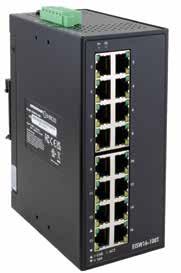
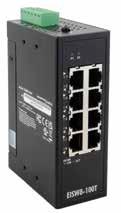

Learn more at www.ccontrols.com/eisw Providing Solutions to Your Automation Needs +1 630-963-7070 • info@ccontrols.com 5 Year Warranty
The EISW switch series provides the performance you need to expand Ethernet networks even in the most demanding environments. • Plug-and-play simplicity • 10/100 Mbps performance • Supports Auto-Negotiation and Auto-MDIX • Metal enclosure with DIN-rail or wall mounting • Wide operating temperature range of 40°C to +75°C • UL/cUL Listed, CE/UKCA Mark and TAA Compliant Available Now Industrial Edge
Deep learning, a subset of machine learning, on the other hand relies on complex patterns in the image versus set parameters. Deep learning matches the image to the outcome and uses large amounts of data to get more accurate. The advantage to deep learning is that it can be better at identifying variations of an issue that don’t conform to the typically identified parameters, which can contribute to greater accuracy and less manual work of identifying parameters. However, deep learning requires fast processing capabilities and a very large data set to be effective. Additionally, deep learning model problems are hard to troubleshoot since parameters aren’t manually controlled.
Focus on machine learning
Beydoun said that quality presents a significant opportunity for machine learning to be applied to existing vision systems. Machine learning for quality applications is particularly valuable when looking at hard use cases such as label printing errors and foreign material contamination in consumer-packaged goods or weld spatter than could indicate a durability concern on an automotive line. Additionally, for a chemical plant, algorithms can be implemented to optimize closed loops that ensure close adherence to set points regardless of external conditions.
Regardless of the application or industry, edge and cloud solutions share the same advanced, automated data processing that can help to improve operations. The value that edge and cloud analytics can provide to industrial automation offers a significant incentive to build out the proper automation infrastructure including properly designed network zones and conduits that separate out different automation areas with advanced switches to improve both network performance and security, data that is contextualized and ready for transport, and security to ensure that two way data transfer doesn’t allow a bad actor an easy opportunity to disrupt operations.
Challenges for automation engineers
Beydoun said that “unfortunately controls engineers don’t have the time to continuously revisit already implemented solutions. Additionally, operational excellence workers are already inundated with more projects than they can handle. Setting up processes to optimize themselves and to be able to handle new scenarios is a great advantage to lean organizations.”
Edge and cloud computing that can help identify quality issues are especially important as raw material inputs and feedstocks can vary and change slightly over time. A system that can adjust automatically to new information, even if the algorithm just identifies new
anomalies that a worker can then manually check to confirm whether there is an issue or not, can be the difference between a widespread recall or a few hours of downtime adjusting to a previously unknown or unidentified concern.
Data tracking and optimization through the edge and cloud can also be applied to maintenance concerns. Tracking the time to return of a pneumatic cylinder or the accuracy of a weld over time can help to identify when an automation device needs to be replaced on a more accurate schedule to reduce waste and downtime as well as to provide ample warning time to prepare for the changeover.
It’s important to start by making a plan for what optimization loops make sense to be created to solve existing business problems. This will help to identify the business returns that will help justify the investment required to prepare for the future. Ultimately, setting up a tiered PLC, edge, and cloud solution with multilayered security with ordered and identified data will make it possible for extremely fast processing at the edge and highly flexible analysis in the cloud to optimize production across a wide variety of parameters. Lightweight proven control networks such as EtherNet/IP that are working to provide contextualized data through data models like OPC UA and PA-DIM combined with defense in depth security solutions such as CIP Security device level security will help to enable this advanced architecture for the future.
System interoperability
Importance of openness and no proprietary technologies, interfaces or protocols.
“The essential key component to be able to successfully use edge and cloud computing in production in the manufacturing industry
is interoperability between the systems and the possibility to use desired applications on different targets,” said Daniel Korte, Technology Manager PLCnext Technology for Phoenix Contact Electronics GmbH in Bad Pyrmont, Germany.

“For this purpose, the systems used should use openness as the leading variable and no proprietary technologies, interfaces or protocols should be used. OCI containers and virtualization in general can be named as key technologies here as a basis for the use of applications that is as hardware-independent as possible. In addition, the deployment of these applications must function via standard mechanisms. Other key technologies and topics are security and real-time (cloud) communication through the use of TSN, e.g. Profinet via TSN,” Korte said.
Edge and cloud computing
Korte said that the major goal to be achieved by the joint use of edge and cloud computing is to obtain added value from data. This can be cost reductions as well as productivity increases or improved quality. Ultimately, there must be an economic benefit for the user.
Specifically, the use of edge computing is close to the data source, which leads to lower latencies and, in part, to better data protection, since the data is here in the local network. The user also has the issue of security directly in hand here. The edge devices are suitable for data (pre)processing, data buffers, data collection and the use of AI is also conceivable.
The cloud is, of course, ideal for storing and processing large amounts of data and for learning AI models. The cloud resources are scalable and available worldwide. The topic of security is also very important here but is usually solved directly by the cloud operator.
12 industrial ethernet book 07.2023
Industrial Edge SOURCE: PHOENIX CONTACT
With preinstalled software packages as well as universal graphical user interfaces and programming environments, the powerful hardware of the Edge PCs from Phoenix Contact enables simple development and implementation of edge applications.
Applications focus
“The specific applications for edge and cloud consulting in the industrial context are classic connectivity and data infrastructure applications. In edge computing, these include above all the brownfield connection of machines in order to leverage the added value of the data without exchanging the PLC or accessing the logic of the machine,” Korte added. “This is mainly about connectivity with data buffers and data pre-processing. Of course, new machines are also equipped with the possibilities of the Edge, here the applications can be executed both on a separate Edge Device and directly on the PLC, as in our case with PLCnext Technology.”
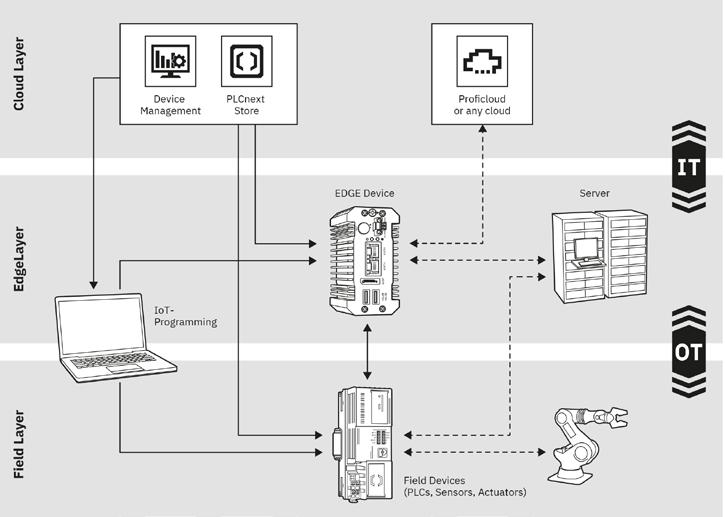
He said that the typical use cases of the cloud here are data visualization using dashboards and optimization of the machine. For optimization, both statistical methods and artificial intelligence can be used, e.g. for predictive maintenance or, as with Proficloud.io, predictive energy. In general, smart services play a major role here.
One of the greatest challenges for automation engineers is the convergence of information technology and operation technology. Here, the networks are growing together and it should be possible to access
and, if necessary, even influence the machine data by means of IT-typical standards. This poses a great challenge to classic automation technology, since a simple connection to IT systems is not readily possible here. However, this is crucial because the availability of data as well as cybersecurity are a basic requirement for the successful use of edge and cloud computing.
“The open architecture of PLCnext Technology makes it possible for automation engineers to either install edge applications on the Linux system or as OCI containers on their own, or simply use existing apps by leveraging the PLCnext Store. This is crucial as not everyone has in-depth Linux know-how. Thus, data availability is no longer a major challenge here,” Korte added.
Software-driven innovations
Standard IT solutions combined with sophisticated software algorithms.
Dr. Christopher Anhalt, Vice President Product Marketing, Softing Industrial Automation GmbH said that “nowadays, innovation in industrial production is software driven. For deeper process integration, more efficient
and more flexible production processes, and “smarter” products – software is usually key.” He said that it may help to distinguish two separate aspects of this situation. First, there are established software technologies, IT standards, proven products and services, which can help to build economies of scale. Cloud technologies fit that description. In some vertical markets, the adoption of cloud started much earlier than in industrial production. Currently, we observe how the industrial market segment is taking more and more advantage of standard IT and cloud, too.
Second, there is software-driven innovation which enables progress and new solutions, specifically for the industrial segment. Sophisticated algorithms for artificial intelligence and machine learning are examples that drive the development of new solutions for industrial production.
“It is the combination of both aspects, the potential of standard IT to build scalable and efficient solutions, plus the potential of sophisticated software algorithms to solve specific challenges in industrial production processes, which drives the increasing adoption of edge- and cloud technologies in the industry,” Anhalt said.
13 07.2023 industrial ethernet book
SOURCE: PHOENIX CONTACT Industrial Edge
Functionalities of the Edge PCs from Phoenix Contact.
Industrial edge and cloud computing
Anhalt said that, as outlined above, edge- and cloud computing goes hand in hand with economies of scale and the benefits that standard IT technology can bring to any industry. In particular, edge and cloud computing help to cut costs for IT infrastructure and for operation, independent of the specific software application and its benefits.
In this context, it is also worth noting –again not a technical benefit, strictly speaking, but still – that many edge and cloud computing solutions require limited investment. Software can be consumed as a service, with pay-per-use or consumption-based pricing models. This means there should be room for trial and error, as cost can be easily scaled up and down.
“Regarding technical benefits, it is the combination of edge and cloud computing which lets user take full advantage of software and innovative applications. For example, complex, AI based models for machine learning may require the computing power and resources of a central cloud platform. The result on the other hand can be deployed on edge, taking full advantage of reduced latency times,” Anhalt said.
Unique technology
When asked to provide a technical description of what makes this technology unique, and how it is being applied to industrial applications, Anhalt cited two examples. First, software
virtualization, which is a generic standard IT technology. Second, the enrichment of machine interfaces with semantic information, is a challenge that is more specific to industrial production environments.
“Software virtualization, the availability of software modules as so-called containers, means that software can be deployed largely independently from the hardware layer. The same software module can run on a simple IPC, on a rack server, or even on a central cloud platform,” Anhalt said. “Users can choose between standard software products to manage container-based software solutions. As a specialist in machine connectivity, Softing Industrial offers containerized software modules that can be used to implement machine connectivity for many applications. The software can be managed efficiently at the edge level through IT-driven operational concepts.”
Now, as for semantic information, machine data as it is made available by usual machineand device interfaces in brownfield projects, is unstructured. With new software solutions for edge and cloud, it is now possible to enrich such unstructured data with semantic information and to provide central governance for such mechanisms.
“Working with an interface that contains semantic information makes it easier for software developers to create their applications. The benefits are multiplied because such a semantic interface can be defined in a unified, abstract way. In this way,
multiple machines from different vendors or even multiple production sites look the same for software applications running on a central platform. The OPC UA standard and information models as defined by this standard play a major role in this context. R&D organizations are currently looking at how to apply AI to simplify the creation of information models and to map unstructured data into such models,” Anhalt said.
Industrial edge and cloud solutions
Speaking about edge and cloud applications requiring access to machine data, we have seen many PoCs and trials for quite a few years. But broader rollouts in production have remained slow or have not happened yet at all. So, on the application level in real-world projects, we still see the usual suspects that continue to dominate the discussion, rather than highly sophisticated applications taking full advantage of the latest developments in AI and machine learning.
As might be expected, energy management and related aspects of sustainability are relevant today. Predictive maintenance, tooling, and job scheduling are interesting for every company operating CNC machines. Basic dashboarding and OEE applications, to compare efficiency and performance between multiple production sites, for example, continue to offer benefits for many users.
As outlined above, edge and cloud computing addresses generic questions of IT infrastructure as well as the deployment of

14 industrial ethernet book 07.2023 Industrial Edge
SOURCE: SOFTING INDUSTRIAL
The containerized software modules from Softing Industrial edgeConnector Siemens, edge Connector Modbus, and edgeConnector 840D can be used to implement machine connectivity for many applications.
the most innovative software algorithms in a broad range of industrial applications. One could argue that there is hardly a challenge that automation engineers face which cannot be addressed by edge and cloud.

System interoperability
Importance of openness and no proprietary technologies, interfaces or protocols.
Marc Fischer, Global Marketing Manager Industrial Edge at Siemens said that, as more devices generate more data, the need for real-time processing, analysis, and actions directly next to the production or machine control becomes even more critical, making edge computing an attractive solution.
“Artificial intelligence and Machine Learning have been integral in providing the processing capabilities required to analyze the large volumes of data generated by IoT devices. These technologies provide benefits at production level / shop floor or even in the cloud. Low coding and ready-to-use frameworks and tools now also enable experts from the "traditional" automation world to use these technologies and thus generate a value
add,” Fischer said.
“Edge computing and cloud computing are the infrastructure to deploy and manage such applications. Moreover, virtualization is increasingly reaching the shop floor because software can be hosted much more flexibly, the administrative effort is reduced because much is centralized, and the computing power of virtualized and containerized infrastructures can be dynamically allocated and always assigned to those processes that currently need it.”
He added that cybersecurity is becoming increasingly important and computing power is becoming cheaper and can also be used on the shop floor for very compute-intensive processes. This also enables industries with very high IT security standards and sensitive data or critical processes to enable edge computing applications without a cloud connection and to keep all data and processes on-premises.
Potential impact on manufacturing
Fischer said that Industrial Edge brings IT computing power to the shop floor, providing flexibility to keep sensitive data locally or send pre-processed data to a centralized data center
or cloud server. This allows manufacturers to have full control over their data.
“It's particularly beneficial when low latency, high bandwidth, and data security are required. It can also facilitate the convergence of Operational Technology (OT) and Information Technology (IT) by enabling data transparency from the shop floor to the IT level. For instance, Siemens Industrial Edge is used to collect and combine data from different sources, closing the gap between the shop floor and the cloud, and enabling end-to-end vertical data integration,” he said.
Further advantages of Edge Computing with Siemens Industrial Edge: IT (analytics, AI/ML, etc.) is brought to the shop floor in a convenient and standardized way and running directly alongside automation, hence merging the two worlds of PLC programming and high-level language programming or low-coding for IT/OT convergence.
“You can also manage edge applications and associated software and hardware from a central location across machines, lines or even production sites, even worldwide. When productively rolling out these systems (we are talking about hundreds or thousands of edge
15 07.2023 industrial ethernet book Industrial Edge
SOURCE: SOFTING INDUSTRIAL
The Docker-based edgeConnector 840D connects SINUMERIK 840D controllers to industrial IoT applications.
PCs in case of doubt), significant savings can be achieved through economies of scale,” he added.
Distributed information technology
Edge computing is a distributed information technology architecture that brings data processing, analysis, and intelligence as close as possible to the endpoints that generate and use the data.
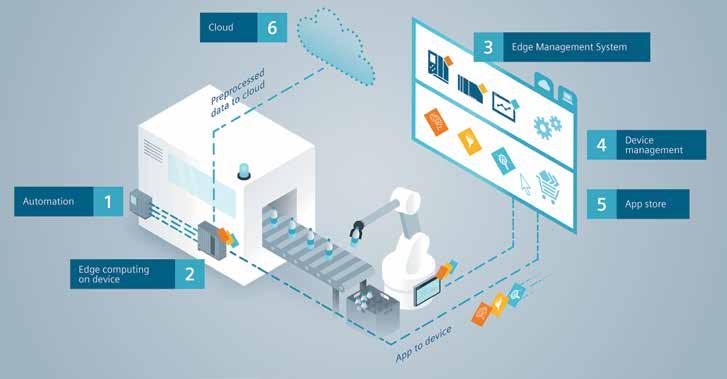
The key idea is to process the data at the "edge" of the network, near the source of the data, rather than sending the data to a centralized data processing warehouse. This architecture helps reduce latency, save bandwidth, and provide real-time or near-realtime data analysis and insights.
It also supports decentralization and security by enabling data to be processed and shopd locally, reducing the risk of data breaches and cyberattacks associated with data transmission. It's being applied in real-time monitoring and data analytics and control of industrial processes, predictive maintenance, and quality control, for example based on AI enabled vision applications. Cloud computing complements this by providing scalability and flexibility, enabling advanced analytics, and AI-powered decision making.
Fischer said that the latest Industrial Edge and Cloud solutions are targeting areas like predictive maintenance, real-time process control, and quality inspection. These solutions leverage IoT to connect devices and systems, creating a more integrated and intelligent manufacturing environment. The result is enhanced operational efficiency and productivity.
“It enables data collection from heterogeneous Shopfloor systems and various automation protocols (S7+, Ethernet/IP, SLMP, Modbus TCP, OPC UA, etc.) including standardization and processing of those –plus: buffering and storage in local data lake and even contextualization with semantic information. Then we talk about connectivity of those shopfloor data sets with upper-level systems such as production or company IT like SAP or MES systems but also cloud / IoT Platforms for further, global analysis. It is only sent to the cloud what’s needed there,” Fischer said.
Another example is analyzation of production data from controller, drives or sensors, etc. to create transparency via dashboards, identify anomalies to predict failures, or to optimize production process and quality of produced goods, e.g., through AI/ML enabled applications.
Finally, there’s a trend for virtualization, also of control systems and to run this combined with other edge computing applications on one single Edge platform and device (maybe also running centrally on a server within the production site).
Addressing challenges
There are several challenges that automation engineers face which edge computing and cloud computing can address. For instance, real-time data processing: automation systems often require rapid responses. Edge computing processes data at the source, significantly reducing latency and enabling faster decision making, which is crucial in many automation tasks.
Data overload: With the rise of IoT devices, automation systems generate large volumes of data. Edge computing can manage this by processing and filtering data at the source, sending only the necessary data to the cloud or central servers, saving bandwidth and storage costs.
Security and privacy concerns: Automation systems often deal with sensitive data. By processing and storing data locally, edge computing enhances data security and privacy, reducing the risk of data breaches and cyberattacks.
Operation technology and information technology are two different worlds: Starting an edge or IoT project, both stakeholder sides within a company need to work together with a clear target from day 1 on. OT experts want to benefit from values of the systems and need to consume the information in a convenient way, whereas the IT colleagues need to buy, install, and maintain software and maybe bring in high language programming expertise.
“There are many hurdles from proof-ofconcept to a productive roll-out,” Fischer said. “The overall system must comply with industry standards and components must work together smoothly, also in regard of maintenance. This is solved by ready-to-use and compatible hardware and software, i.e., from Siemens and third party and the possibility to integrate open source or own components into this system. Rolling out updates and configurations for up to thousands of apps and devices worldwide requires central tool and infrastructure for various applications, thus central management functionality.”
16 industrial ethernet book 07.2023 Industrial Edge
SOURCE: SIEMENS
Integrated computing and software environment from automation utilizing edge computing on devices to the cloud using preprocessed data.
System interoperability
Importance of openness and no proprietary technologies, interfaces or protocols.
According to Patricia Yancey Neimes, commercial portfolio manager for software and control at Rockwell Automation, the term ‘Industrial Internet of Things’ (IIoT) has been around for years and is synonymous with the widespread adoption of IoT devices in industrial settings.
With the ever-increasing need for datadriven solutions, IIoT is only accelerating. But it’s not the only thing that’s leading to the emergence of industrial edge and cloud technologies. Here are four more trends that are helping drive more efficient and intelligent industrial operations:
Edge compute: This trend is a companion to IoT devices in that it involves processing data near the source instead of sending it to a centralized data repository. The result? Faster processing, reduced network latency, and improved reliability. For a compute device, this means local control and real-time analytics.
Artificial intelligence (AI): Everywhere you turn these days, AI seems to be a topic of discussion. Although it hasn't been widely adopted in the industrial space, the possibilities seem endless – particularly in industrial operation and maintenance. Think of using this technology to analyze large amounts of data from edge devices (and even data in the cloud) to deliver insights and make real-time decisions. What about using that same data in a different way for predictive maintenance? And these are only 2 use cases! AI is here to stay; and we will continue to discover more ways it can be used to deliver optimized, intelligent operations.
Digital twins: Although digital twins aren’t necessarily a new concept, they are increasingly becoming part of the design lifecycle when it comes to industrial automation. As a digital replica of an asset or system, a digital twin provides a virtual model that can test, monitor, troubleshoot, and optimize your process even before the first bolt is ordered. Digital twins also enable concurrent workflows in the design lifecycle that ensure a solid design and support virtual training, whether at the edge or in the cloud.
Cybersecurity: Whether it’s your personal data or data from an industrial system, security is a topic that’s always top of mind. Connection and data exchange is at an all-time high and continues to grow. With that comes an ever-increasing need for resilient security measures. Cybersecurity is an evolving technology that’s critical for protecting data, network infrastructures, and assets from very real cyber threats that continue to attempt to undermine the integrity, privacy, and availability of industrial operations.
She said these are only a few of the trends
that are driving the rise of industrial edge and cloud technologies. Some more to think about include: the ever-increasing remote workforce, continued convergence of IT/OT, advanced analytics, robotics, and machine learning.
Potential impact on manufacturing
Kevin Olikara, consulting manager at Kalypso, a Rockwell Automation business, said that “cloud computing provides incredible scalability for data storage and compute resources, in addition to improved redundancy and resiliency. Manufacturing organizations can use cloud computing to collaboratively design and simulate complex industrial systems. In addition, these characteristics make cloud environments ideal as an industrial data hub to manage very large quantities of data, as well as a large variety of data types, including time-series data, events, and engineering data.”
“This helps manufacturing organizations get more value from the vast amounts of data they generate across many disciplines. With an industrial data hub as a foundation, cloud computing is ideal for building analytics applications used across the enterprise, as well as training AI models using those large data sets.”
Olikara said that edge computing provides much lower latency and connection resiliency compared to data being sent to and from the cloud. This is critical when deploying AI applications that process large quantities of data while also running synchronously with manufacturing systems and processes. Key examples of AI applications that need to run at the edge include advanced process control, automated vision inspection, and equipment failure prediction. When deployed successfully, these use cases provide step change improvements in productivity and quality to manufacturers.
“Industrial edge computing itself has been around for decades,” Olikara added. “What’s novel with the latest wave of technology is the convergence of IT and OT, resulting in edge to cloud architectures. Edge to cloud architectures leverage the best capabilities of both ends to enable highly integrated, closedloop workflows. Ultimately, this enables manufacturing organizations to leverage new IT capabilities while still meeting industrial specific requirements surrounding agility, reliability, and security.”
He said that the data flow starts with deploying data extractors and gateways, like FactoryTalk Edge Gateway, to the edge to ingest data from a very heterogeneous environment that employs many vendors and protocols. Then, a cloud-based industrial data hub, like FactoryTalk DataMosaix, can ingest and contextualize this data from previously disparate sources, providing easy but controlled access to this data by people and applications across the organization.
This data can be used by data scientists to build predictive and prescriptive machine learning models. Leveraging MLOps processes and systems, data scientists iterate and improve these models as more data is collected over time and manufacturing systems change. Edge applications can utilize machine learning models, which can then be deployed across many edge devices using an edge management and orchestration solution like FactoryTalk Edge Manager.
IoT and enterprise connectivity
Adam Gregory, software commercial leader at Rockwell Automation, said that Rockwell has been thinking about how to get the right tools into the hands of the right people based on what they need from an industrial automation platform.
“Over the last year, we’ve talked a lot about

17 07.2023 industrial ethernet book Industrial Edge
Edge devices are helping to merge the two worlds of PLC programming and high-level language programming or low-coding for IT/OT convergence.
SOURCE: SIEMENS
the FactoryTalk Design Hub, which is being built for system design, development, and deployment,” Gregory said. “Our main goals here are to enable collaboration across multiple users and skillsets, as well as on-demand access to compute-intensive applications like digital twins that provide controller emulation and system simulation. All of this is enabled by our use of the cloud, providing a single point of access for all collaborators, and the scalability of exactly the number of resources you need, when you need them.”
He added that, for people who are working directly with production systems, either creating product as operation engineers or keeping them running as maintenance engineers, we’re providing cloud solutions for production performance management with Plex and CMMS workflows with Fiix.
All these workflows benefit from the industrial edge, whether you’re connecting from the cloud to a device to deliver part of your project or gathering data from the production system to aggregate and communicate out to the cloud for advanced analytics. We recognize that the collection of production data, as well as safe and secure communication into and out of a production network is critical no matter how you fit into the industrial automation system.
Engineering challenges
Patricia Yancey Neimes said automation engineers are faced with more challenges than ever before. As automation continues to be adopted to improve productivity, reduce costs, and increase efficiency, engineers must navigate a complicated landscape of interoperability issues, complex infrastructures, and the ever-increasing pace of technological advancements.
Keeping abreast of these advancements while ensuring the security of operations is daunting enough, not to mention the ongoing pressure of delivering innovative products to customers. She added that are some other challenges facing today’s automation
engineers and how industrial edge and/or cloud solutions may help:

Data silos: Most automation systems are a constant work in progress. Ever-changing customer demands require new production workflows, which means looking for new ways to work smarter and faster. Sometimes that means adding new solutions to industrial operations which can introduce yet another hardware/software interface and data silo into the mix.
Heterogenous data environments with lots of different data types and sources are a reality in most production systems. The trick is to find a way to use the data at scale across many applications. Cloud-based solutions like FactoryTalk DataMosaix helps with this by providing simple access for complex data to automation engineers. This industrial DataOps solution takes data from different sources, contextualizes it, and delivers it to a range of applications across the organization.
Scalability/flexibility/agility: The need to respond to ever-changing requirements in industrial operations means this topic will continue to be something automation engineers will face for the foreseeable future. Ensuring these attributes throughout the operate and maintain lifecycle can be daunting, especially at the speed that business is happening today. The rise of edge devices has created unique challenges and complexities to manage these devices at scale. OT-focused edge management tools like FactoryTalk Edge Manager help automation engineers more efficiently manage edge devices and applications.
“In the design space, cloud-based tools make design teams scalable, agile, and flexible by allowing anytime, anywhere access via a web browser without the need to download, install, or activate software (think FactoryTalk Design Studio),” she added. “Additionally, simulation software, modeling applications and analysis/optimization tools can be accessed to make the design phase more agile and decrease time-to-market (think
FactoryTalk Twin Studio).”
Latency: Industrial automation systems often require real-time decision-making. Bringing computing resources closer to the edge minimizes the latency associated with sending data to a remote cloud or data center for processing. This reduced latency enables faster responsiveness and improves the overall performance of time-sensitive automation applications.
Cost: When trying to find solutions to challenges in the workplace, it always seems to come down to cost. When it comes the bottom line, industrial edge and cloud deliver distinct value:
Concerned about the potential capital expense of a cloud infrastructure and the related data transfer costs? Industrial edge delivers cost savings by processing and storing data locally. How? Through resource optimization and reduction in cloud services.
The cloud has its own set of related cost efficiencies. One example that comes to mind is that of creating a digital twin for a control system. Software that creates system models can be cost prohibitive – especially when one or both may only be used during the design process. Instead of making that investment, engineers can take advantage of cloud-based solutions like FactoryTalk Twin Studio that use a pay-as-you-go pricing model for compute power, storage, and services, avoiding capital expenses in favor of operational expenses.
Collaboration: Engineering teams are working remotely now more than ever. The rise of cloud technology has been key to making geographically dispersed teams a reality, supporting the ability to access shared resources and work simultaneously on the same project while using integrated version control to protect the integrity of the project.
“The challenges facing automation engineers today seem endless, but new and innovative edge and cloud solutions are making those challenges more manageable,” she added.
Al Presher, Editor, Industrial Ethernet Book
18 industrial ethernet book 07.2023
SOURCE: ISTOCK Industrial Edge
Industrial 5G is another key technology contributing to the development of edge and cloud computing solutions.
Emergence of edge and cloud computing enabled by IEC-62443
The adoption of IEC-62443 is set to play a crucial role in enabling digital manufacturing and will have a significant impact on the realization of Industrial IoT, leading to improvements in quality, output, and reduced downtimes.
INDUSTRIAL EDGE AND CLOUD COMPUTING offer a host of specific technical benefits that have the potential to significantly impact the manufacturing.
Philipp Jauch, Business Development Manager, Industrial Automation for Moxa Europe GmbH, explains how IEC-62443 plays a key role in enabling digital manufacturing along with addressing scalability and security challenges.
What are key technology trends that enabling the emergence of Industrial Edge and Cloud technologies?
The emergence of Industrial Edge and Cloud technologies is being driven by several key technology trends. One of the significant breakthroughs is the adoption of IEC-62443, which plays a crucial role in enabling digital manufacturing. Previously, the ISA-95, also known as the Automation Pyramid, was designed with a focus on security. Data was aggregated at each level and communicated between the levels above and below, following a functional approach. This rigid mode of communication, while secure, has been a bottleneck for digital manufacturing.
In the pursuit of easier data access, compromises on plant security were often made. However, IEC-62443 provides innovative ways to maintain security while simultaneously improving data accessibility and flexibility across all existing layers of the ISA-95. This includes facilitating horizontal communications with new devices and services implemented in the manufacturing process.
The implementation of IEC-62443 will have a significant impact on the realization of Industrial IoT, leading to improvements in quality, output, and reduced downtimes. By striking a balance between security and accessibility, this technology trend accelerates the integration of Industrial Edge and Cloud technologies, driving digital transformation in the manufacturing sector.
What are the specific technical benefits the industrial edge and cloud computing provides, and its potential impact on manufacturing?
Industrial edge and cloud computing offer specific technical benefits that have
The integration of edge and cloud computing creates innovative system architectures that create unique benefits for supervisory, control and process automation. One primary advantage is scalability. By leveraging industrial edge and cloud computing, manufacturers can achieve scalable solutions that adapt to their evolving needs.
the potential to significantly impact the manufacturing industry. However, there are challenges that need to be addressed to fully realize these benefits.
One of the primary advantages is scalability. By leveraging industrial edge and cloud computing, manufacturers can achieve scalable solutions that adapt to their evolving needs. This allows for efficient utilization of
resources and improved operational flexibility. Standardization is another key benefit. The adoption of technologies such as IEC-62443, OPC UA, and MQTT facilitates the establishment of secure industrial networks with proven designs. These standards enable seamless integration of logical connections throughout entire plants, reducing vendor lock-ins and promoting interoperability.
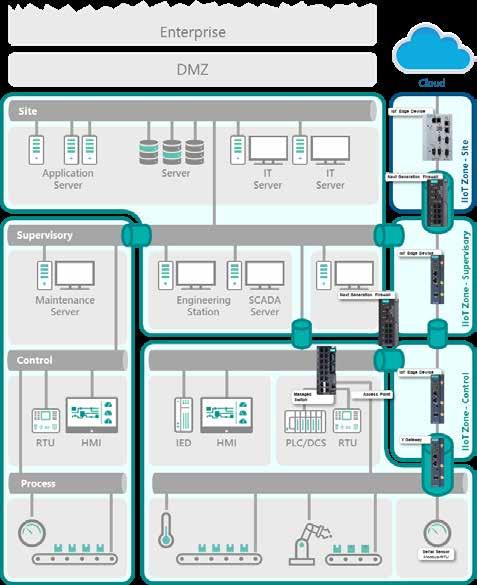
19 07.2023 industrial ethernet book Industrial Edge
SOURCE: MOXA
The utilization of smart and affordable industrial IoT gateways deployed close to the applications in the manufacturing environment, along with the use of new types of sensors, enhances data exchange and enables real-time monitoring and control. This improves overall efficiency, quality control, and predictive maintenance capabilities.
The impact of industrial edge and cloud computing on manufacturing is substantial. It enables manufacturers to access and analyse large volumes of data, leading to data-driven decision-making and process optimization. This, in turn, enhances productivity, reduces downtime, and improves product quality.
Furthermore, the adoption of these technologies opens new possibilities for collaboration and connectivity across the supply chain. Manufacturers can leverage cloud-based platforms to connect with suppliers, customers, and partners, fostering innovation, streamlining operations, and enabling faster time-to-market.
Provide readers a technical description on what makes this technology unique, and how it is being applied to industrial applications.
This technology's uniqueness lies in its establishment of the Industrial IoT zone and its application in industrial settings. The IIoT zone is created by identifying relevant assets and network connections. At its core is the IIoT gateway, serving as the primary asset and providing connectivity to the Internet during deployment.
A notable feature is the use of zero-touch provisioning for IIoT gateways. These gateways come pre-configured and are enrolled in the customer IoT Hub's allowed devices list. During physical installation, technicians simply connect power and LAN cables, and the devices automatically connect to the Cloud, receiving complete configuration details. Postinstallation, software modules within IoT Edge can be deployed and modified.
Once the IIoT gateways are Internetconnected, Cloud-based management becomes possible through Device Lifecycle Management (DLM), a vital aspect of modern IIoT infrastructure. Ideally, the IIoT zone should be established prior to gateway installation, involving a LAN port on a local switch with a VLAN routed to the Internet.
For multiple IIoT gateways in different network zones, like nested Edge Architecture, similar procedures establish conduits between the gateways/IIoT zones, permitting MQTT traffic exclusively. Southbound connectivity is set up, including the configuration of firewall rules, especially for Ethernet-based data sources.
In summary, this technology's uniqueness stems from its IIoT zone establishment and its
application in industrial settings. Zero-touch provisioning, Cloud-based management, and proper connectivity enable seamless integration and control of IIoT gateways, facilitating efficient data exchange and management in industrial applications.
What specific application areas are the newest Industrial Edge and Cloud solutions targeting? How are these solutions contributing to IoT and enterprise connectivity?
The newest Industrial Edge and Cloud solutions are targeting various application areas, contributing significantly to IoT and enterprise connectivity. These solutions address the need for secure connectivity between assets in different zones within the OT environment. By utilizing different types of conduits, such as industrial firewalls, VLANs, and IDS/IPS systems, the automation network management team establishes secure communication channels.
Industrial firewalls play a crucial role in controlling packet flow between devices on different ports. With granular configuration options, they enable specific types of packets to be allowed or prohibited, ensuring efficient communication. Additionally, next-generation firewalls inspect packet contents, providing fine-grained control over protocols and command types.
VLANs, when combined with firewalls, create isolated network segments. This allows for secure routing of communication between IIoT gateways and the Cloud, keeping IIoT traffic separate from other network traffic. This additional layer of security enhances the overall connectivity and protection of the system. Intrusion detection/prevention systems (IDS/IPS) go beyond controlling packet flow by monitoring network traffic for potential intrusion events. These systems detect patterns associated with known vulnerabilities or exploits. By utilizing IDS/ IPS systems, the automation team can connect devices that would typically be kept separate, reducing risk while maintaining security.
By incorporating these cutting-edge solutions, the automation network management team establishes secure connectivity in areas such as industrial automation, energy management, and smart infrastructure. These solutions contribute to the advancement of IoT and enterprise connectivity by enabling efficient and controlled communication, reducing risks, and ensuring the smooth operation of critical systems within the OT environment.
What are challenges that automation engineers face that these advances in edge computing and/or cloud computing addresses?
Automation engineers encounter various challenges when introducing new infrastructure, and the advancements in edge computing and cloud computing effectively address these challenges.
Productivity is a key concern in the OT environment, as uninterrupted operations and timely issue resolution are essential. To minimize disruptions during the integration of new IIoT zones and Edge infrastructure, careful planning, phased rollouts, thorough network assessments, parallel testing, and contingency plans are crucial. By ensuring a smooth transition and avoiding interruptions, productivity can be maintained, directly impacting financial losses.
Reliability becomes a significant concern when new devices interact with existing PLCs and Control Systems. Rigorous testing and validation processes are necessary to ensure compatibility, performance, and reliability. Conducting comprehensive tests, addressing conflicts or issues, and implementing backup systems or redundancy measures mitigate risks and promote reliable operation.
Safety always takes precedence in any changes made to the OT environment. Comprehensive risk assessments and safety measures are vital to identify potential risks associated with new devices or protocol changes. Regular review and updates of safety protocols and emergency response plans ensure timely responses to life-threatening situations.
Interoperability is a critical challenge in complex environments with diverse subsystems and data sources. Establishing a common operating environment using standard protocols, data models, and interfaces facilitates seamless integration with other systems, such as the Cloud or Edge infrastructures. By adopting industry standards and best practices, effective communication and efficient data sharing can be achieved, enhancing overall system efficiency.
By addressing these challenges related to productivity, reliability, safety, and interoperability, the advances in edge computing and cloud computing enable automation engineers to successfully introduce new infrastructure while maintaining optimal OT operations.
Learn More
• Moxa Launches World's First Industrial Computer With IEC 62443-4-2 Host Device Certification
• View Product News Item on page 64.
20 industrial ethernet book 07.2023 Industrial Edge
Philipp Jauch, Business Development Manager, Industrial Automation, Moxa Europe GmbH.
New Product from Moxa
Machine connectivity and industrial edge computing

Software and IT innovation are the primary drivers for manufacturing investment. Solution architectures are expected to consolidate around specific standards, with architectural blueprints and best practices addressing end-user needs. Edge computing will also show accelerated deployment within manufacturing.
EDGE COMPUTING IS THE NEXT BIG THING FOR manufacturing. After providing a definition of “edge” itself, this article goes on to describe the current technological advances and market development for industrial edge computing, paying special attention to the interplay of machine connectivity and edge, as well as questions of operating models and the scalability of industrial IoT solutions.
What is edge computing?
In the context of manufacturing, we propose the following definition to distinguish “edge” from “on-premises” on the one hand and, on the other, to avoid treating “edge” as if it were merely an add-on for cloud platforms: accordingly, edge computing describes a system of decentralized edge nodes that are located close to a physical data source.
These edge nodes are connected both to devices and to a central platform (such as a
cloud). Unlike components on the production asset level, edge nodes can be managed centrally, with the processing of the data collected either being handled within the edge node or by the central platform.
The edge level can be viewed from a number of perspectives. While an application perspective describes software applications and their functions (e.g. data pre-processing, data bus, etc.), an infrastructure perspective describes the IT infrastructure deployed (including hardware and operating systems), and an operating perspective describes tools with which edge levels can be managed and administrated (e.g. monitoring tools or tools for handling multi-site software rollouts).
Arguments for why edge computing is relevant for Industrial IoT applications are well-known. Some applications require very short latencies that are unlikely to be maintained by communicating with a
centralized cloud platform. Data volumes are also very high in some cases, requiring extensive pre-processing at the edge level as a minimum. Last but not least, regulatory conditions apply to some industries’ applications – and these regulations prevent data from ever leaving the company network.
Architectural trends
Customers wanting to set up and operate an Industrial IoT solution need to look at many issues, and one of the most important is the question of a suitable system architecture. As of now, there is a trend towards the consolidation of Industrial IoT architectures, which is characterized in part by the following edge level aspects and properties:
• Customers are deploying cloud platforms but want to minimize the edge level’s technological dependencies on the cloud while avoiding vendor lock-in.
21 07.2023 industrial ethernet book Industrial Edge
SOURCE: SOFTING INDUSTRIAL/SHUTTERSTOCK
Edge computing describes a system of decentralized edge nodes located close to a physical data source. Edge node connect both to devices and to a central platform and can be managed centrally with the processing of the data collected either being handled within the edge node or central platform.
• Customers are splitting the edge level into two – a factory floor level underneath plus a top level with central platform/cloud connectivity – and both managed centrally.
• Customers are deploying an MQTT broker at the edge level as a central hub for data traffic. Data are streamed with MQTT or Kafka toward the central platform while applications that are run locally can be accessed via the MQTT broker. So how do these architectural trends and edge relate to machine connectivity?
Scalable machine connectivity
Efficient and secure access to machine or device data is a fundamental requirement for Industrial IoT applications. In terms of functionality, or the application perspective, these machine connectivity demands are virtually identical to those required by traditional shopfloor applications.
The typical devices built into plants or to be handled by brownfield projects – controls, first and foremost – need to be integrated. The collected data must be provided using standard protocols with application-side support, which usually means OPC UA or MQTT. Also important are functions that permit the efficient handling of multiple data sources, such as the consolidation of data or data sources into a single interface (server aggregation).

Looking at suitable operating models reveals more significant differences between traditional shopfloor applications and Industrial IoT solutions.
Deployed and operated locally at a production facility, traditional applications plus machine connectivity will feature an HMI or SCADA system, for example, MES solutions, or a database link with the aim of ensuring data backups. Machine connectivity users are typically non-specialists and therefore require IT interfaces that are as simple to use as possible. Low-maintenance solutions are required, which usually remain unchanged after initial commissioning.
In contrast, Industrial IoT solutions characteristically involve applications or an IoT/cloud platform being deployed across multiple production sites. Not only does the platform run several applications rather than just the one, but these applications evolve over the solution lifetime, with one key driver of this change being the short innovation cycles in software and IT. Dedicated teams are deployed to run the solution: these employees are assigned multi-site responsibilities and have extensive IT know-how. Customers are looking to utilize IT-driven operating models and their associated benefits in terms of solution efficiency and scalability (in other words: the platform + edge level of the solution as outlined above).
As with other solution components, machine connectivity needs to meet the same requirements for flexibility, operating efficiency and scalability. Increasingly, customers are no longer viewing machine connectivity in the context of the Industrial IoT solution as a production asset, but as an edge level component, with all of its
associated advantages in terms of efficiency and scalability.
Machine connectivity part of edge
So if machine connectivity is to be deployed as part of the edge level, which requirements then need to be met? The following are some of the key aspects here:
• Machine connectivity is provided with software modules that are deployed on standard hardware and managed by end customers in exactly the same way as for other edge-level software components. Docker containers are now a common choice here.
• Machine connectivity can be managed by standard IT tools. Often, this will involve popular Kubernetes-based platforms like RedHat OpenShift or Suse Rancher, but leaner alternatives such as Portainer may also be used.
• Machine connectivity supplies relevant data to popular IT monitoring tools such as Prometheus and Grafana.
• Machine connectivity provides documented, stable interfaces for configuration that make use of standard protocols – whether remote, automated, or both (e.g. http REST).
Alongside these technical requirements, customers also have an increasing interest in utilizing machine connectivity as a service, looking for flexible fee schedules that reflect actual need (and benefits) without requiring capital expenditure or investment in equipment.
22 industrial ethernet book 07.2023
SOURCE: SOFTING INDUSTRIAL Industrial Edge
The three levels of the Industrial IoT solution: production assets, edge and central platform.
Solutions from Softing
As a specialist for industrial communication and automation, products for machine and device connectivity have been part of the Softing Industrial Automation GmbH portfolio for many years. Softing Industrial has been tracking the trend toward software virtualization and edge computing for a while now, and used SPS 2018 as the occasion to launch the first commercially available Docker container for machine connectivity, with its software module for connecting to Siemens controls – the edgeConnector Siemens.
Since then, the company’s portfolio has grown to include eight Docker containers for machine connectivity, including two variants specially designed for Siemens Industrial Edge, with other products now in development or on the roadmap.

These products meet typical requirements for PLC connectivity in brownfield projects. In addition, the company’s edgeAggregator product offers OPC UA-based server aggregation plus additional IT security functions, making it especially suited to deployment in innovative industrial IoT solutions.
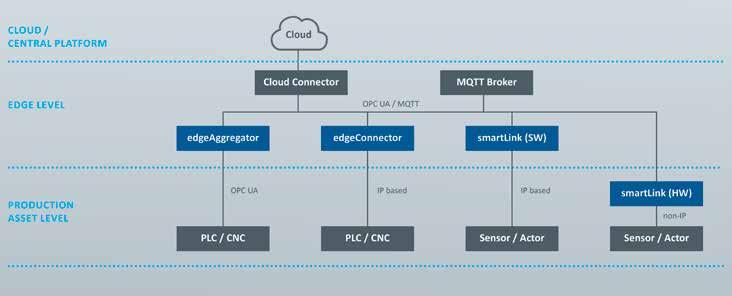
Also in relation to server aggregation, the use of OPC UA information models for interface abstraction is now an increasingly important topic in this field. These information models can either be deployed at the shopfloor level, for one or a few controls, or can be integrated at a higher, facility-based level to present different sites as a homogeneous entity from the perspective of a central platform.
Softing Industrial now offers initial functionality for implementing these requirements and scenarios, with other functions in the pipeline.
Outlook
For the foreseeable future, software and IT innovation will remain the primary driver for manufacturing investment. Solution architectures are expected to show further consolidation around specific standards, with architectural blueprints and best practices offering simpler approaches to addressing end-user needs. Edge computing will also show accelerated deployment within manufacturing.
For Softing Industrial it is interesting to see that customers are starting to show look into IT-driven operating models for machine connectivity, even though the solution context is still conventional and does not feature Industrial IoT aspects. Over the medium to long term, however, this trend will strengthen, with IT standards and tools then finding increased acceptance at the shopfloor level and within OT. In time, this will render obsolete the distinction made in this article between conventional and Industrial IoT solutions – at least in terms of machine connectivity.
Dr. Christopher
Vice President Product Marketing, Softing Industrial Automation
Learn More
23 07.2023 industrial ethernet book
Anhalt,
GmbH.
Softing products for integrating machine connectivity into the edge level of an Industrial IoT solution.
Softing customers are starting to show look into IT-driven operating models for machine connectivity, even though the solution context is still conventional and does not feature Industrial IoT aspects.
SOURCE: SOFTOCK
SOURCE: SOFTING INDUSTRIAL Industrial Edge
Intelligent gateways for manufacturing in the digital era
As industrial sectors face ongoing pressure to increase productivity, enterprises may from time to time reach seemingly unsurpassable limits of their technical capabilities. For many, digitalizing the manufacturing process can provide a suitable solution.

BENEFITS AT MULTIPLE LEVELS CAN BE obtained by centralizing the collection of accurate data directly from production systems, its transmission, and subsequent processing. Digitalization helps to integrate enterprise-wide operations, optimize the manufacturing process, and facilitate the work of operators, maintenance staff, planners, programmers, quality assurance officers, and management.
Switching to automated data collection often requires an extensive upgrade of production lines, which translates into a costly replacement of machinery and technologies. However, unless absolutely necessary, older production machines that function in a problem-free manner do not need to be completely replaced – they can simply be fitted with components that add complementary functions for a fraction of the cost. In this way, the modernization process can be very gradual, spontaneous, and accurately correspond to current needs. Siemens offers an extensive range of
products that can considerably simplify this process by creating customized solutions.
Case in point
One of the many who have embarked on the path to digital transformation is Trivium Packaging Czech Republic s.r.o. The company has taken the first steps toward enterprisewide data monitoring in its Skrivany metalworking plant in the Hradec Králové region, Czech Republic.
About Trivium Packaging
The objective was to integrate formerly separately operated machinery and production lines into a centralized system, which would use a single server to collect manufacturing data with to the aim of improving productivity. The cutting shop, the paint shop, and the lid production line were selected for the initial deployment of digitalization. These facilities are of key importance to the plant's operations. One of the most demanding challenges was posed by the different ages of
Trivium Packaging produces light metal packaging for food and technical applications. The company has three plants in the Czech Republic – in Teplice, Znojmo, and Skrivany. The Skrivany plant specializes in manufacturing metal lids, a sector in which the facility has a long tradition. Its beginnings in manufacturing metal packaging date back to 1977, when the Strojobal Factory was built on a site formerly occupied by a sugar refinery. The company has changed name and owners on several occasions since then, but the production of metal packaging has continued without interruption. In 2019, the plant became a member of the multinational operations of Trivium Packaging.
24 industrial ethernet book 07.2023
Major market segments illustrate the areas where Ethernet technology continues to make a major impact on the world of networking and computing.
SOURCE: SIEMENS
Industrial Edge
the machines, production lines, and deployed technologies. "The production lines needed to be connected to the network, but there was no communication infrastructure between individual machines. Individual groups of production lines differed from one another and contained components of different ages," explains Trivia Packaging technical consultant David Capek. Some of the machines were fitted with the proven Simatic S7-300 control system that only features a Profibus DP interface. These units had an MPI interface only. The more recently installed lines were equipped with Ethernet, but they had not been assigned unique IP addresses, and it was not possible to furnish them with a communications processor or to connect them to the network without completely reassigning their addresses. Following an assessment of available options, David Capek selected technology offered by Siemens as the most suitable solution.
Digitalization of metalworking
Siemens proposed an innovative solution consisting of integrating all of the company's machinery and production lines using the intelligent gateway Simatic CloudConnect 7 (Simatic CC716). This technology provides the option for future communication via the OPC UA protocol. In addition, it supports relatively outdated PLCs equipped only with a Profibus DP or MPI interface. The OPC UA (Open Platform Communications – Unified Architecture) protocol is the current standard in production automation digitalization. It can be found in all new units of the Simatic S7-1500 type. The Simatic S7-1500 PLC, operating as an OPC UA client, first reads data from Simatic CC716 units and subsequently forwards it to the TLM (Trivium Line Monitoring) central enterprise system, which makes data available to Trivium Packaging plants worldwide. An additional benefit of this solution is the fact that the previously fully separate machinery and production lines can be easily programmed, monitored, and diagnosed centrally from any place in the production facility. In this way, the client has obtained the necessary functions, even though the original request related to data collection only. This goal could be achieved by taking advantage of application support from Siemens' experts who helped the client's management develop their conceptual approach and provided advice on subsequent component configuration. Installation and commissioning were carried out by David apek with the assistance of Trivium Packaging automation specialist and programmer Miroslav Frýba.
Under the hood of the deployed technologies
As part of the project, it was necessary to physically interconnect production machinery in order to lay the foundation for the future
backbone network using Scalance XC216 Industrial Ethernet switches. With 16 ports, these units have sufficient capacity for the connection of other components. Machines with duplicate addresses were connected by means of Scalance S615 NAT routers, which convert data from the internal to the external network using a unique address. In addition, they incorporate a hardware firewall to prevent unauthorized access and to ensure that communication takes place only between predefined IP addresses. Individual routers were configured to permit communication via predefined nodes only. This approach also allowed the newly built network to be spontaneously divided into microsegments.
The oldest PLC production lines with a Profibus DP or MPI interface were connected
using Simatic CC716, a component developed for this specific purpose. Simatic CloudConnect 7 is an intelligent communication gateway, which also functions as an OPC UA server that converts the outdated, unsecured Put/Get communication protocol to the current OPC UA standard, which provides data to clients over the standard Industrial Ethernet network. The Simatic S7-1500 control system was deployed as an OPC UA client. The system supports not only OPC UA, but also S7 communication with other machines in subnetworks, downstream from NAT routers. OPC UA is currently the most in-demand communication technology for new machinery and production lines because it can be configured to operate in a secure mode, a highly significant feature in light of the constantly growing demands on industrial

25 07.2023 industrial ethernet book
SOURCE: SIEMENS
Industrial Edge
The Simatic CC716 industrial IoT gateway supports connection via Industrial Ethernet or the Profibus/MPI interface.
cybersecurity. This technology is based on the client/server architecture. Its popularity stems from the availability of a wide range of components owing to the large number of manufacturers supporting the technology.
The option to install this communication device on older Simatic S7-300 and Simatic ET200S CPU automated systems, including units fitted with a Profibus DP or MPI interface, is of fundamental importance.
Incalculable value of accurate data
Trivia Packaging technology experts, aided by Siemens specialists, succeeded in centralizing data from machines that were previously completely separate, with practically no
Highlights of the solution
modification of the existing interface software. Thanks to the Simatic CC716 and Scalance S615 units, even the oldest parts of the machinery were connected to the digital network without the need for costly replacement of entire machines. Moreover, the high security standard was maintained.
The client's production systems in the manufacturing facility are now centrally monitored, and the deployed solution provides a springboard for further improving productivity. "Until recently, the output from production lines was recorded on paper or using simple databases. Now, data is collected automatically. It is a simpler and more efficient method that allows operators to
• Reliable collection of accurate data uninhibited by the human factor
• Monitoring of the speed and output of production machinery and time needed for reconfiguration for a different production purpose
• Shorter downtimes and lower product defect rates
• Easy programming, monitoring, and diagnostics from any point in the production facility

• Simple identification of the causes of defects in machinery resulting in better serviceability
• More efficient management of the manufacturing process
• Higher productivity and process efficiency
• High level of security
focus on their work. The system monitors the speed of production machines, their output, the quantity of defective products, and the time needed to reconfigure manufacturing machinery for a different purpose," explains David Grzywacz, Industrial Engineer responsible for monitoring TLM production lines in the Skrivany plant.
"The key is to have data available, if possible, free of human error and to have certainty that the data is highly accurate," says Maintenance Manager Jaroslav Morávek, adding, "the system allows authorized personnel to have online access to information on the operation of production machinery and to verify that it functions correctly. This translates into numerous advantages. The amount of paperwork has been reduced, reports were simplified, defects can be more easily resolved, the management of the manufacturing process was fine-tuned, productivity has improved on the whole, and further improvements can be made in the future."
The integration of processes and collection of data have been highly beneficial for diagnostics because they have improved the serviceability of production lines due to the fact that online monitoring facilitates identification of the actual problematic unit. "The system also collects error messages, allowing the maintenance crew to deal
26 industrial ethernet book 07.2023
SOURCE:
Industrial Edge
Operators can monitor data via a practical dashboard.
SIEMENS
with defects immediately and to pay closer attention to recurring problems. Another big advantage is connection over the current Wi-Fi network, meaning that no cables need to be installed in our large production buildings," adds Capek.
Easy component replacement
One of the new system's major benefits is the fact that network components can be easily replaced. All Scalance XC216, Scalance S615, and Simatic CloudConnect 7 components are fitted with a C-Plug or a CLP Plug (Configuration License Plug) to ensure that parameters are retained. In the event of a defect, C-Plug
preserves the set configuration, including, where applicable, the firmware, allowing the defective module to simply be replaced on a unit-for-unit basis, where replacement can be performed on site by operators possessing no more than a general knowledge of the system.
"Our plant operates around the clock. Night and weekend shifts have to make do without IT support, which could mean a shutdown for as long as 24 hours in the event of a defect. A defective module of this kind, however, can simply be replaced by a worker possessing basic training. All that needs to be done is to install the new unit, replace the card, and disconnect and reconnect a handful of
connectors. All in all, it takes no more than a few minutes. This is an enormous benefit that provides huge savings," says Morávek in praise of the new system.


Plant supervision from home
A peek into the future reveals promising ways of using the Sinema Remote Connect remote network administration platform. A Key-Plug has been added to the Scalance S615 component, which allows the device to be connected to Sinema Remote Connect. It means that, in the event of a failure in the manufacturing process, a diagnostics specialist or another expert can connect to the system, essentially instantaneously and from any location, to resolve the problem. That would translate into major reductions in downtimes and logistics costs. Access to a specific machine would be provided via a central point, subject to a guaranteed high level of security. This solution is currently under discussion, but Jaroslav Morávek is dedicated to working together with Siemens to push the current limits of Trivium Packaging plants even further.
Digitalization has proved to be the right choice for the Skrivany facility, and the plan is to connect all remaining production lines to the network in the future. The successful concept can therefore be replicated as a model solution at other Trivium Packaging plants in Teplice, Znojmo, and outside the Czech Republic.
More 27 07.2023 industrial ethernet book
Vladimír Ševcík, Product Manager, Siemens.
Learn
SOURCE: SIEMENS
Convenient configuration of data points (from PLC to an OPC UA server) via a Simatic CC716 web server module with no need to change hardware configuration in Step 7.
The Scalance S615 NAT router converts data from the internal network to the external network.
Industrial Edge
SOURCE: SIEMENS
Securing industrial automation systems using IEC 62443-4-2
IEC 62443-4-2 host devices are independently evaluated and provide a secure-by-design open platform for industrial automation systems. Installing IIoT software and applications on these host devices creates an IIoT edge computing gateway that meets the industry’s gold standard for cybersecurity.
BUILDING INDUSTRIAL AUTOMATION SYSTEMS from numerous components supplied by different vendors is no small feat. Ensuring that each individual component that goes into a system, as well as the system overall is secure, can make a challenging task more painful. IEC 62443-4-2 certification for highly customizable host devices ensures your open edge computing platform is secure by design.
Large industrial enterprises, system integrators, and independent software vendors all have their own unique pain points when it comes to constructing an industrial automation system. This article discusses the particular security challenges these stakeholders face and recommends specific best practices for adopting IEC 62443-4-2 host devices as secure IIoT edge computing gateways for industrial automation systems.

Secure edge computing environment
As the saying goes, “a chain is only as strong as the weakest link.” Taking a holistic approach to making industrial automation systems secure and reliable is essential to ensuring no weak links exist in missioncritical applications. As protocols, standards,
and equipment must work seamlessly together to deliver the desired results and return on investment, overcoming discrete pain points has become major job duties for industrial automation system managers. One pain point is securing the system throughout its lifecycle. From planning to deployment, maintenance and performing upgrades, a typical automation system requires that all interconnected controls, sensors, machines, processors, and networks reach exacting security standards to maintain system integrity.
As the industrial automation and control field moves toward distributed computing, computation and data storage are located much closer to the sources of data. As such, edge computing benefits from making processing and decision-making more responsive to timesensitive and/or location-sensitive requests. Thanks to its proximity to field sensors and control, it can also enable real-time, low-latency processing of data and virtually instant decision-making. As computing is performed on edge host devices, built-in safeguards at every level are critical to system security and integrity. While each system component has separate security standards
that protect it from intrusions, attacks, and breaches, it is equally important that systemwide security standards and frameworks offer the same trusted level of protection to the edge computing environment and industrial automation and control applications.
IEC 62443 certification has become the universally recognized go-to standard for industrial automation and control systems. Part 4 of IEC 62443 contains two categories of accreditation on product standards, namely, IEC 62443-4-1 and IEC 62443-4-2. Product manufacturers must first pass the IEC 62443-4-1 accreditation, which covers the product development requirements, in order to be eligible for proceeding to IEC 62443-4-2 certification, which covers technical security requirements for industrial automation and control system components, including embedded devices, network devices, software applications, and host devices.
IEC 62443-4-2 host device standards ensure that the entire platform—hardware and operating system—meet the security requirements throughout the system’s life cycle. IEC 62443-4-2 certification’s rigorous technical requirements are highly sought
28 industrial ethernet book 07.2023
SOURCE: MOXA
Industrial Edge
after as the IoT continues to make inroads into optimizing industrial automation and control operations and are expected to become mandatory in many countries to promote productivity, efficiency, and resilience for production lines and critical infrastructure.
Why 62443-4-2 host devices?
The deployment of IIoT software on host devices creates an IIoT edge computing gateway that connects industrial automation and control systems to the cloud, so it requires a heightened focus on the security of both the network and edge devices to guarantee secure data transmission. A security-enabled host device is crucial to safeguard the IIoT software deployed on it. When a host device—hardware and software—has been tested and validated to meet IEC 62443 security standards, it reduces the manpower, time, and resources required from OT system integrators, asset owners or managers to validate the security of the device before deploying their IIoT software. As expansive and distributed IIoT systems are becoming commonplace in a variety of outdoor or indoor edge computing applications, host devices such as industrial computers are also designed to be rugged to withstand harsh environments and secure to protect themselves from cyberthreats or tampering.
IT or R&D in industrial enterprises
Large industrial enterprises boast large or multiple IIoT systems to perform different tasks. Different hardware and software components have varying security capabilities. Without a set of common security standards, the burden of testing and validating each component falls on the personnel integrating or operating the system, and the cost and time are borne by the asset owners or end users. Therefore, the benefits of IEC 62443 certification for edge computing devices are obvious. It also allows for easy product selection as certified products demonstrate compliance with the rigorous security standards demanded by IIoT systems of today and tomorrow.
In addition, large industrial enterprises face operational challenges that demand a higher level of built-in security. The first challenge is securing the actual edge computing host devices that run the operating system and software applications for the IIoT system. Although IEC 62443-4 certification for host devices has been available for several years, most suppliers only offered certified embedded and network devices. Host devices have typically been open platforms that allow customers to freely configure settings and install additional applications. As a result, ensuring the security of host devices is a significant challenge. In January 2023, the world’s first IEC 62443-4-2 certificate was awarded to an industrial computer—Moxa’s UC-8200 Series, which closed an important
market and product gap in the OT field.
The next challenge of OT systems in large industrial enterprises is deployment of devices in remote locations. IIoT gateways are more vulnerable to tampering or other physical security breaches when they are deployed in unattended or remote areas. Physical security apparatuses, such as barriers or casing secured by locks alone, might not be enough.
Moreover, in remote locations, connectivity to the cloud and network availability may be limited. Oftentimes, the only available network is LTE and is less secure than wired connections. Widely recognized as the most rigorous security standards to date, having IEC 62443-4 certification for edge computing devices adds another layer of security when physical security and wireless connectivity are used for remote or unattended deployments.
Lastly, unlike IT systems, OT system components generally have longer life cycles, and IIoT applications are no exceptions. IEC 62443-4 certification is designed to cover the IIoT system’s entire life span, often outlasting the life cycles of individual components. When OT professionals choose host devices to connect the IIoT systems to the cloud, they naturally choose products that are built to last, and security certification standards should also go along with the products’ longevity.
System integrators
System integrators may face the technical challenges seen in large industrial enterprises. Although IEC 62443-4-2 certification ensures the security of individual components that compose a system, it is also important to consider IEC 62443-3-3 certification, which ensures the overall system's security. A highly customizable yet secure industrial computer certified by IEC 62443-4-2 can be a solution for constructing secure system components. Additionally, system integrators are often responsible for maintaining IIoT systems, and IEC 62443-4 certified devices can contribute to enhanced stability in the long run. In the event of a failure or downtime, these devices can be swiftly recovered, enabling applications to get back online and operate effectively.
Independent software vendors
Independent software vendors have expertise in application deployment, development, and security, but may have limited knowledge and experience in hardware and operating system security. As such, in their professional line of work, they may benefit from falling back on IEC 62443-4 certification as it is the latest go-to set of standards for securing edge computing devices. When they engage in development at the application level, they will know hardware and operating system security are taken care of if the industrial computer they are deploying their application on is IEC 62443-4-2-certified.
Best practices for IACS security
IEC 62443-4-2 certifies that host devices (as well as embedded devices and network devices) are secure-by-design. Choosing IEC 62443-4-2 host devices for your edge computing platform in an entire system that meets IEC 62443-3-3 requirements can ensure that the entire industrial automation system is also secure. These certifications save OT professionals from spending valuable time and resources on manual testing of individual components, and also ensure that each link in the chain is as secure and strong as it could be.
The world’s first IEC 62443-4-2 certificate for a host device was obtained by Moxa’s UC-8200 Series Arm-based computers. It was developed according to IEC 62443-4-1 standards and is compliant with IEC 624433-4-2 industrial cybersecurity Level 2 standards. Running on an Industrial Linux 3.0 (MIL3) platform, the UC-8200 features a suite of secure-by-design hardware and software to protect data and infrastructure from cyberthreats.
The UC-8200 certified platform addresses the demand for IIoT system security, as distributed computing requires superior connectivity and network management to protect against DOS attacks and vulnerabilities. It optimizes LAN and WAN availability by automatically switching between Ethernet, Wi-Fi, and LTE connections, which can minimize downtime. Its automatic system failover allows for speedy system recovery.
The MIL3 platform comes equipped with quick backup and restore utilities, as well as automated system recovery features based on an overlay filesystem architecture. This helps to reduce downtime in the event of a security breach, process failure, and file corruption, such as in the case of a power outage during a critical update.
Designed with security in mind, UC-8200 computer incorporates a one-time programmable (OTP) fuse and Trusted Platform Module (TPM) 2.0 technology to establish a hardware-based chain of trust that safeguards the Secure Boot process and software updates. This blocks hackers from taking control of the device during boot time and prevents malicious updates from being used for malware exploitation.
Summary
A chain is only as strong as its weakest link. That is why it is so crucial to ensure that each component within the entire industrial automation system is secure. Large enterprises, system integrators, and independent software vendors can all rest assured that host devices independently certified by IEC meet the security requirements their applications demand.
George Y Hsiao, Product Manager, Moxa IPC Business.
29 07.2023 industrial ethernet book
Industrial Edge
Learn More
Edge computing set to revolutionize manufacturing

Edge software platforms can be a critical enabler of data-driven automation solutions. They abstract Operations Technology (OT) systems and provide the required interoperability across edge and IT/cloud processes within a smart factory.
THE
USE
OF EDGE COMPUTING IN FACTORY
and plant environments is not new. The use of programmable logic controllers (PLCs), microcontrollers, servers and PCs for local data processing or even micro data centers are edge technologies and have been used for decades in factory and plant systems.
What has changed is the emergence of the IoT, Industry 4.0, advances in AI/ML and new standards focused on plant and factory automation. All these are converging to support the digital transformation of operations across industrial manufacturing. In this context, a new generation of edge computing solutions are set to revolutionize the industrial plant and automation markets.
This transformation in manufacturing operations is set to accelerate significantly in a post pandemic world. Recent market data (source: Fictiv and Dimensional Research) on the intentions of manufacturing companies
to digitize their factories suggests that 91 percent of organizations have increased their digital transformation investments. Edge computing is playing a pivotal role in a new generation of smart factories by enabling the integration of both operational technology (OT) and information technology (IT)/cloud processes across an organization.
It’s also allowing manufacturers to be able to conduct intelligent operations much closer to the sources of the data and where the people and machines operate. Edge computing is also enabling new data driven use cases that can leverage real-time “fusion” of data from both legacy OT systems and the rapidly increasing sources of actionable industrial data.
Software-defined Automation
One of biggest changes that industrial plant and automation systems are undergoing is the move away from the use of hardware-centric
(e.g. PLC) technologies with relatively limited software capabilities. Traditional automation solutions tend to have a single dedicated function and their data siloed from other parts of the system.
These solutions are difficult to extend to support new use cases/functions and very expensive to replace. Manufacturing companies are pushing for greater flexibility that can be gained from more open and software configurable solutions to better meet both their current and future requirements as they digitize their factories.
Edge computing is enabling a new generation of automation systems that are starting to replace traditional hardware centric edge systems with new “software defined” edge solutions. These new systems can utilize commodity hardware (IPC and server technologies) and commercial operating systems (e.g. Linux) technology to replace
30 industrial ethernet book 07.2023
SOURCE: IO
TECH
Industrial Edge
The need for more flexible and open industrial plant and automation systems--combined with the emergence of the IoT, Industry 4.0, advances in AI/ML--is driving the adoption of a new generation of edge computing solutions.
traditional PLC and PACs.
The new generation of edge computing solutions are bringing many of the benefits of cloud computing such as containerization and virtualization. These solutions also deliver modern approaches to application orchestration and updating to the OT world.
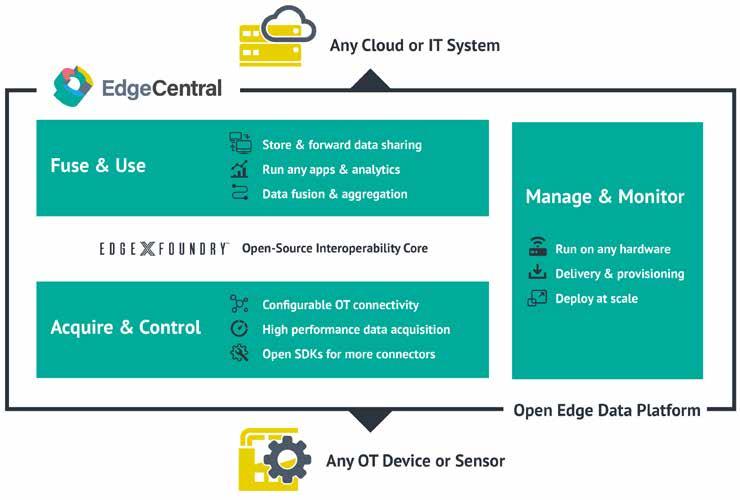
In particular, the use of virtualization means that automation systems can now support multiple independent parallel workloads on the same hardware. For example, one VM could be used to host a PLC workload running a closed loop control application. A second VM could be running a predicative analytics application, while a third VM is used to hosts a local data historian. Other VMs can be added to support additional workloads as the system evolves.
Edge computing is enabling a new generation of smart industrial applications that are able to leverage the latest advances in artificial intelligence (AI) and machine learning (ML). The use of advanced analytics at the edge to support new data driven use cases--such as performance optimization of plant equipment or video inferencing for default detection on a production line--can create real operational benefits and reduce costs.
Model based AI and ML are becoming
mainstream edge computing technologies that are being used effectively beside more conventional control systems. Although challenges still remain with respect to how to deploy, retrain and update models running at the edge, which is currently too difficult and expensive.
To support this trend, traditional hardwarebased PLCs are increasingly being replaced by software alternatives. The market has seen a range of both commercial and open-source soft PLC products based on either IEC 61131 or IEC 61499 emerge in the last few years.
Abstracting OT Systems and standardizing communications
Edge computing enables the “fusion” of data from multiple sources, both legacy and new, from which new insights and business value can be derived. However, this means that new data driven industrial edge applications may need to communicate with a variety of equipment using a plethora of communication protocols (e.g. Modbus, BACnet, OPC UA, EtherCAT, EtherNet/IP etc.,), and to acquire and normalize the data from a disparate set of endpoints.
A traditional automation application would
access this data directly from a dedicated PLC. This would inevitably lead to non interoperable siloed system.
A new generation of OT protocol agnostic open edge platforms are critical to abstracting this complexity. They can provide a portable and interoperable way for applications to evolve as new use cases are deployed and systems updated. They also help protect existing investments by enabling the integration of data from both brownfield equipment and new greenfield systems.
These new edge platforms typically provide a normalized OPC UA server layer into which data from all other OT endpoints (e.g. EtherCAT) is mapped. For industrial plant and automations system OPC UA is emerging as the de-facto communication standard through which other edge applications or higher level SCADA or ERP systems interface. Although, other communication protocols that have evolved from the IT world such as MQTT are also being heavily used for asynchronous edge communications.
Both commercial and open-source edge software platform implementations have emerged over the last few years. These have reached a level of maturity that now offers
31 07.2023 industrial ethernet book
Industrial Edge
SOURCE: IO TECH
The smart factory is accelerating the need for fully distributed architectures driven by edge computing. Cloud computing alone is unable to handle the vast amounts of data generated by the OT systems and cannot meet the need for local insights from the latency-sensitive applications on which they depend.
the industrial automation providers with a range of viable options on which to base their solutions.
A key open-source initiative with broad cross-industry support is the Linux Foundation’s LF Edge. The objective of LF Edge is to establish an open, interoperable framework for edge computing. EdgeX Foundry is one of the largest projects under the LF Edge umbrella. It provides a flexible and scalable open software platform that facilitates interoperability between OT equipment and applications at the edge. EdgeX Foundry and its commercial derivates, such as IOTech Edge CentralTM , are seeing increasing adoption within industrial plant and factory systems.
Hybrid edge-cloud automation architectures
The transformation to smarter factories is accelerating the need for fully distributed architectures driven by edge computing. Cloud computing alone is unable to handle the vast amounts of data generated by the OT systems and cannot meet the need for local insights from the latency-sensitive applications on which they depend.
What is also clear is that most automation systems will not rely one hundred percent on edge computing solutions. In fact, fully autonomous edge applications are quite rare. Most systems require a hybrid solution consisting of both edge and cloud components. To be successful, users require the ability to utilize cloud resources for heavy-duty applications, while using edge computing for lighter-weight processing and local, real-time
insights.
As OT and IT systems converge, achieving seamless interoperability between edge and cloud environments is critical. This is an area where OT and cloud agnostic open edge platforms are again playing an essential role as bridge between the two worlds.
Edge management
The business value that new edge computing solutions can bring to the industrial plant and automation markets is becoming widely accepted and organizations are starting to deploy at scale. However, challenges still remain due to heterogeneous nature of the industrial edge. These include:
• supporting the wide range of devices that the applications must run on such as PLCs, MCUs, IPCs, IoT Gateways, Servers;
• configuring the applications to communicate with the many different OT endpoints;
• monitoring and updating a deployed system during its lifetime.
Trying to do this at scale with a “man-in-theloop” is not practical. Cloud native application orchestration technologies such as Kubernetes are being used with some success within industrial automation solutions. However, Kubernetes is only suitable for containerized workloads (what about deploying binaries?) and, due to its memory requirements, is not suitable for all edge devices (e.g. PLC or MCU). Work is ongoing by the Kubernetes community, however, to reduce its memory footprint.
The challenge is also broader than just the edge applications. An end-to-end edge
management solution must also address the management of the nodes the applications will run on and the OT devices/sensors with which the applications will communicate. To accelerate the adoption of new edge computing technologies, the plant and automation market requires a new generation of management solutions focused on the unique needs of the industrial edge.
Summary
The need for more flexible and open industrial plant and automation systems--combined with the emergence of the IoT, Industry 4.0, advances in AI/ML--is driving the adoption of a new generation of edge computing solutions.

Traditional dedicated hardware-centric automation technologies are being complemented or even replaced by new edge solutions. These new edge solutions provide much better software capabilities, including support for containerization and virtualization, running on commodity hardware.
Edge software platforms are the critical enabler of data driven automation solutions. They abstract the OT systems and provide the required interoperability across edge and IT/ cloud processes within a smart factory. With edge computing solutions starting to be deployed at increasing scale, a new generation of edge management solutions is required to address the specific needs of the industrial edge.
Andrew Foster, Product Director, IOTech.
32 industrial ethernet book 07.2023
SOURCE: ISTOCK
Learn More
Industrial Edge
The need for more flexible and open industrial plant and automation systems--combined with the emergence of the IoT, Industry 4.0, advances in AI/ML--is driving the adoption of a new generation of edge computing solutions.
New AI edge computing products
DFI is devoted to developing AI edge computing products. Embedded solutions effectively reduce basic equipment and utilize more existing resources; furthermore, they also provide a highly flexible and scalable platform to meet the needs of various workloads, facilitating the integration of different devices and simplifying the architecture. DFI has taken the lead in jointly integrating ultracompact embedded products, and Intel display chip processors to promote iGPU (Integrated Graphics) SR-IOV virtualization technology and commercialize modules.
With the current Software-Defined AIoT trend, hardware-supported virtualization technology is essential in the application environment. DFI products ranging from the industrial grade motherboard, ADS310, equipped with 12th generation Intel CPU, to the EC70A-TGU system and tablets, leverage virtualization technology to integrate and set up multiple virtual platform spaces. In addition to optimizing operations, it saves the cost of connecting data to the cloud and improves yield and efficiency.

DFI President Alexander Su said, “Benefiting from Intel’s technology and the support of SR-IOV architecture, the hardware can execute different operating systems through a single CPU and integrate large amounts of shared data. Due to substantial
improvement in drawing performance within a virtual environment, features such as color recognition, measurements, and appearance flaw detection have increased in speed.”
Intel believes that cost considerations are a vital concern in industrial automation. DFI’s hardware can support SR-IOV virtualization technology. Through workload consolidation, it can improve cost efficiency, resolve the long term problem of graphics computing performance, and fulfill the needs of largescale deployments in application fields.
DFI’s ECI and EIAMR products have been tested by Intel’s ESDQ, and DFI and Intel have released a technical white paper. Through working closely with Intel, DFI continues to assist and optimize the development of various services in IoT applications, accelerating the realization of SoftwareDefined IoT.
Smart poles and smart retail are also gradually moving toward the trend of workload integration. Smart Poles can identify pedestrian behavior with roadside and vehicle equipment and synchronize the data to the smart poles.
Many devices can also execute highperformance AI edge computing and speed up people flow detection, people counting, monitoring, etc. Regarding smart retail, identification systems can be implemented
to determine consumer age and gender to understand customers.
About DFI
Founded in 1981, DFI is a provider of highperformance embedded computing solutions. Backed by 40 years of R&D experience, DFI offers a range of innovative industrial computers with high quality, stability, and reliability, from industrial motherboards, single-board computers (SBCs), embedded systems to industrial panel PC and displays. Together with its professional and immediate service, DFI has helped countless clients in industrial automation, transportation, energy, medicine, retail, and military applications.
Since joining the Qisda/BenQ Group in 2017, DFI has synergized its resources with Qisda and enhanced its R&D capabilities, supply chain management and production capacity to a new level. The acquisition of AEWIN and Ace Pillar in 2019 further helped DFI expand its business into cyber security and develop more comprehensive solutions in smart manufacturing to bring more added values to its customers.
33 07.2023 industrial ethernet book Industrial Edge
DFI
Learn More
SOURCE: DFI
Ultra-compact embedded products and Intel display chip processors offer GPU virtualization technology.
With the current Software-defined AIoT trend, hardware-supported virtualization technology is essential in the application environment.
20 years of compatible, open EtherCAT communications
IT HAS NOW BEEN OVER 20 YEARS SINCE THE EtherCAT story first began, and it is still just as successful as ever.

Indeed, the communication system developed by Beckhoff and presented for the first time at Hannover Messe 2003 has certainly been established as a highperformance real-time Ethernet solution in a wide range of applications, firmly establishing its place on the market through continuity and technical development, and even becoming an open IEC standard.
Here, Hans Beckhoff and Martin Rostan describe the stand-out aspects of this exciting period in the company’s history, while Johannes Beckhoff represents the next generation of management by focusing on requirements for the future.
It was back in 1989 that Beckhoff first introduced its high-performance bus system known as Lightbus. What were the reasons for developing a new communication system with EtherCAT?
Hans Beckhoff: Beckhoff has always been renowned for high-performance control and the way we continually push performance limits in the world of automation. This is all based on the principle of PC-based control technology, which allows us to exploit all the advantages of a PC – most notably including the high computing power – directly on the machine. In terms of data communication, we came up with an excellent solution in 1989 in the form of the Lightbus.
By the early 2000s, PCs had Ethernet interfaces as standard, and the first processors
Global success for EtherCAT
with integrated Ethernet interfaces were hitting the market. EtherCAT was developed so we would be able to use this new information technology medium on the machine, in line with our philosophy of connecting the IT world with automation. Our extensive experience with not just the Lightbus, but also all other fieldbuses such as CANopen and PROFIBUS, has been incorporated into the concept. This has certainly contributed to the overwhelming success of EtherCAT.
Martin Rostan: Our starting point was the fact that Lightbus – and indeed the other fieldbuses and first Industrial Ethernet
EtherCAT owes its worldwide success as an Industrial Ethernet system to two key factors: its first-rate, outstanding technology, and its disclosure within the framework of EtherCAT Technology Group. With regard to the high acceptance of EtherCAT among chip suppliers, device manufacturers, and users alike, the following ETG figures speak for themselves:
• more than 7,000 ETG members from 72 countries and still well over 400 new members coming on board each year
• approx. 3,500 registered EtherCAT device manufacturers
• 12 EtherCAT chip suppliers with a total of over 40 different chips
• over 230 control system suppliers with EtherCAT as system bus
• over 200 motion control suppliers with more than 1,000 drive products
technologies – could no longer keep up with the performance increase of the PCs. At the time, this resulted in highly complicated control architectures, as they were all decentralized. PC-based control, on the other hand, relies primarily on a centralized control approach and requires a correspondingly high-performance communication technology. EtherCAT bridged this gap and, in doing so, eliminated the former bottleneck in data communication – something it continues to do today some 20 years later.
Hans Beckhoff: That’s right – with Ethernet and the 100 Mbit/s data rate that comes with it, control technology could benefit from a tenfold increase in transmission speed. The RS485 and CAN-based networks of the time worked well, but they were limited in terms of bandwidth and performance.
Which Ethernet aspects were particularly important when it came to implementing this technology on an industrial scale?
Hans Beckhoff: The Ethernet protocol is designed for the transmission of large amounts of data and long data telegrams, not for the small units of information common in the machine environment, such as a 1-bit limit
34 industrial ethernet book 07.2023 Technology
IEB presents an interview with Hans Beckhoff, Johannes Beckhoff and Martin Rostan of Beckhoff looking back on 20 years of EtherCAT.
SOURCE: BECKHOFF
The ultra-fast EtherCAT developed by Beckhoff has already been used successfully for 20 years and has long since established itself as an open, global standard for real-time Ethernet communication.
switch value or a 16-bit analog value. With that in mind, the task was to find a synthesis between the 100 Mbit/s data rate and the fine 1 to 16 bit range found in the automation environment – and that is precisely the ideal solution we were able to achieve with EtherCAT. Not only did we completely reinvent the technical principles necessary for this, but we also integrated them into both the EtherCAT protocol and the EtherCAT hardware.
Martin Rostan: We took the basic principle of telegram processing on the fly from the Lightbus and elevated data communication to a whole new level. We also made constructive use of the new Ethernet technology, which had since arrived in the domain of automation technology, to elegantly circumvent the major bottleneck with Ethernet for real-time communication. A major contributing factor here was the high level of protocol efficiency – i.e., utilizing more than 90% of the available bandwidth. It was also significant that the complexity of the protocol was completely mapped in the hardware, as this simplified the entire EtherCAT implementation process considerably for the device manufacturers.
How would you summarize the fundamental advantages of EtherCAT?
Hans Beckhoff: First of all, the traditional RS485 and CAN-based fieldbuses are what
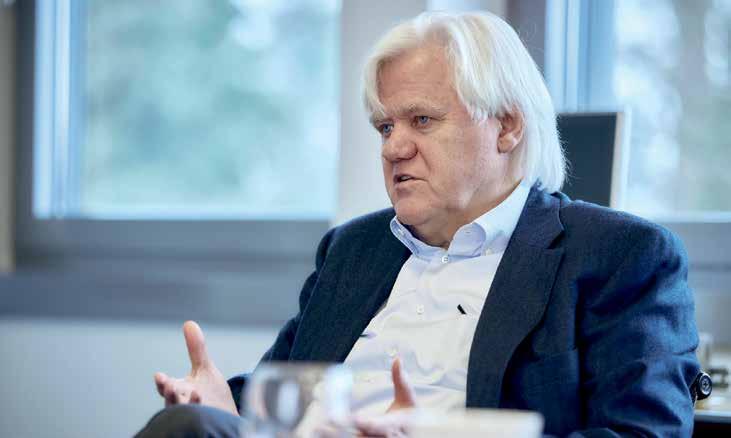
are known as party-line buses, which feature multiple devices on a single connection. Network diagnostics and troubleshooting are significantly more complicated as a result. This is why EtherCAT has adopted the pointto-point connection of Ethernet so that each transmission path can be properly diagnosed, which is an essential feature. We also decided quite early on that we could manage with a standard Ethernet telegram and so do without a special communication card in the master, which is still a major advantage of EtherCAT. The key advantage, though, is the protocol efficiency that we have already discussed – i.e., the fact that data can be taken from or added to the 64- to 1,500-byte Ethernet telegram on the fly. This is the only way to ensure that the high bandwidth can be used consistently and for the many small information units of the numerous automation devices, with over 65,000 of these possible in the same network, in a single telegram.
Martin Rostan: This principle results in yet another advantage, in that the controller can already compile the process image perfectly in the data telegram, since the network nodes can insert or remove their data at any point. This eliminates the need for the bit operations required in other systems, which are complex to implement via an interface card. The EtherCAT master, on the other hand, does not impact the controller in any way,
as a completely pre-sorted process image is available that can be processed directly. EtherCAT is therefore not only very fast in terms of actual communication with very short cycle times, but also in all upstream and downstream process steps.
Hans Beckhoff: That’s right. And this principle is based on the IT function of the Memory Management Unit, which we have further developed into the Fieldbus Memory Management Unit (FMMU) for this purpose. The FMMU is one of the essential features of EtherCAT and allows data to be taken from and written back to a decentralized memory on the fly, so that any kind of mapping can take place between the data in the physical device and the data in the active telegram.
What’s more, individual tasks and processor cores can also be mapped very well via the FMMU and defined with corresponding time levels, which ideally corresponds to modern and task-based control technology. Another central feature of EtherCAT can be found in the distributed clocks, which introduced a defined and automatically synchronized system time for the communication system. This is crucial since advanced control concepts are almost always time-slice based and require synchronized sampling points for data and signals. This entire concept of distributed clocks simply did not exist in previous fieldbuses.
35 07.2023 industrial ethernet book Technology
SOURCE: BECKHOFF
Hans Beckhoff is a physics graduate and the Managing Director and owner of Beckhoff Automation. He founded the company in Verl, East Westphalia, back in 1980, and developed a philosophy of PC-based control technology that has laid the foundations for the economic and technological success that has been achieved ever since.
Are these fundamental EtherCAT advantages also perceived in this way on the market?
Hans Beckhoff: Absolutely. All of these advantages add up to a technology that is inherently logical and quickly understood and loved by engineers worldwide. This rather emotional aspect is certainly also one of the reasons why EtherCAT has become so firmly established worldwide.
Johannes Beckhoff: I can only agree with that, despite not having been involved in this early development myself. By its very nature, EtherCAT is a high-performance and at the same time simple and logical protocol. Without even looking at the other systems, I asked myself right from the outset: What else would we use for Industrial Ethernet when EtherCAT is clearly the optimal solution?
Martin Rostan: Yes, back then, we even


coined the phrase "EtherCAT is the engineer’s choice"! And that sums it up well: EtherCAT was – and still is – the more convincing technology in comparison and so it is easy to justify its use in technological terms.
How important was the EtherCAT presentation at Hannover Messe 2003 for Beckhoff and how did the market react?
Hans Beckhoff: This was definitely a special event for the development team, with a core group of six experts, and everyone was proud of it. We had a huge presentation wall spanning 4 meters across at the event to really showcase the principle to maximum effect, and we even used oscilloscopes to demonstrate the real-time capability. Everything was incredibly well presented from start to finish, and customers were as enthusiastic as we had
hoped. Even the representatives of the other fieldbus organizations and control suppliers were obviously impressed – at least that’s what I gathered from the stunned silence and a few pale faces at the time!
Martin Rostan: That’s right, I can still remember a competitor leaving our booth without even saying hello, with his mouth open and all the colour drained from his face. That was all the confirmation we needed. Everyone who understood how it all worked was immediately enthusiastic about it and confirmed that EtherCAT is the best way to use Industrial Ethernet.
A major contributing factor to the success of EtherCAT was the disclosure of the protocol and the associated foundation of EtherCAT Technology Group (ETG) at the SPS 2003 exhibition. What prompted Beckhoff to choose this moment to open up to the market?
Hans Beckhoff: Without a doubt, the founding of ETG has contributed just as much to our success as the sophisticated technology. ETG was built up by Martin and is now an independent organization that has put EtherCAT technology on the map worldwide. Without ETG, EtherCAT would probably have remained an exciting technology with a few followers, but would never have achieved its current widespread acclaim as a globally accepted standard.
Martin Rostan: Beckhoff has always stood for openness and supported all relevant open fieldbus technologies. At that time, there were around 20 different communication systems and industry-specific variants for which Beckhoff had all the relevant experts. This experience has been channeled into ETG not only technologically, but also in terms of the advantages and disadvantages of the respective user organizations. Once again,
36 industrial ethernet book 07.2023 Technology
Hans Beckhoff (center) and Martin Rostan (left) review the past 20 successful EtherCAT years and share their many years of experience with the next generation represented by Johannes Beckhoff (right).
SOURCE: BECKHOFF
Johannes Beckhoff is Hans’ son and joined Beckhoff Automation in 2019. The graduate physicist (MSc) works in basic research and development processes and is already helping to shape the technological future of PC-based control. work to the external network.
SOURCE: BECKHOFF
this includes the aspect of openness, in that ETG members very much appreciate how the development of EtherCAT technology is managed: Beckhoff is the technology driver, but the requirements of all partners are consistently taken into account. The principle of open fieldbus organization has clearly proven itself here. It is not without reason that ETG has now become by far the largest fieldbus organization, with more than 7,000 members from 72 countries, worldwide distribution, and Asian members accounting for over 40%. We have grown to the point that the "mere 14%" of our membership from the Americas makes us the largest American fieldbus association. It is also important in terms of the usability of EtherCAT that both device manufacturers and end users were involved from the beginning.
EtherCAT is celebrating its 20th anniversary, but it is by no means a thing of the past. Why is it still the number-one industrial communication system even today?
Hans Beckhoff: Over the last 20 years, the technology has proven to be so well conceived that we have not had to make any changes to the basic protocol. This is a fundamental aspect of our success. What’s more, we have applied the EtherCAT principles to other application levels, such as the EtherCAT Automation Protocol (EAP) for control-to-control communication. We have even introduced the EtherCAT G extension as both a 1 Gbit/s and 10 Gbit/s variant, meaning the EtherCAT protocol also works at these rapidly increasing speeds.
Martin Rostan: It is actually one of the unique selling points of EtherCAT that the technology itself has never had to be changed. The basic protocol contained in the chip has always remained the same and has only ever been extended in a fully backward compatible way. The same applies to Safety over EtherCAT, where backward compatibility is also ensured throughout. Even 100 Mbit/s devices can still be integrated and operated in EtherCAT G networks. What this all means is that a current EtherCAT device will still work in a 20-year-old plant, which in itself is reason enough for many users to choose this fieldbus option, and means our technology will not create a bottleneck in the control architecture in the future. For most applications, this will continue to be the case with 100 Mbit/s; however, EtherCAT G offers sufficient potential to meet all the high-end requirements of the next 20 years without any problems and without a break in technology.
Johannes Beckhoff: I have to agree with Martin here: 100 Mbit/s is sufficient to handle most machine requirements – even for cycle times smaller than 1 ms. EtherCAT G can then be used to implement extremely data-intensive applications, such as XPlanar or Vision applications, with several kbytes of
data in a sub-ms cycle. Without EtherCAT G, we would be limited to a maximum of maybe 20 tiles, so we wouldn’t be able to develop a really large XPlanar system. A Gbit/s data rate already enables over 100 tiles.
This generally also applies to the XTS linear transport system, which works excellently with a transfer rate of 100 Mbit/s, but would not be possible at all without the efficient EtherCAT protocol. This is because here, too, several kbytes of data have to be transferred with very short cycle times of 250 µs. Other communication systems cannot do this and require an elaborate decentralized control architecture for comparable systems.
Hans Beckhoff: And it is precisely our central control philosophy that makes it possible to calculate a mathematical-physical model of the entire process on one CPU. It essentially works in the same way as humans, whose central brain receives all data from the body via the central nervous system. The brain is modularly structured in terms of its subroutines, and effectively works out the desired movements or whatever action is required. Our automation technology is based on the same principle, and so EtherCAT corresponds to the central nervous system of a machine that allows as much peripheral data as possible to flow quickly into the central control model. The success of Beckhoff as an automation provider is largely due to the fact that we pursue precisely this approach – the "technological trifecta" of PC technology, EtherCAT, and central control philosophy.
Which topics are the focus of EtherCAT developments – both now and in the medium term?
Hans Beckhoff: As an Ethernet-based system, EtherCAT and the EtherCAT products

will continue to follow the hardware layers available in the market. Even today, a wide range of Beckhoff-specific coupler designs is already available for RJ45, M8, and plastic- and fiber-optic cables, which will be expanded in the future to include other physical transmission types relevant to the market. Another major development step is the introduction of our hybrid technology for the one-cable solution. This is what prompted us to develop EtherCAT P, which integrates data and power into a 4-core standard Ethernet cable. Another particularly exciting development in this context is our series of EtherCAT P hybrid connectors in sizes B12, B17, B23, and B40, which will be included in an IEC standard as standard circular connectors for decentralized automation in future. We initially started EtherCAT as a communication protocol and use the complete hardware physics afforded by Ethernet. We also developed the electromechanical additions necessary for automation to make the system as practical as possible. In this context, EtherCAT P represents a huge step, as does the EtherCAT P connector series.
Martin Rostan: Another aspect that is becoming increasingly important in automation is the topic of cyber security. EtherCAT offers a number of advantages here, since its architecture and specific properties already provide everything inherently in the system to meet these challenges. Better still, EtherCAT can handle all of this without the need for a new protocol version, hardware changes, or special measures.
Interview with Hans Beckhoff and Johannes Beckhoff, Beckhoff Automation and Martin Rostan, EtherCAT Technology Group.
Learn More
37 07.2023 industrial ethernet book Technology
SOURCE: BECKHOFF
Martin Rostan is a graduate engineer and Senior VP of Technology Marketing at Beckhoff, as well as Executive Director of EtherCAT Technology Group (ETG) in Nuremberg. He has been with Beckhoff Automation for 25 years, starting in 1998 as the company’s first product manager for fieldbus products.
Standardization promotes user safety and opens new markets
Beckhoff hybrid connectors and One Cable Automation has been proven in thousands of field installations. Florian Vogel from I/O Product Management discusses the technical advantages associated with these connectors and the significance of their definition within an IEC standard for decentralized automation.
THE BECKHOFF PORTFOLIO OF HYBRID connectors, and thus One Cable Automation (OCA), has already been proven in thousands of field installations. In this interview, Florian Vogel from I/O Product Management at Beckhoff Automation discusses the technical advantages associated with these connectors and the significance of their definition within an IEC standard for decentralized automation.
What sets the hybrid connectors from Beckhoff apart?

Florian Vogel: Hybrid connectors are essentially used to transmit power and data via a single line to save on cables and connectors. But the solution developed by Beckhoff together with a partner offers the additional advantage of a high degree of
modularity, which allows a wide range of variants for a host of different applications, while also providing connection security through mechanical coding. It also features a uniform data core in all four connector sizes – B12, B17, B23, and B40.
These are all fundamentals to successfully establishing itself as the ideal connector for decentralized automation – also known as One Cable Automation. There’s also the fact that some 95,000 connectors have already proven themselves in the field, so this is by no means a completely new product that has yet to demonstrate its worth. In fact, our development has benefited from the fact that Beckhoff has always maintained close contact with its end customers and has therefore been able to implement their requirements more consistently than a straightforward connector manufacturer.
How does the modular design impact the fabrication or installation effort?
Florian Vogel: The modularity of this design actually represents a considerable simplification rather than additional work. As the individual parts can only be assembled in one direction, the whole process is essentially intuitive and prevents any possibility of incorrect assembly from the outset. What’s more, there are clear colored markings on the contact carrier that correspond to the wire color of the cable, which does away with the need for a complex assignment plan detailing each individual pin assignment. Our hybrid connectors also comprise just ten individual components –significantly fewer than comparable third-party products. In combination with the additional data module, this usually results in a reduction of the assembly time by two thirds.
38 industrial ethernet book 07.2023
Technology
The modular design of the hybrid connector simplifies installation and cable preparation considerably.
SOURCE: BECKHOFF
The hybrid connectors from Beckhoff will form part of an IEC standard in the future. What exactly does this mean?
Florian Vogel: Beckhoff hybrid connectors are among the first products to comply with the upcoming IEC 61076-2-118 standard, which is expected to be published at the end of 2024. The aim of establishing a global standard like this, first and foremost, is to ensure security for the customer or user; not only with regard to supply chains and secondsource strategies, but also in terms of the level of product reliability defined by established and widely adopted standards. Key focal points here are always technology and being fit for the future, and our hybrid connectors already tick these boxes with their modularity, uniform data core, and optimal design for OCA.

All things considered, standardization within the framework of an IEC standard is certain to also lead to an expansion of the market for a circular connector like this. Initial estimates see an immense market potential of 800 million to 1 billion euros. In addition to the advantages of standardization already discussed, connector manufacturers have also recognized that the market addressed by these highly functional and universally applicable hybrid connectors has largely not yet been tapped, and can be reached much more easily through IEC standardization.
Who will find this standardization particularly important?
Florian Vogel: In our experience, all users see a clear need for this development, from machine builders and end users across a range of sectors, including automotive, through to device manufacturers. After all, compliance with an IEC standard does not mean that development will come to a standstill for the next few years or decades. On the contrary, our modular hybrid connectors are the ideal solution not only for retrofitting current systems, but also for use in conjunction with EtherCAT G/G10 to facilitate system developments over the next ten or 20 years. Being fit for the future to this extent is generally quite unusual for a normed standard, but in this case it is a given.
To what extent do device manufacturers and technology user groups such as the EtherCAT Technology Group (ETG) benefit in particular?
Florian Vogel: Device manufacturers have a keen interest in an IEC standard because it promotes and ensures worldwide availability of the components. Furthermore, the openness of standardization and a corresponding variety of suppliers usually lead to a much lower procurement price. For technology groups
such as the ETG, there is another fundamental aspect in that these organizations want to concentrate as fully as possible on the development of their technology and not deal with all of the peripheral considerations. As for connector manufacturers, they also have a vested interest in following standards, since it is not common to find a complete portfolio of circular connectors, and standardization can facilitate rapid market entry here.
With One Cable Automation, Beckhoff is one of the pioneers in the field of decentralized automation. To what extent will hybrid connectors further advance the concept of decentralization?
Florian Vogel: With CP-Link, OCT, and later EtherCAT P, Beckhoff advanced and implemented the concept of the one-cable solution very early in the game. So across our entire portfolio, from IPC, Motion, and I/O through to the new MX-System and Vision product categories, there are already opportunities for decentralized automation with PC-based control from Beckhoff. With the modular hybrid connectors, it will be possible to implement this One Cable Automation even more consistently and universally going forward.
Interview with Florian Vogel, Beckhoff. Learn More
39 07.2023 industrial ethernet book Technology
SOURCE: BECKHOFF
Florian Vogel, Product Management I/O, Beckhoff Automation.
Emergence of Time-Sensitive Networking Q&A
The transition is not happening overnight but industry leaders from Avnu Alliance continue to emphasize the possibilities with Time-Sensitive Networking (TSN) converged networking technology.
THE ROLE OF TSN IN SMART MANUFACTURING is continuing to evolve as users and suppliers learn how applications can benefit from converged networking.

Dave Calvacanti, President of the Avnu Alliance and Jack Lin, product manager and project lead of Moxa’s Global TSN Initiative, joined together to answer questions on the future of TSN, technology benefits that are driving it forward and how it will affect the automation applications landscape.
Why is Time Sensitive Networking (TSN) so important in IIoT systems?
Dave Calvacanti, President, Avnu Alliance: The IIoT is moving beyond single-function
networks to realize the benefits of a converged network foundation with the coexistence of different traffic types on the same physical network. Critical and non-critical traffic have previously been kept separate for operational integrity, real-time performance, safety, or security reasons, but TSN provides the tools to enable their convergence. This allows for the exchange of real-time control, telemetry, and general IT information, all managed securely by IT and OT.
This will reduce infrastructure costs and the resources needed to manage and maintain the network. This breaking down of communication barriers between critical and noncritical systems is a foundational concept enabled by TSN for the future of the
Industrial Ethernet.
Jack Lin, product manager and project lead of Moxa’s Global TSN Initiative: TSN is an advanced technology that helps industry leaders accelerate their digital transformation in industrial automation. TSN offers time synchronization, low-latency communications, ultra-reliability, and better resource management. This facilitates the merging of IT and OT networks to connect all end devices and centralize data collection on a standard Ethernet network. Digital transformation can be achieved by real-time information made possible by TSN, enabling factories to optimize their production strategies for fast-changing markets and emerging challenges.
40 industrial ethernet book 07.2023
SOURCE: AVNU
Technology
The IIoT is moving beyond single-function networks to realize the benefits of a converged network foundation with the coexistence of different traffic types on the same physical network.
What are some typical use cases that demonstrate the benefits of having both standard Ethernet traffic and time-critical traffic coexisting in a converged network?
Calvacanti : Factory automation, process automation, motion control, predictive maintenance, and professional audio-video are all applications that can benefit from converged networking. One example could be an automated robotic arm with a safety trigger to cease operation should an operator come too close. The operation of the robotic arm itself requires deadline-based delivery of control traffic and sensor feedback, with a control cycle that could be in the 100s or even 10s of microseconds. The safety trigger has a less onerous cycle but obviously the alarm generated when the trigger is activated is the most essential feature of all. Alongside these types of traffic is operational monitoring of both the arm and trigger, which is important for keeping tabs on operational health, statistic gathering and predictive maintenance.
Lin: The operating company of a hydropower plant was determined to bring all their isolated networks together and implement an AI system for their control network by embracing the TSN standard, which was a perfect fit for this kind of use case, as performing services on a converged network was much easier than on disparate networks. The hydropower plant improved efficiency and the ability to quickly adjust the total power output to the grid as needed, giving rise to a new hydropower plant with lower costs, easier maintenance, higher efficiency, and improved adaptability.
What are the current barriers to adoption of the TSN technology in IIoT settings?
Lin : Like any new technology adoption, it will happen like a transition but won't turn out overnight. The good news is many of the significant industrial protocols, such as PROFINET, EtherNet/IP, CC-Link, and OPC Foundation announcing support for TSN, and the ecosystem is moving forward. It may seem chaotic, but it is exciting to see where and how TSN is used in pilots and early implementations.
One balance we are trying to strike concerning TSN adoption is between investing for the future and meeting current market demands, as those forces are frequently in conflict. Like any new technology adoption, this will happen as a transition and not overnight but with many of the large industrial protocols such as Profinet, EtherNet/IP, CC Link and OPC Foundation announcing support for TSN, the ecosystem is moving forward. It can seem a bit chaotic, but it is also an exciting time to see where and how it is being used in early pilots and implementations. One
balance we are trying to strike with regard to TSN adoption is between investing for the future and meeting current market demands, as those forces are frequently in conflict.

Calvacanti : Rapid globalization and digital transformation have led to industrial operators adopting IIoT applications to enhance operational efficiency and maximize revenue. Amidst such a rush, getting everyone on the same page is obviously a challenge. Transitioning from proprietary protocols and network to standards-based wired and wireless network is the major barrier to overcome.
What role does Moxa play in the IIoT, specifically with regard to TSN?
Lin: To help our customers rapidly enter the IIoT world, Moxa provides secure, reliable, and easy-to-use sensor-to-cloud IIoT solutions that can effortlessly transform data into actionable insights, and our experience in connectivity for industrial automation enables us to optimize communication and collaboration between systems, processes, and people. As one of the pioneers in developing TSN standards, Moxa has committed to collaborating with key industry players and customers to bridge the gap between standard Ethernet and industrial applications and to speed up the cross-vendor interoperability of automation components in automation systems. We’re involved in many TSN standardization projects worldwide and we launched the industry’s first TSN-enabled switch with all ports supporting TSN in 2018.
What will be the impact of Moxa joining the Avnu Alliance?
Lin : Membership in Avnu aligns with our global strategies and our vision for TSN
as the network for the future of industrial automation, as both of us are members of the TSN Industrial Automation Conformance Collaboration (TIACC), the industrial industry initiative to drive TSN interoperability. Avnu and Moxa have many synergies with our work in TIACC and our shared goal of interoperability and coexistence in open, standard networks.
We’re excited to begin collaborating freely with fellow Alliance members to develop interoperable TSN products and further enable an ecosystem where devices from different manufacturers, which support different automation protocols, will coexist reliably over wired and wireless TSN on a unified network infrastructure for communications at all levels.
Calvacanti : Moxa’s joining shows great promise, focusing on working on a truly unified and high-performance network infrastructure that permits all types of traffic to coexist for real-time communication, low latency, and high reliability requirements in diverse applications.

Moxa also has shown a deep commitment to driving network convergence and interoperability through its work with the TIACC and participation in industry TSN test beds, and they bring over a half-decade of experience developing TSN infrastructure to the Avnu Alliance. As the first Taiwan-based company and the newest promoter member company of Avnu, Moxa will take the reach of the Avnu interoperability ecosystem further to the Asia Pacific region, specifically Taiwan and China.
Technical article by Avnu Alliance.
Learn More
41
07.2023 industrial ethernet book Technology
Dave Calvacanti, President of the Avnu Alliance (left) and Jack Lin, product manager and project lead of Moxa’s Global TSN Initiative (right).
Ethernet of the future with TSN: connectivity on a new level
TIME-SENSITIVE NETWORKING IS PAVING the way for decisive advances in industrial networking, because the functionality of TSN makes Ethernet future-proof for next generation applications. The key benefit is the enablement of open, unified and convergent architectures that hold enormous potential for productivity gains. So it is only logical that compatible, certified network switches are already being offered. But in order to take full advantage of TSN, both the end components and infrastructure must support this technology.
Converged networks
Convergence is without question a key aspect of future-oriented smart applications in a variety of sectors, from manufacturing to transportation to energy automation. TSN creates the appropriate conditions by enabling highly deterministic communication within the vendor-neutral standard Ethernet.
TSN can differentiate between data classes and assign priority levels to the individual data packets. This is how network traffic flows, taking into account the timings for each class. As a result, TSN can even meet the demanding real-time communication requirements of industrial automation applications.
In particular, TSN is able to support the integration of Information Technology (IT) and Operational Technology (OT). “This innovation promotes network convergence because it can send IT and OT traffic over the same wire and still meet the different needs within the communication. An important advantage of TSN for industrial applications is therefore the standardization of networks that previously had to be kept separate. This results in a reduction in complexity in the networks and savings in investment costs. Above all, however, the extensive technical advances made possible by TSN open network architectures. This opens up a veritable treasure trove of information that data scientists can use to transform Industry 4. 0 and smart applications. If this data can be used seamlessly directly from the source, we no longer need gateways in between.
Another TSN feature that is valuable for users, automation engineers and machine builders is upwards and downwards compatibility, which means that existing and future Ethernet components can be integrated into TSN-capable networks with corresponding, complete
migration paths. In addition, the new TSN mechanisms are an addition to the Ethernet toolbox and thus offer the same flexibility in network architecture and bandwidth scaling as traditional Ethernet.
Connected industries of the future
These competitive advantages are the basis for cost-efficient, future-oriented networks. Probably no other area benefits from the TSN technology and the associated advances to the same extent as factory and process automation.
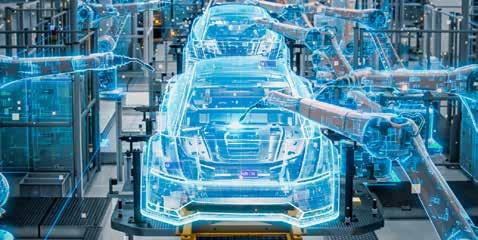
For example, critical data traffic, such as motion control data with its precise real-time requirements, and non-time-critical data traffic, such as bandwidth-intensive file transfers, can be handled simultaneously over a network without conflicts arising.
Ultimately, network convergence enables decentralized, real-time control. This allows large numbers of complex machines and robots to interact with each other more precisely and flexibly than was previously possible. In addition, companies can make better use of important applications, such as predictive maintenance, that require the analysis of large amounts of sensor data. Open and converged networks from the cloud to the sensors on the shop floor also provide secure access for performing maintenance work and other tasks remotely.
Furthermore, TSN offers high-precision time synchronization (IEEE 802.1AS) and mechanisms for controlling bandwidth usage (IEEE 802.1Qbv). These capabilities are of
great value in both discrete manufacturing and process automation networks because they provide an accurate time reference for sequencing-based applications.
Take the chance early
Belden and its subsidiary Hirschmann relied on TSN at an early stage in order to make their products and their customers' systems futureproof: "Belden has always been a technology pioneer and, with this intention, was also one of the initiators of the standardization of TSN at the IEEE in the early 2010s . Belden's robust portfolio includes market-leading industrial networking solutions for the most demanding environments and is based on standard Ethernet, making TSN an excellent fit.”
When developing its first TSN-compatible products, the RSPE and BOBCAT managed DIN rail switches, Belden chose as the underlying technology CC-Link IE TSN, the first open industrial Gigabit Ethernet with TSN functionality. The fact that the CLPA offered the first industrial TSN profile for certification was of course a decisive factor in our decision. The company also knew how to use the new TSN tools for Ethernet and chose the appropriate mechanisms for well-functioning data communication with a vendor-neutral network technology.
Thomas Rodenbusch-Mohr, Product
Visit Website
42 industrial ethernet book 07.2023 Technology
Cluster Manager, Hirschmann Automation.
Thomas Rodenbusch-Mohr, Product Cluster Manager at Hirschmann Automation and Control GmbH, a subsidiary of the Belden Group and member company of the CC-Link Partner Association (CLPA), explains the advantages of TSN and why Hirschmann is offering TSN-enabled products.
SOURCE: ISTOCK/GORODENKOFF
TSN can meet the real-time communication requirements of industrial automation.
TSN revolutionises footwear manufacturing
Orisol’s flash activator machine is an example of how TSN has been applied in a real-world application to deliver significant machine performance improvements. The resulting innovation delivers unprecedented speed and responsiveness as well as the connectivity required for smart manufacturing operations.
DELIVERING CUTTING-EDGE SOLUTIONS IS the goal of any customer-driven, ambitious company. When Orisol, a leading provider of automated systems for footwear production, wanted to futureproof its offering to drive its customers’ and its own competitiveness, CC-Link IE TSN offered a technology solution.
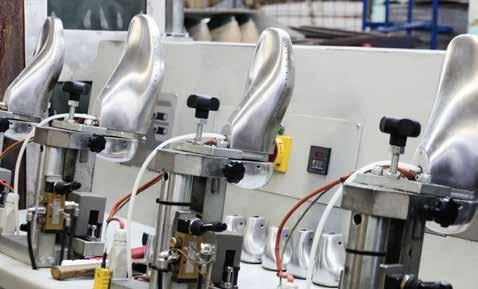
Orisol is committed to delivering solutions that maximise interoperability, compatibility and scalability to support the digital transformation of its customers and advance their competitiveness. It also participates in key technology collaborations, such as Mitsubishi Electric’s smart manufacturing initiative, the e-F@ctory Alliance. In addition, it focuses on the development of future-oriented systems that can support the different stages of shoemaking.
After learning about the potential of TimeSensitive Networking (TSN), the footwear equipment specialist was keen to apply this technology to its solutions in order to help drive forward the digitalisation of its customers. In effect, TSN can provide the backbone for smart, data-driven operations by supporting the convergence of multiple types of traffic onto a single network. While doing this, TSN also ensures determinism by prioritising the transfer of time-critical messages, such as control data.
Innovation – body and soles
Orisol saw its OFA240 series upper to sole flash activator machine as an ideal candidate to benefit from the principles of TSN technology. This system, which is a key element of footwear assembly lines, uses heat activation to effectively and homogeneously cure adhesives that are applied to bond different shoe components together.
Successful bonding requires accurate and precise control of the heat applied onto the product. In effect, the challenge in this process is the heat energy distribution that is spread out on the surfaces. It requires the machine to have precise internal communications to regulate the heating energy being released. Also, it needs to offer monitoring functions for the user to know if intervention is needed.
In terms of network requirements, optimum operations for the OFA240 demand suitable controller to device (C2D) communications, so that a single network architecture could
be used for all the operational technology (OT) elements of the machine to self-adjust in real-time. These components include vision systems, temperature sensors, heat lamps, switches, indicators and alarms.
Since Orisol is focused on the digitalisation of operations to create a smart facility, a network architecture that could also enable controller to controller (C2C) communications, in addition to integration with higher level information technology (IT) systems, was required. This would allow machines to operate in parallel to share information and effectively collaborate to optimise product quality, efficiency and productivity.
TSN provided a single solution to address all these requirements, ultimately supporting convergence of the OT and IT domains. It also offered the possibility for multiple machines to be integrated into Orisol’s proprietary production monitoring and remote maintenance systems, such as its Production Data Collection System (PDCS) and Remote Operation Maintenance Platform (ROMP).
To leverage the power of TSN and meet Orisol’s requirements, CC-Link IE TSN was selected as the system’s network technology. This is the first open industrial Ethernet to provide TSN functions, therefore ensuring convergence and determinism. In addition, it offers gigabit bandwidth to maximise the volume of data traffic that can be sent
simultaneously. Furthermore, it is supported by leading global automation vendors with a range of compatible products.
A foot in the door
Thanks to an established portfolio of CC-Link IE TSN compatible industrial automation devices from Mitsubishi Electric and Moxa, Orisol could leverage a comprehensive application solution to meet all their requirements. The benefits delivered by this solution were significant. The network’s gigabit bandwidth led to internal communications speed increasing 220 times. This meant that execution time was shortened by 7 times and application time by 12 times. CC-Link IE TSN also enabled machines to be synchronised to an accuracy of 1 millisecond. This delivered almost instant data sharing, delivering precise communications within the machine itself, to other devices and to IT systems, such as Orisol’s PDCS and ROMPS. These provide remote monitoring and control, allowing operators to have a real-time overview of the process as well as promptly intervene, if anomalies are discovered. The end result was a system that fully addresses the demands of Industry 4.0 by using TSN technology.
Application article by CLPA.
Visit Website
43 07.2023 industrial ethernet book
SOURCE: ISTOCK/NORDRODEN
Applications
Orisol wanted to futureproof its offering, and CC-Link IE TSN offered a technology solution.
Time Sensitive Networking in semiconductor manufacturing
By providing deterministic real-time communication over Ethernet networks, TSN can help to improve the accuracy, speed, and reliability of semiconductor manufacturing processes. This can lead to increased productivity, reduced costs, and improved product quality.

SEMICONDUCTORS PLAY A CRUCIAL ROLE in modern society and are of paramount importance in various aspects of technology and everyday life. Here are some key reasons why semiconductors are highly significant: for electronic devices, semiconductors are used in the fabrication of transistors, diodes, integrated circuits (ICs), and other electronic components.
These components form the basis of virtually all modern electronic devices, including smartphones, computers, televisions, automobiles, and medical equipment. Semiconductors are at the core of ICT infrastructure. They power telecommunication networks, data centers, and the internet. Semiconductors enable the transmission and processing of vast amounts of data at high speeds, facilitating global connectivity, online services, cloud computing, and the IoT.
The semiconductor manufacturing industry is highly competitive and characterized by intense competition among companies worldwide. Efficient and cost-effective manufacturing processes are essential for semiconductor companies to compete successfully. The ability to scale production, achieve high yields, and meet customer demands for quality and reliability is critical. Advanced fabrication facilities, such as cleanrooms and fabrication equipment, require significant capital investments, and companies with robust manufacturing capabilities are better positioned to meet market demands.
Motion control key aspect of semiconductor manufacturing
Wafer Fabrication (FAB): The wafer fabrication process involves multiple complex steps, such as photolithography, etching, deposition, and polishing, to create integrated circuits on silicon wafers. Automation in wafer fabrication is critical for achieving high precision, repeatability, and efficiency. Automated systems handle wafer handling, equipment calibration, material tracking, and process control, reducing human errors, increasing throughput, and ensuring consistent quality.
Advanced communications improve all processes
Semiconductor manufacturers need to ensure maximum precision and accuracy,
operating under stringent and often isolated, environmental conditions to deliver highquality products. Effective track and trace systems that can monitor the movement of resources and goods across factories as well as the entire supply chain are also needed.
To succeed in this, it is crucial to set up a network that, in addition to high speed and deterministic performance capabilities, can also support higher enterprise-level systems for robust material tracking and tracing throughout the entire production line. Ultimately, what semiconductor manufacturers require is a network technology to enable the highly effective convergence between the operational technology (OT) and information technology (IT) domains.
Ethernet with TSN is game changer
TSN stands for Time Sensitive Networking. It is a set of standards developed by the IEEE (Institute for Electrical and Electronics Engineers) to enable deterministic real-time communication over Ethernet networks. TSN can be used to support a wide range of applications, including industrial automation, transportation, and smart cities.
This is a brief history of the history of TSN technology.
• 2012: The IEEE 802.1 TSN Task Group was formed to develop standards for deterministic real-time communication over Ethernet networks.
• 2014: The IEEE 802.1 TSN Task Group published its first set of standards, which included support for time synchronization, traffic shaping, and scheduling.
• 2016: The IEEE 802.1 TSN Task Group published its second set of standards, which included support for quality of service (QoS) and network redundancy.
• 2018: The IEEE 802.1 TSN Task Group published its third set of standards, which included support for factory automation and transportation applications.
• 2018: Mitsubishi Electric released its first suite of products that leverage TSN with their communications standard CC-Link IE TSN.
TSN is a powerful solution to address industrial communication needs, as a technology that was developed to enhance Ethernet so that it could merge disparate types of data traffic. In effect, thanks to TSN functions, it is possible to support real-time and deterministic automation communications
44 industrial ethernet book 07.2023
TSN technology delivers these benefits by leveraging new Ethernet chip technology that delivers advanced time synchronization, traffic shaping and scheduling methods for traffic prioritization.
Technology
SOURCE: ISTOCK
along with Transmission Control Protocol/ Internet Protocol (TCP/IP) communications. More precisely, by providing guaranteed data transport with bounded low latencies, networks based on TSN are able to transfer best-effort traffic as well as mission-critical data in a timely manner, over a single cable.
TSN technology delivers these benefits by leveraging new Ethernet chip technology that delivers advanced time synchronization, traffic shaping and scheduling methods for traffic prioritization, as set out in the IEEE 802.1 Ethernet standards. In particular, the new clock synchronization can support highspeed, extremely accurate and deterministic operations on the shop floor. This is especially important in motion control applications, so prevalent in fab applications. At the same time, traffic prioritization enables the network to feed different systems with either real-time traffic or best effort traffic. New TSN-based Ethernet switches are all that is needed for the integration and isolation of high-performance traffic in the enterprise.
Given these key benefits, the positive impact that the application of TSN to automation products can have in driving up the competitiveness of users as well as developers is clear. More precisely, vendors offering TSN-enabled solutions can meet current and future market needs while advancing the performance of their devices.
Semiconductor industry is adopting smart manufacturing
Smart manufacturing is an approach that uses data analytics and machine learning to optimize the semiconductor manufacturing process. It enables real-time monitoring and control of the manufacturing process, leading to improved yields, reduced costs, and faster time to market. TSN enables the integration of both IT and OT networks, exposing more devices and their data for analysis. With more data, manufacturers can monitor various aspects of the manufacturing process in real-time. This includes data on equipment performance, product quality, energy consumption, and environmental conditions.
By analyzing this data, manufacturers can identify potential issues, deviations, or inefficiencies and take proactive measures to address them promptly. More data allows manufacturers to implement predictive maintenance strategies. By collecting and analyzing data on equipment performance, including sensor readings, temperature, vibration, and other relevant parameters, manufacturers can predict when equipment is likely to fail or require maintenance. This helps minimize downtime, optimize maintenance schedules, and reduce costs associated with unexpected breakdowns.
Access to more data enables advanced quality control and defect detection
capabilities. By analyzing data from various sensors and inspection systems, manufacturers can identify patterns, trends, and anomalies that may indicate potential defects or quality issues. This allows for early intervention, reducing scrap, rework, and product recalls. More data provides manufacturers with insights into process optimization opportunities. By analyzing data across different stages of the manufacturing process, manufacturers can identify bottlenecks, optimize workflows, and streamline operations for improved efficiency and productivity. More data enables manufacturers to implement datadriven continuous improvement initiatives. By analyzing historical and real-time data, manufacturers can identify trends, patterns, and areas for improvement.
Conclusion
TSN is a promising new technology that is revolutionizing semiconductor manufacturing. By providing deterministic real-time communication over Ethernet networks, TSN
can help to improve the accuracy, speed, and reliability of semiconductor manufacturing processes. This can lead to increased productivity, reduced costs, and improved product quality.
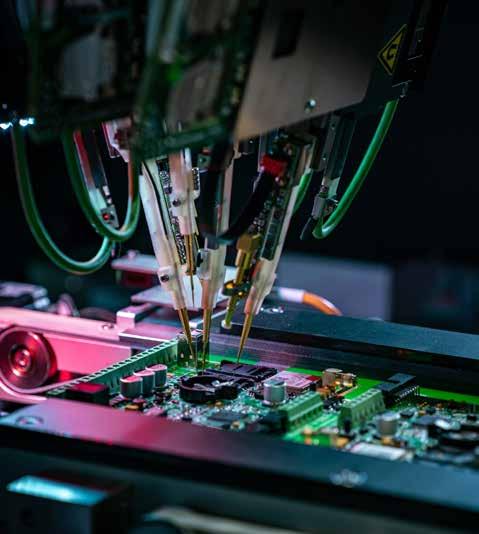
In addition to the benefits mentioned above, TSN can also help to improve the security of industrial Ethernet networks. TSN includes a number of security features that can help to protect networks from cyberattacks. This is important for semiconductor manufacturing, as these facilities often contain sensitive data and equipment.
Overall, TSN is a valuable technology for semiconductor manufacturing. It can help to improve the efficiency, reliability, and security of industrial Ethernet networks. This can lead to significant benefits for semiconductor manufacturers.
Tom Burke, Global Strategic Advisor, CC Link Partner Association.
Visit Website
45 07.2023 industrial ethernet book
SOURCE: CLPA Technology
Data analytics and machine learning can be used to optimize the semiconductor manufacturing process. Enabling real-time monitoring and control of the manufacturing process leads to improved yields, reduced costs, and faster time to market. In addition, TSN enables the integration of both IT and OT networks, exposing more devices and their data for analysis.
Taking the proven benefits of TSN to the real world
Time-Sensitive Networking (TSN) is a crucial enabler of industrial digitization applications. Numerous industry stakeholders are building TSN-enabled systems to bring the proven benefits of TSN to the factory floor through technological advances and real-world applications.
TIME-SENSITIVE NETWORKING (TSN) HAS leapt from the pages of academic journals to practical applications in the real world in recent years. Companies that want to reap the benefits of this exciting technology must understand the needs of industry players and start to build TSN-enabled systems.

Even before the formation of the IEEE TSN task group, Moxa has been working with industry partners to promote digitalization in the manufacturing sector, also known as Industry 4.0, and all the key technologies for industrial automation. Time-sensitive networking (TSN) is a crucial enabler of industrial digitization applications where Moxa has already made valuable contributions. In fact, Moxa has partnered with numerous industry stakeholders to build TSN-enabled systems and bring the proven benefits of TSN to the factory floor through several technological advances and real-world applications.
Traditionally, different equipment, interfaces, and protocols presented serious challenges to transmitting, receiving, and processing large amounts of data in a timely manner for industrial automation applications. TSN overcomes these challenges by enabling
time synchronization on the network so that all connected devices share a common time reference for all data to become available at a given point in time for specific tasks. These TSN-enabled systems are highly reliable as its built-in bounded low latency in a deterministic networking environment optimizes performance and security.
Technical achievements
From a technological standpoint, Moxa partnered with NXP to prove the high reliability of the key TSN redundancy protocol, 802.1 CB. In addition, Moxa’s cooperation with Intel and Keysight has also demonstrated the feasibility of wireless TSN networks in the future.
Proven network redundancy
To achieve a high level of reliability, IEEE 802.1CB Frame Replication and Elimination for Reliability (FRER) works to send duplicate copies of each frame over multiple disjoint paths, so even in the event of partial network failure, proactive redundancy still allows for seamless communication. During Taipei automation 2022, Moxa partnered with NXP Semiconductors N.V., a Dutch semiconductor
designer and manufacturer and port Industrial Automation GmbH, to test the reliability of an 802.1 CB-based ring topology that used Moxa switches to connect NXP equipment. As engineers unplugged certain network cables to simulate network failure, the data packets that controlled the critical equipment still synchronized and operated normally. Moreover, this test also demonstrated that robust network redundancy helps recover multiple points of failure, not just a single point of failure.
Wireless possibilities unleashed
Another important step toward implementing TSN in industrial automation is to ensure the data can be transmitted in wireless applications. As a lot of industrial equipment is mobile, true IIoT will not be possible without a wider array of TSN wireless applications. In Taipei Automation 2021, Moxa, Intel Corporation, and port Industrial Automation GmbH developed a platform that demonstrates the industry’s first ready-to-use, application-to-application TSN solution for instant transmission of data. Designed to be compatible with various
46
industrial ethernet book 07.2023
SOURCE: ISTOCK
Technology
TSN-enabled systems are highly reliable as its built-in bounded low latency in a deterministic networking environment optimizes performance and security.
communication protocols, the new platform is flexible and expandable, which means it can be used to build the next generation of smart manufacturing and logistics solutions, particularly when mobile devices are not only desired but required in real-world use cases. Wireless TSN fleshes out the full potential of TSN as a truly unified and high-performance network infrastructure allows all types of traffic to coexist.
Taking the technology further
In addition to proving that the technology works, Moxa has also implemented TSN in several real-world applications to help companies achieve tangible business benefits.
Reduce the Total Cost of Ownership in Wafer Manufacturing
Cooperating with ELS System Technology, (a leading Taiwanese lithography solution provider), Moxa successfully integrated TSN into the wafer manufacturing process. The system includes incorporating machine vision into the wafer misalignment correction system. The TSN technology successfully integrated a high-bandwidth video application with a highreliability on-demand motion control CC-Link IE TSN. The solution delivered a stable motion control system, fully equipped with machine vision, for the misalignment correction system.
Moxa’s TSN solution also supports different types of traffic that may have very different requirements and offers accurate motion control data about network traffic in real time using the same open and standard network. What’s more, the TSN solution also helps increase the economic feasibility of the network and reduces the total cost of
ownership (TCO) as the infrastructure is easy to maintain and scale up.
Minimize inconvenience of downtime with video component logging
Real-time video monitoring is notoriously data- and bandwidth-hungry. TSN’s ultrareliability and bounded low latency make building a converged application for recording and streaming live video over a network a feasible task. To help the Japanese industrial conglomerate Mitsubishi Electric improve the logging of all system components during visual inspections, Moxa built a module with the capability to record the video stream, waveform, and related information to help users speed up troubleshooting when necessary. As they are no longer required to scour through different devices or networks, engineers can now conduct their forensic investigation on a TSN-based integrated system in which critical and synchronized visual data is safely accessed, stored, and protected.
How TSN helps
TSN is the key to smart factory automation because deterministic, real-time communication allows different equipment to work seamlessly together. As networks grow in size and complexity, TSN implements traffic management and prioritizes system resources to ensure that critical data gets delivered on time, which makes the network ultra-reliable and more secure. We will now consider two use cases that showcase the capabilities of TSN, and how Moxa works with system integrators, machine builders, and end users to achieve better returns with TSN.
Use Case 1: machinery manufacturer
Responding to market demands for advanced, integrated, and highly automated machinery, machinery manufacturers aim to offer machinery that features built-in scalability, accelerated sensing, and complex laser and machine control applications. As such, however, different proprietary networks belonging to different components require seamless communication and integration in order to deliver optimal performance. Furthermore, the maintenance of these networks will present challenges for operators, especially when the machines are shipped abroad and training for operators is at times not followed through.
Moxa developed a unified TSN network to enable deterministic communication between cameras, sensors, and machine controls. Moxa’s TSN-G5008 Series full Gigabit managed switch connects multiple I/Os to the servo drivers and machine vision cameras. Due to the “first-in, first-served” nature of Ethernet, it was not possible to transmit critical data on the same cable. With standard Ethernet TSN infrastructure, however, traffic management now allows critical data to share networking resources and ensures data packet delivery. The switch is designed to make manufacturing networks, such as those of machinery manufacturers, compatible with TSN to reap the benefits of Industry 4.0.

Use Case 2: mass customization production system
A shorter production cycle is beneficial to businesses because efficiency leads to lower costs and more flexibility. It also allows businesses to cater to a changing market and
47 07.2023 industrial ethernet book
SOURCE:
MOXA
Technology
Moxa's TSN switch allows data to be sent between the PLC and end devices.
offer mass customized—and often higher margin—products, such as commercial-off-theshelf (COTS) products. For manufacturers, such efficiency and flexibility can only be achieved when various systems—including production, assembly lines, and logistics—are on a unified network so changes and adjustments to the production and distribution processes can be implemented on short notice more effectively.
To make mass customization possible, manufacturers can deploy Moxa’s TSN-G5004 and TSN-G5008 Series Ethernet switches to combine existing proprietary networks into a single TSN-capable network to boost efficiency. Most importantly, manufacturers can achieve information technology (IT) and operational technology (OT) convergence, so as to reduce the number of processes required to make a product. As such, adaptive production, mass customization, and production optimization are enabled because assets are managed through a TSN-enabled network, with which deterministic communication ensures effective control over the entire manufacturing process.
A simplified network topography benefits operators because maintenance becomes easier and more cost effective. As operators now maintain a unified network instead of many networks with different protocols and requirements, training can be streamlined. Cabling, too, becomes more straightforward, contributing to lower maintenance costs.
Boundless benefits
TSN brings efficiency, easier management, and cost effectiveness to the world of industrial
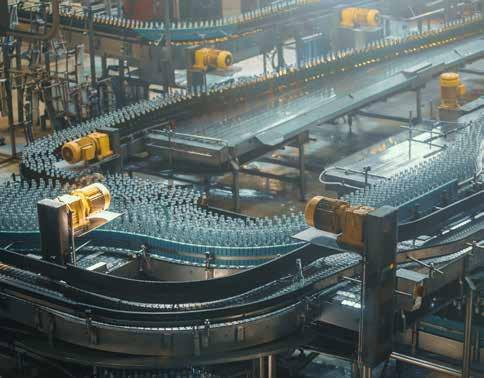
automation. Its deterministic communication, whether wired or wireless, contributes to the ultra-reliability needed for high-stakes and demanding industrial systems. As TSN requires a standard, unified network for different devices, IT and OT convergence offers fewer nodes, streamlined cabling, and easier maintenance. These benefits are realized by a wide range of stakeholders from machine builders to system integrators to end-users.
Machine builders
With TSN technology, machine builders can leverage a competitive network infrastructure that allows the motion bus and information being sent across the network to be converged on the same cable. This simplified architecture can also reduce the number of nodes thereby saving overall costs and maintenance effort. In addition, from the performance standpoint, the cycle time of the control loop can be shortened, which makes it possible to control more devices. Last, since TSN technology runs on a Gigabit network, the higher bandwidth is well-suited for adding more applications in the future.
System integrators
The unified TSN network also simplifies network and automation architecture by reducing cabling and engineering efforts. TSN’s ability to converge all proprietary networking technologies into one single cable means that network planning and scale can be controlled and predicted, thereby reducing the total cost of ownership and saving maintenance efforts.
End-Users
Furthermore, TSN is compatible with existing networks so additional network gateways that connect to different proprietary systems are no longer required. In fact, TSN’s compatibility with existing standard networks enables easy data access so that the system can more easily optimize resources and effort for end-users.
Compared to other existing networking technologies, TSN is also better equipped to prioritize critical packets over non-critical but high-bandwidth consuming applications, which reduces overall system downtime.
Finally, leveraging standard Ethernet technologies means that the latest cybersecurity solutions developed for Ethernet are also available to TSN networks, offering greater protection and adaptability in an everchanging threat climate.
Preparing for TSN adoption
When it comes to implementing a TSN-capable application, a thorough understanding of the existing application requirements and network topology is a prerequisite to choosing the most suitable protocol and the right configurations for the switches and end devices.
Let us consider an example that requires both PLC communications and image capture. This application would require transmitting two types of data to the same host computer. Using a combined network topology, it is clear that the video stream is sent from port 4 to port 1, while the controller sends the synchronization message to the master server from port 2 to port 1.
Protecting the control packet from the high bandwidth video stream requires configuring the necessary protocols on the network, including time synchronization (802.1 AS) and time aware shaper (802.1 Qbv) on the related components and ports.
The control packet is sent at 1 second cycles, 300 µs for cycle date, and 200 µs for time sync data while the remaining 500 µs is running the non-cyclic data. The device can assign the corresponding VLAN ID to each slot to ensure that the cycle data will not be affected.
After clarifying the behavior of the application, the last step is to configure the necessary configurations on the Ethernet switch and end device.
Summary
For a long time, Moxa has been working to ensure that TSN technologies are achieving their true potential and helping industry leaders accelerate their digital transformation in industrial automation.
Technology article by Moxa.
Visit Website
48 industrial ethernet book 07.2023
Technology
TSN brings efficiency, easier management, and cost effectiveness to the world of industrial automation. Its deterministic communication, whether wired or wireless, contributes to the ultra-reliability needed for high-stakes and demanding industrial systems.
SOURCE: ISTOCK
Automation with remote motion control for intelligent nodes
Industry 4.0 is pushing the boundaries of intelligent automation. Systems solutions are paving the way toward an industrial transformation that promises unprecedented response times along with maximum performance capabilities for motion control.
INDUSTRY 4.0 BRINGS THE PROMISE OF intelligence at the edge over long distances, and 10BASE-T1L Ethernet is paving the way forward with its power over data line (PoDL) capabilities, high data transfer rates, and compatibility with Ethernet-based protocols. This article explains how the new 10BASE-T1L Ethernet physical layer standard can be integrated into automation and industrial scenarios to connect controllers and user interfaces with endpoints, such as multiple sensors and actuators—all using a standard Ethernet interface for bidirectional communication.
Introduction
The 10BASE-T1L is a physical layer standard targeted to industrial connectivity. It offers data rates up to 10 Mbps and power delivery over distances up to 1000 m using a standard twisted pair cable. Low latency and the PoDL capabilities allow devices such as sensors or actuators to be controlled remotely. This article explains how to implement a system composed of a remote host that synchronously controls two or more stepper motors, thereby demonstrating the capabilities of real-time communication over distance.

System overview
To begin, the figure above shows a schematic of the system-level application. On the host side, the conversion between standard and 10BASE-T1L links is managed by the ADIN1100 and ADIN1200 Ethernet PHYs, while, on the
remote side, the controller interfaces with the link using the ADIN1110 Ethernet MAC-PHY, which only requires an SPI peripheral to exchange data and commands. Precise and synchronized motion control is accomplished by using the ADI Trinamic™ TMC5160 stepper motor controllers and drivers that allow the generation of six-point ramps for positioning without requiring any calculation on the controller.
Choosing these components also keeps requirements on the microcontroller low in terms of used peripherals, computing power, and code size, allowing the use of a wide range of commercially available products. Moreover,
up to a predefined power consumption limit, the entire remote subsystem can be directly powered from the data line, so the media converter board is the only module requiring a local power supply.
System hardware
The system is composed of four different boards:
The EVAL-ADIN1100 board features an ADIN1200, 10BASE-T/100BASE-T PHY, used in combination with the ADIN1100 10BASE-T1L PHY to translate messages from one physical standard to the other. It can be configured for different modes of operation. In this

49 07.2023 industrial ethernet book
Figure 1. A system overview.
Technology
SOURCE: ANALOG DEVICES
Figure 2. EVAL-ADIN1110, EVAL-ADIN11X0EBZ, and TMC5160 shield assembled.
SOURCE: ANALOG DEVICES
project, Standard Mode 15 (media converter) is used. The EVAL-ADIN1100 board also features an integrated microcontroller that performs the basic configuration required for media conversion as well as to read diagnostic information. However, it cannot interact with sent and received messages; this board is completely transparent to the communication.
The EVAL-ADIN1110 is the core of the remote devices’ controller. The ADIN1110 10BASE-T1L MAC-PHY receives data through the 10BASE-T1L link and transfers it to an onboard Cortex®-M4 microcontroller via an SPI interface for processing. This board also exposes Arduino Uno-compatible headers that can be used to install a shield to add functionalities to the board.
The TMC5160 shield is a custom-developed board based on the Arduino shield form factor. A single shield supports up to two TMC5160 SilentStepStick boards, and multiple shields can be stacked together to increase the maximum number of controlled motors. All the drivers share the same SPI clock and data signals, but chip select lines are kept independent. With this configuration, two communication modes are possible: if chip select lines are asserted individually, the microcontroller can communicate with single controllers—for example, to configure motion parameters. Instead, by asserting more chip select lines simultaneously, all selected drivers receive the same command at the same time. The latter mode is mainly used for motion synchronization purposes. This board also provides some additional input capacitance to the StepSticks to reduce current peaks at motor startup and to smoothen the current profile during normal operation. This allows the use of PoDL to supply the whole system with a maximum of two NEMA17 motors (with the default setup, the maximum transmitted
power is 12 W at 24 V). The board is also used to ease the connection with stepper motors by using screw terminals to make phase outputs from the controllers more accessible.
Two EVAL-ADIN11X0EBZ boards, one for the media converter and one for the EVALADIN1110EBZ, are used to add PoDL capabilities to the system. This board is a plug-in module that can be mounted on the MDI prototyping headers of the evaluation boards and can be configured for both supplying and receiving power from the data line.
Software
The software code is available for download: Remote Motion Control with 10Base-T1L Ethernet - Code.
To keep the code lightweight and minimize communication overhead, no standard communications protocols were implemented above the data link layer. All the messages are exchanged using the payload field of Ethernet frames with a predefined fixed format. Data is organized into 46-byte segments, composed of a 2-byte fixed header and a 44-byte data field. The header includes an 8-bit device type field, which determines how received data is processed, along with an 8-bit device ID field, which enables the selection of an individual physical device if more devices of the same type are present.
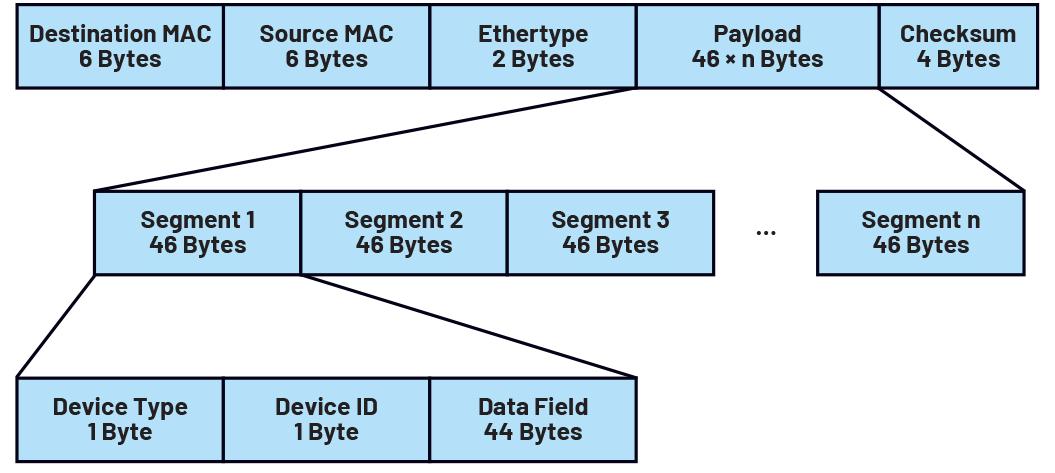
The host interface is written in Python to ensure compatibility with both Windows and Linux hosts. Ethernet communication is managed using the Scapy module, which allows creating, sending, receiving, and manipulating packets at each layer of the stack, including the Ethernet data link. Each device type defined in the protocol has a corresponding class that includes properties to store data to exchange, and a set of methods that can be used to modify these properties instead
of having to directly edit the variables. For example, to change motion direction in speed mode for the motion controller, methods “setDirectionCW()” and “setDirectionCCW()” are defined, instead of having to manually assign 0 or 1 values to the direction flag. Each class also includes a “packSegment()” method that packs and returns the segment corresponding to the controlled device in the form of an array of bytes according to the predefined format for the considered device type.
Firmware is written in C using the ChibiOS environment, which includes, among other tools, a real-time operating system (RTOS), a hardware abstraction layer (HAL), and peripheral drivers, allowing the code to be easily ported between similar microcontrollers. The project is based on three custom modules: ADIN1110.c is the driver used to allow the exchange of data and commands with the ADIN1110 over the SPI interface. It includes low-level communication functions for reading and writing data from device registers, and higher-level functions for sending and receiving Ethernet frames. It also includes the function used to establish communication between 10BASE-T1L transceivers. The pin that notifies if new frames are available is read on interrupt to minimize latency.
TMC5160.c implements all the functions needed to control the TMC5160 motion controller, configured to operate in fullfeatured motion controller mode. Both constant speed and position control modes are implemented, allowing smooth and precise positioning with six-point ramps. Communication with multiple motion controllers is achieved through a single SPI bus with independent chip select lines. A set of functions and typedefs is also provided to ease motion synchronization.
50 industrial ethernet book 07.2023 Technology
SOURCE: ANALOG DEVICES
Figure 3. Communication protocol format.
Devices.c is the interface between data received from the T1L link and physical devices connected to the controller. It includes similar structs to the ones defined in the host interface and functions to update them each time a new frame with valid data is received. This module is also used to determine which actions are executed each time a struct is updated—for example, which physical motion controller is related to commands received at a specific device address.
System Highlights and Validations
This project aims to demonstrate how the new 10BASE-T1L Ethernet physical layer standard can be integrated into automation and industrial scenarios to connect controllers and user interfaces with endpoints, such as multiple sensors and actuators.
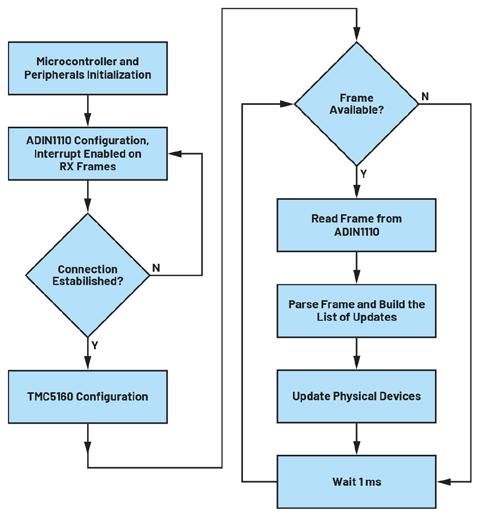
This application is targeted to the remote real-time control of multiple stepper motors, widely used in the industry for low power automation tasks, but also utilized in light robots and CNC machines, such as desktop 3D printers, desktop milling machines, and other types of cartesian plotters. However, its use cases can also be extended to other types of actuators and remote-controlled devices. Its main advantages over already existing
interfaces used for similar purposes are: Simplified wiring, requiring only a single twisted pair. The possibility to also deliver power on the data line allows low power devices, such as sensors, to be directly powered from this connection, further reducing the number of required wiring and connectors, and so lowering the complexity, cost, and weight of the overall system.
Power delivery using the PoDL standard, which uses a DC voltage superimposed on data lines to supply power to devices connected
to the network. This type of coupling can be achieved by only using passive components, and once the voltage on the receiver end is filtered, it can be directly used to power the device or a DC-to-DC converter without requiring rectification. By correctly dimensioning components used for this type of coupling, a high efficiency system can be achieved. In this project, using standard components installed on the evaluation boards leads to an overall efficiency of about 93% (with a 24 V supply and total load current of 200 mA). However, this result has a wide margin for improvement—indeed, most of the losses are due to resistive drops of the passive components along the power path.
Versatility, as it can be used for both last-mile and end-point connectivity. Analog Devices 10BASE-T1L devices have been tested for distances up to 1.7 km. They also allow daisy-chaining with a low impact on system complexity. For example, by using the ADIN2111 two-port low complexity switch, it is possible to design devices that integrate daisy-chaining capabilities, making the link suitable also for end-point nets.
Easy to interface with existing equipment that already integrates an Ethernet controller, including personal computers and laptops. Data frames follow the Ethernet data link standard, and all Ethernet-compatible protocols can be implemented above it, so only a media converter is needed as a bridge with standard Ethernet links. For example, the board used in this project, the EVAL-ADIN1100, can be used as a reference design for a transparent media converter, requiring only two Ethernet PHYs and an optional microcontroller for configuration and debugging.
High data rate, reaching up to 10 Mbps, full duplex. This, combined with the daisy-chain topology on which industrial Ethernet-based protocols can be implemented, allows it to be used in a real-time application, where deterministic transmission latency is required.
Isolation between the transceiver and media can be achieved with both capacitive or magnetic coupling, depending on the
51 07.2023 industrial ethernet book Technology
Command Execution Time (ms) Cumulative Delay Time (ms) Optimal Execution Time (ms) Synchronized motion, two motors (×24 TMC5160 register accesses) 24.058 24.000 0.058 Synchronized motion, two motors (×24 TMC5160 register accesses) 24.058 24.000 0.058 Dummy data request (no TMC5160 interactions) 24.058 24.000 0.058
Figure 4. A firmware flowchart.
safety and robustness requirements of the application.
Multiple measurements were done on the system to evaluate its performance. All the peripherals used to communicate with the ADIN1110 transceiver and TMC5160 controllers were configured for the maximum possible speed that is reachable with the standard hardware configuration. Considering the 80 MHz system clock of the microcontroller, the data rate of SPI peripherals was set to 2.5 MHz for the motion controllers and to 20 MHz for the ADIN1110 transceiver. For the TMC5160, by tuning the microcontroller clock configuration and supplying an external clock signal to the IC, SPI frequency can be further increased up to 8 MHz, while for the ADIN1110 the maximum limit by data sheet is 25 MHz.
For the latency, the total time between a data request and the reception of the answer frame has been evaluated at about 4 ms (average on 500 samples, measured with the Wireshark protocol analyzer computing the difference between the timestamps of data requests and corresponding answers). Additional evaluations were made to determine which parts of the system are responsible for this delay. Results showed that the main cause is the delay function provided by the RTOS, which allows a minimum delay of 1 ms, used to set the interval between write and read operations for the TMC5160, while the required delay is in the order of tens of nanoseconds. This could be improved by defining a different timer-based delay function that allows for shorter delay intervals.
The second cause of this delay is the Scapy function used to receive frames, which requires a minimum set-up time of 3 ms after it has been called. In a real-world application, this can be improved by developing the interface directly with network adapter drivers for the operating system, instead of third-party tools like Scapy. However, drawbacks include losing compatibility with different operating systems and increasing code complexity.
Precise execution times for the callback implemented on the microcontroller were measured by toggling a GPIO and measuring the high period with an oscilloscope. Measured execution time includes functions used to read and parse received frames and to send commands to motion controllers.
The second set of measurements was
made to evaluate power losses along the transmission path when using PoDL to supply remote devices. Tests were conducted by substituting the motion controller shield with an electronic load set at different currents, starting from 0.1 A up to 0.5 A in steps of 100 mA, to determine which components had a major impact on power losses and, consequently, how to improve the design to achieve higher current ratings.

The results show that a major contribution to the losses is given by the bridge rectifier along with the Schottky diode D2, both used for reverse polarity protection. Both components could be replaced with a similar circuit based on MOSFET transistors and an ideal diode controller to gain higher efficiency without losing this type of protection. At higher currents, the contribution of the DC resistance of the coupled inductors used for input and output supply filtering becomes dominant, so to improve current capability, similar inductors with higher current ratings are also needed.

Conclusion
Industry 4.0 requirements are pushing the boundaries of intelligent automation. ADI Trinamic technology used along with the ADIN1100, ADIN1110, and 10BASE-T1L transceivers enable the remote control of sensors and actuators up to 1700 m from their controller without requiring power at the edge.
With a reliable method of remote control, stepper motors can easily be controlled in real-time at longer distances without sacrificing any performance or speed. Systems solutions are paving the way toward an industrial transformation that promises unprecedented response times along with maximum performance capabilities.
Learn More
52 industrial ethernet book 07.2023 Technology
Alessandro Leonardi, Account Manager, Giorgio Paganini, Student at Polytechnic of Milan, and Fulvio Bagarelli, Technical Leader, Analog Devices.
SOURCE: ANALOG DEVICES
Figure 5. A simplified scheme of power path.
Figure 6. Power losses for each passive component, as a function of current.
Advancing Industrial Ethernet creates choices for networking
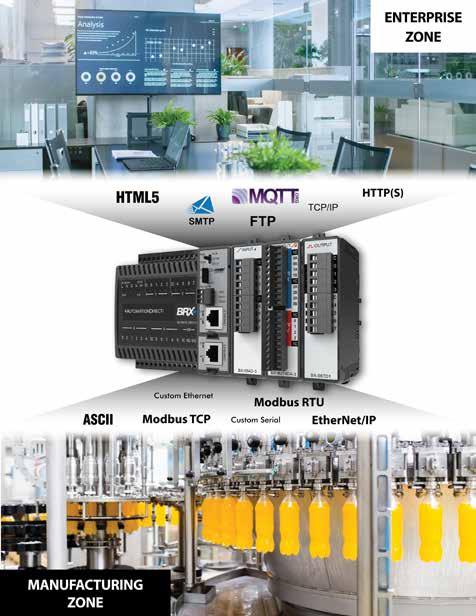
As industrial Ethernet implementations continue to increase, designers have better choices for higher speeds and factory-friendly form factors. Ethernet is now the preferred industrial networking technology for discrete manufacturing, and it is also advancing in the process industries.
BY ANY MEASURE, ETHERNET DIGITAL communications technology is a multidecade and still-evolving success story. Developed in the 1970s and standardized in the 1980s, Ethernet has marched forward from a performance standpoint, achieving great economies of scale, and supporting countless commercial, consumer, and industrial applications.
This third aspect—suitability of Ethernet for industrial use—was never a sure bet. Early iterations of the technology had sufficient speed for general applications, but lacked the performance and determinism demanded by high-speed and critical applications. Another significant challenge was that the form factor was not convenient or economical to install on machines or in factories.
Therefore, many designers remained reliant on basic serial communications and dedicated fieldbuses. However, the situation has changed significantly over recent years as most issues with using Ethernet for industrial applications have been solved, and improvements are continuing.
To a great extent, Ethernet is now the preferred industrial networking technology for discrete manufacturing, and it is also advancing in the process industries. More recent developments are extending the usefulness of Ethernet for all types of industrial applications.
Digital communication progress in the factory
Commercial networking grew from a need to connect multiple computers, and related digital devices like printers, with each other. Industrial networking has many of the same needs, but faces additional challenges in terms of performance, installation means and methods, and other specialized requirements.
Any digital network specifically designed for communication among machine and factory automation devices and input/output (I/O) signaling came to be known as a fieldbus. The earliest examples used RS232/422/485 serial communications standards for pointto-point and multi-drop communications. The multiconductor cable media provided adequate communication speed and useful installation distances, adequate for industrial environments.
Some vendors used proprietary protocols over serial media, but eventually the open Modbus protocol emerged as a leading standard. Other closed serial protocols developed over the years, and some became more open. Collectively, serial-based fieldbuses were used to do most of the heavylifting for industrial plants, at least from controllers down to field-level edge devices. As Ethernet gained acceptance and
capabilities as an expanding commercial off-the-shelf (COTS) technology, industrial users were eager to take advantage of its many benefits. Initially, commercial-grade Ethernet cabling and essential devices like switches made the most sense for connecting programmable logic controllers (PLCs) with higher-level PCs and servers running humanmachine interface (HMI) and supervisory control and data acquisition (SCADA)
53 07.2023 industrial ethernet book Technology
Ethernet has progressed from a commercial technology into a fundamental way of interconnecting all types of industrial field devices, controllers, and on-site or cloud-based computing resources.
SOURCE: AUTOMATION DIRECT
Because Ethernet has become a preferred industrial automation networking technology, AutomationDirect has developed the Stride family of ruggedized products and installation-friendly form factors to make Ethernet truly be practical for these applications.
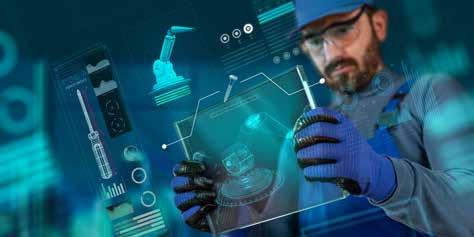
applications. Eventually, a number of advances made Ethernet suitable for connecting cloud resources, PCs, and PLCs down to plant-floorlevel devices.
Industrializing a network
Today, almost every PLC and HMI includes on-board or optional Ethernet support. Similarly, intelligent field devices used for factory automation—such as variable frequency drives (VFDs), servo drives, and I/O gateways—are increasingly available with native Ethernet connectivity. Smart analytical devices, and even some more basic field instrumentation, also offer Ethernet support. Ethernet is a leading way to improve communication bandwidth and connectivity among all sorts of devices—if it can be installed practically for industrial applications. Vendors have responded to user preferences with a variety of products specifically designed to improve the usability of Ethernet on machines and in factories.
Ruggedized installation media
While it is possible to use commercial- and consumer-grade components for industrial
installations, the results can be less than ideal. Instead, designers should choose products built to withstand the environmental and electrical noise conditions found near operating equipment. These are some of the design details for consideration when selecting cabling and connectivity components:
• Industrial-grade Ethernet patch cables use shielded twisted pairs (STP), with
an overall foil shield to protect against electrical noise. Cat5e cables are still available and support 10/100/1000 Mbps speeds, but users should strongly consider standardizing on more contemporary Cat6a cables because they support up to 10 Gbps speeds and 30W power over Ethernet (PoE+).
• Connectorized data cables designed with ruggedized RJ45 connectors and/ or M12 quick disconnect (QD) fittings and high-flex jackets are rated for use in harsh environments. They are shielded and rated for speeds up to 10 Gbps. These cables make it practical and economical to perform open wiring installation on machines, greatly reducing the installation cost and complexity compared with traditional conduit and cable.
• Field-wireable ruggedized connectors, both RJ45 and M12, for use with bulk industrial rated cable, make it convenient to install longer runs up to the rated 100m distance. These connectors are available in axial, 45- and 90-degree angles, with various speed and IP ratings.
High-speed industrial devices
Any Ethernet network needs switches, and it is tempting to use office-grade products due to their low cost. However, industrial-grade switches, routers, media/protocol converters, and gateways are specifically designed to withstand industrial environments, resulting in a lower total cost of ownership. Specifiers should look for the following features:
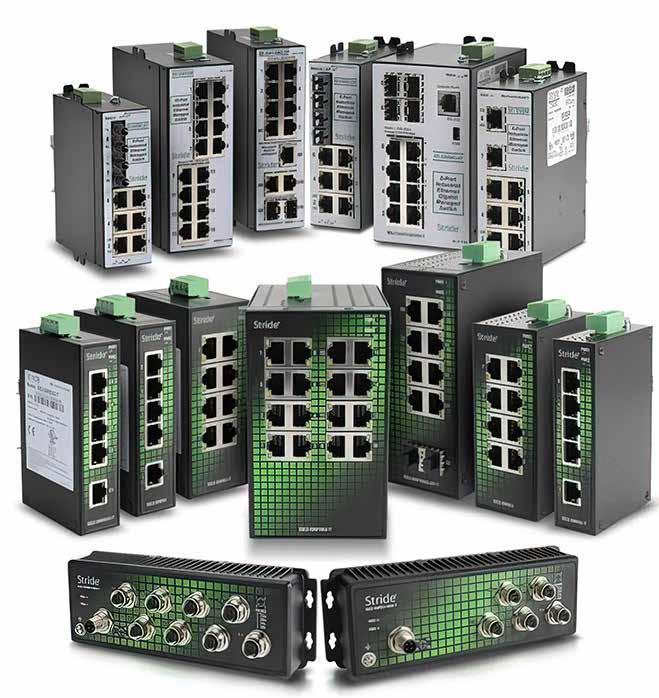
• Devices rated for extended temperature ranges.
• Switches with native M12 connectors where needed, suitable for IP65 dustand water-tight open installations.
• While 10/100 Mbps is still commonly available, most designers should consider standardizing on 1 Gbps moving forward.
• Cost-effective unmanaged options for
54 industrial ethernet book 07.2023 Technology
SOURCE: AUTOMATION DIRECT
Ethernet technology has made great strides for use on machinery and on the factory floor.
SOURCE: ISTOCK
basic and low-port-count applications, and managed versions—with industrialspecific communications protocol capabilities—for advanced use.
• The ability to be powered by common industrial 24VDC or vehicle 12VDC power, or sometimes 48VDC or 18-30VAC power.
• Support for PoE and PoE+ as it lets certain network devices power downstream field devices.
• Options for fiber optic SFP transceivers for longer-range transmission.
• Availability of virtual private network (VPN) routers for secure remote access, especially important when implementing cloud-based IoT solutions.
Once an appropriate Ethernet infrastructure is in place, designers can use many communications protocols over Ethernet, even concurrently, depending on the products they are using and what they are trying to achieve.
EtherNet/IP, Modbus TCP, PROFINET, and EtherCAT are among the most popular operational technology protocols. Some OT protocols are specialized for motion, power, or HVAC applications. For communications at higher level IT portions of an automation architecture, protocols like OPC UA and MQTT provide contextual data exchange and improved security.
Ethernet extends other fieldbuses
Ethernet is also instrumental for enabling other useful non-Ethernet fieldbus installations. For instance, a fieldbus called IO-Link— specified by IEC 61131-9—provides a cost-effective smart connectivity for many types of field devices found on industrial equipment.
IO-Link provides point-to-point bidirectional communications and power over new or existing three-conductor unshielded 24VDC cables.
The IO-Link fieldbus architecture bridges with on-site Ethernet using master modules, allowing PLCs and other PC or cloud-based apps to communicate simultaneously with field devices using protocols like EtherNet/IP and MQTT. IO-Link is a right-sized and scalable digital technology, enabled by effective deployment of Ethernet.
What is next for industrial networking?

Ethernet technology has made great strides for use on machinery and on the factory floor, but there remain a few obstacles to overcome for even wider deployment, including the following:
• Increased cable distances
• Greater power distribution capability
• Intrinsic safety options for hazardous locations
• Potential to handle safety-related I/O
To address these and other issues, a new implementation called Ethernet-APL has been developed. Ethernet-APL uses two-wire media, and the standard is built upon the IEEE802.3cg standard. Cable installations can reach up to 1,000m for trunks and 200m for drops, supporting 10Mbps communications combined with power. Ethernet-APL is in the early stages of availability, and it represents the next step in extending Ethernet digital networking in a form factor useful for all types of industrial installations.
There will always be cases where it makes technical and/or commercial sense for designers to specify the minimum viable installation media and networking devices. However, product availability and small cost premiums often mean the best approach to future-proofing is to select higher-performing Ethernet installation media and devices, especially with regards to communication speeds and industrial ratings.
Bill Dehner, AutomationDirect
Visit Website 55 07.2023 industrial ethernet book
IO-Link is another fieldbus architecture particularly suitable for many industrial applications. Ethernet media enables
SOURCE: AUTOMATION DIRECT Technology
IO-Link to connect a wide variety of field devices to PLC controllers and cloud computing simultaneously, using protocols like EtherNet/IP and MQTT.
Wireless solutions for access points and bridges
Integrated bridging capability built into industrial-grade wireless access points can add value to networking investments along with simplifying connectivity, management and installation for industrial use. Users face multiple challenges to ensure high-throughput, low-latency, reliable, secure and scalable networking.
BUILDING A WIRELESS NETWORK FOR A processing facility, automation assembly plant, manufacturing complex, or other large industrial space can be a daunting task. System integrators and network administrators face multiple challenges in ensuring highthroughput, low-latency, reliable, secure and scalable connectivity. One of the many decisions they’ll face is where to deploy Wireless Access Points (WAP) or antennas and wireless bridges.
In this article, we address the differences between wireless network bridges and WAPs. "Bridge” is often used interchangeably with “access point (AP)” or with any device that supports network bridging. This can be traced back to multi-purpose wireless devices featuring AP functionality, along with bridging, routing and repeating modes as configurable options. Today, a bridge is not necessarily a device so much as an
available function. For instance, Antaira does not sell standalone bridge devices. Instead, we have integrated bridging capability into our industrial-grade wireless access points to add value to your investment and to simplify connectivity, management and installation for industrial use.

Bridging the knowledge gap for industrial wireless
The distinction between wireless bridging technology technologies and wireless access points technologies is their end goal. A bridge interconnects two physically separate networks or network segments via a wireless signal on OSI Level 2 (the data level), thereby enabling the node-to-node transfer of data between source and destination.
On the other hand, WAPs act as portals where multiple wireless-capable devices — IP cameras, laptops, robots, sensors, Automated
Guided Vehicles (AGVs), sensors — gain access to the Internet or an organization’s Local Area Networks (LAN). The WAP connects to a wired router, industrial switch, internet gateway or hub via an Ethernet cable, and projects a wireless signal throughout an office or building. WAPs can also be used to increase the speed, reliability and range of an existing wireless network.
LANs tend to be divided into multiple segments to prevent traffic congestion or interference or for cost or other management, control or security reasons. Those segments must be integrated or “bridged” for traffic to be shared between them. In effect, a network’s wireless bridge creates one aggregate “flat” network from two LAN segments. Any LAN protocol (Ethernet, FDDI, token ring) can be bridged, yet most LANs today are Ethernetswitched LANs, hence most bridges are Ethernet bridges.
56 industrial ethernet book 07.2023 Technology
SOURCE: ANTAIRA
Antaira Technologies’ ARX-7235-AC-PD-T Access Point is designed for industrial and enterprise outdoor wireless access applications.
How wireless bridges actually work
So how does a secure wireless bridge function? Basically, it will either block or forward data based on the destination MAC address featured on each data frame. If the software on the bridge believes the destination address is on a network other than that from which the data was received, it can forward the data to the other networks to which it is connected. If the software that the address is not on the other side of the bridge, the data is blocked from passing.
Bridges come in different configurations. The three main types of bridges deployed in today’s networks are:
• Transparent bridges are invisible to other devices on the network, machines that are oblivious to the bridge’s existence. They perform only the function of blocking or forwarding data based on the MAC address. Simple, compact, robust and reliable, transparent bridges are the most common type of bridge.
• Translational bridges convert one networking and control system to control another device by translating the data it receives.
• Source-route bridges are for use on Token Ring networks. Designed by IBM, this bridge makes specific decisions about how the frame should be forwarded through the network. With the diminishing popularity, capabilities, reliability and cost of Token Ring sourceroute solutions these bridges are not commonly used today.
Going wireless for network bridges
In the not-so-distant past, a network administrator could only connect two network bridge devices with a long Ethernet cable. Industrial-grade wireless networks now reliably perform the same task without the hassle, installation, maintenance and costs of running Ethernet cables or leasing a line. Instead, wireless bridging quickly connects segments via antennas transmitting Radio Frequency (RF) signals capable of spanning between buildings and machines on the same campus, over long distances, and through walls, to transmit and receive data.
Wireless bridge communication is between two transceivers, antennas rather than one emitter broadcasting a signal to multiple receivers. Therefore, wireless bridge links are referred to as point-to-point links.
Also, a wireless bridge’s RF power is not transmitted by positioning the antenna in a 360° coverage pattern. Instead, the RF is purely directional to maximize signal energy, typically between 10 and 20 degrees. Wireless signal energy at full throughput requires that a perfect (or near-perfect) line of sight exists between the two bridge devices. In dense industrial environments, operating
at lower frequencies – 2.4 GHz instead of 5 GHz – can help with signal strength since longer wavelengths penetrate obstacles better. In terms of range, a wireless bridge spans distances up to several miles which can be increased by raising the antenna, but not indefinitely, as radio and optical signals attenuate with distance. Latency and bandwidth will vary greatly depending on the bridging wireless technology solution that you choose and your environment, i.e., line of sight, weather, equipment density, and walls.
Obviously, wireless bridging connectivity represents a far more robust and economical alternative to laying cable, especially in hardto-reach and hazardous industrial locations. Wireless bridging is more convenient for scaling a network, moving network devices, or connecting clients to additional LAN segments. In industrial environments it may also be impractical or even impossible to run long-distance Ethernet cables, leaving wireless connectivity as the only option.
Wi-Fi access points as an industrial wireless solution
Now that we have a better idea of what wireless bridging is, how do wireless access points fit into the network for wireless solutions?
WAPs are primarily designed to form Wireless Local Area Networks (WLANs). In this configuration, a WAP connects to a wired router, switch or hub and then broadcasts a wireless signal throughout a designated area for wireless-capable devices to access. In this way, a WAP acts like a hub, but with wireless technologies so instead of plugging in cables you tune into a wireless signal. WAPs can be installed virtually anywhere an Ethernet cable from a router can reach — mounted on poles, from ceilings to ground, and on walls. WAPs featuring Power over Ethernet will not need to be located near an electrical outlet, giving the system designer more installation flexibility.
In reliable wireless bridge mode, WAPs are excellent for extending the wireless coverage of components of an existing 802.11 network across a longer distance. It can also perform the traditional duties of a bridge, that is, wirelessly interconnect two network segments. Some wireless bridges support only a single point-to-point connection to connect to another AP. Others support pointto-multipoint connections to connect several other APs.
In a point-to-wireless access point industrial to-multipoint version of this application, a single WAP can be physically wired to the network to act as the base station unit. Multiple additional WAPs or “subscribers” are mounted throughout the building. Subscribers link wirelessly to the base station enabling them to propagate a shared network signal over an extended area. Point-to-multipoint
technology is ideal where there is a larger cluster of devices that have lower bandwidth requirements. Point-to-point, on the other hand, deploys wireless technology with only two WAPs and is a better solution for higher bandwidth demand environments serving fewer devices. Point-to-point requires WAPs on each side to be physically connected to a router or switch with an Ethernet cable.
WAPs are a security risk. Without security, wireless networks can be accessed by unauthorized users within range of the network’s signal so sensitive information transmitted through the network may be intercepted. This is why Antaira industrial wireless AP/bridge/repeaters offer users multiple security protection options: WiFi Protected Access (WPA), WPA2, WPA3, Remote Access Dial In User Service (RADIUS), and Wires Equivalent Privacy (WEP). These various protection features do not take the place of the fundamental wireless internet security responsibilities of all users, such as guarding and frequently changing passwords.
Industrial applications that utilize wireless APs and bridges
1. Industrial Automation: Wireless access points and bridges are commonly used in industrial automation systems to provide a wireless connection between sensors, controllers, and other devices. This allows for the seamless integration of different components and provides real-time data and control capabilities.
2. Logistics and Warehousing: In large logistics and warehousing facilities, wireless access points and bridges can be used to provide connectivity between inventory tracking systems, handheld devices, and other equipment. This helps to streamline operations and improve productivity.
3. Manufacturing: Wireless access points and bridges can be used in manufacturing plants to connect machines and other equipment to a central control system. This allows for remote monitoring and control, reducing downtime and improving efficiency.
4. Oil and Gas: In the oil and gas industry, wireless access points and bridges can be used to provide connectivity between remote monitoring stations and central control systems. This helps to improve safety, reduce downtime, and increase efficiency.
5. Agriculture: Wireless access points and bridges are increasingly being used in agriculture to provide connectivity between sensors, drones, and other equipment. This helps farmers to monitor crop health, optimize irrigation, and improve yields.
Article by Henry Martel, Field Applications Engineer, Antaira Technologies. Visit Website
57 07.2023 industrial ethernet book Technology
Six benefits of augmented reality in manufacturing
Augmented reality provides a multiplier effect for improving the efficiency and quality of production and inspection processes. The industrial sector can gain effectiveness and efficiency while reducing errors and the additional costs generated, but it does not stop there.
MANUFACTURERS ARE INCREASINGLY incorporating augmented reality in their digital transformation strategy. Augmented reality provides a multiplier effect for improving the efficiency and quality of production and inspection processes.
Defect detection assistance, improved production rate, increased safety for your factory and teams, increased productivity, reduced cycle times, and, above all, reduced costs: the benefits are numerous.
AR allows the industrial sector to gain effectiveness and efficiency while reducing errors and the additional costs generated, but it does not stop there. The team at
DELMIA take a closer look at some of the main benefits of augmented reality in manufacturing.
1- Increasing productivity through augmented reality
AR is a solution whose effectiveness and value to the industry are more proven than ever to increase industrial productivity. When used in factory and production processes, there are many gains you can make in your quest for operational excellence.

In addition to allowing you to be more effective and fast in each of your tasks (assembly, inspection, maintenance), such a
solution will enable you to be more efficient by optimizing processes and providing digital instructions for operators.
Your teams can identify non-conformities faster and drastically reduce errors and related costs. Operations are performed correctly by having the right information in the right place at the right time and assigned to the right person.
To summarize, whatever your industrial performance, it will be optimized thanks to:
• Faster learning curve for new operators
• Reduction of inspection time (DELMIA Augmented Experience provides up to 84% reduction of inspection time
58 industrial ethernet book 07.2023
Technology
AR is a solution whose effectiveness and value to industry are more proven than ever to increase industrial productivity.
SOURCE: DELMIA
measured at our customers)
• Reduction of your cycle times and reporting
• Automatically updated reports and documentation
• Better traceability
2 – Improving quality through AR
The detection and reduction of non-conformities are one of the main objectives of the teams in charge of inspection and quality. As we all know, the slightest error can be extremely costly and leads to a series of time-consuming corrective actions, such as:
• Correct identified defects
• New production runs
• Several additional quality controls
• Possible additional logistical costs
• Generate dissatisfaction for end customers
A detected non-conformity or error often implies more time to devote to the handled part, which can even go as far as stopping the production to identify and resolve the problem. The challenge is to detect errors as early as possible in the process to avoid late detection and the need to stop production. A major challenge, especially when you want to
be part of an operational excellence strategy.
An augmented reality solution allows you to anticipate these errors. With an AR tool, quality control information is contextualized and localized to simplify the inspection process. Operators are guided through each inspection point using 3D data imported directly into the field and superimposed on the part to be inspected throughout the manufacturing process.

This capability supports efficient validation of product conformity. In addition, errors are precisely localized, allowing the proper corrective and repair actions to be applied.
DELMIA Augmented Experience solutions are already helping many industrial customers identify and efficiently report production defects.
But the best way to reduce quality problems is to avoid assembly errors in advance. AR effectively guides the operator to achieve “first time right” via the contextualization of work instructions and their display in the field, making them intelligible.
3 – Connecting the field with new digital capability
What if the augmented operator was the connection point that could reconcile the
real and virtual worlds? Displaying digital data from the design teams on the shop floor places allows the operator to interact with the data. AR becomes the link to creating a tangible connection between the Virtual (and all the digital information from the engineering office), with the Real, meaning the operations happening on the field.
Implementing an augmented reality solution, especially if the chosen technology offers integration capabilities with the existing systems (MES, for example), may be the answer to the digital gap between V + R.
4 – Supporting the future operator by boosting skills development
Integrating AR solutions in a factory can positively affect team training. The simple fact of using augmented reality contributes to your operators’ training and increases their skills.
Using digital work instructions projected in the field or visualized through a tablet or augmented reality glasses, your field teams receive the right information at the right time and become operational more quickly.
It is proven that using a virtual world facilitates the assimilation of information
59 07.2023 industrial ethernet book Technology 59
SOURCE: DELMIA
The Industry 4.0 megatrend is now being applied across a wide swath of industrial sectors where it is benefitting discrete and process manufacturing,
A shared digital landscape connects all stakeholders to improve visibility into, control over, and synchronization across manufacturing operations and supply chain processes on a global scale. It also provides real-time manufacturing intelligence to enable automated production and quality control supporting global continuous improvement and to improve sustainability by enabling identification of areas of waste. Manufacturers are able to accomplish this through the connection of the real world with the virtual world that is enabled by this shared digital landscape.
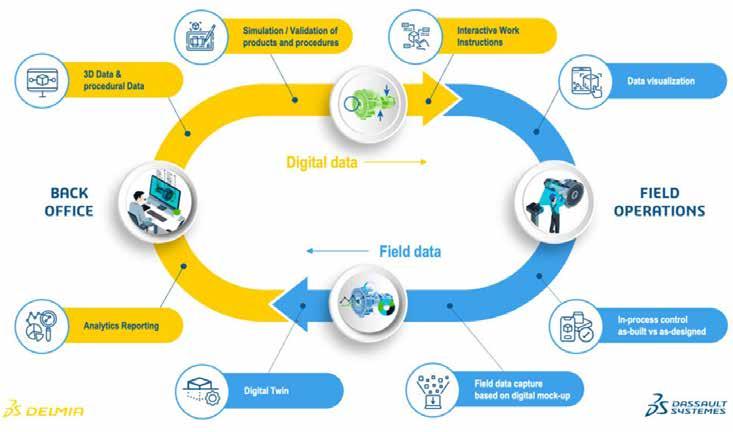
communicated and its application in the field. This way, your operators develop much more intuitive gestures allowing them to become more autonomous and to respond well to possible issues. In addition, it also facilitates the memorization of the information that you transmit to your teams.
Integrating an augmented reality solution fits perfectly into a training strategy. It facilitates the transmission of knowledge within your company and develops your operators’ autonomy more quickly, thanks to its more intuitive content.
5 – Providing a safer and more comfortable work environment
Better security and fewer errors for industry applications
Augmented reality technologies can also improve your factories’ safety and comfort. Complex assembly operations or maintenance actions provide significant support, consider many risk factors and detail faults with better accuracy than any other resource (documentation or technicians).
Comfort : The various hardware configurations compatible with augmented reality solutions allow workers to adapt to the workstation. The variety of hardware enables them to work hands-free and avoid numerous return trips to the office. A savings
of time and energy that also provides comfort for your teams.
Technician safety: Your operators are better guided and accompanied step-by-step with alerts displayed in AR at the proper process moment.
As a result, the risk of human or technical errors is reduced, and your field teams better understand your processes.
6 – Optimize documentation, traceability and reporting
Augmented reality supports a solution for better industrial traceability. Getting the right information at the right place at the right time can be complex. Manufacturers need to be aware of a lack or break in collecting field data and documentation that is not up to date and too difficult to use.
Using augmented reality in a plant can positively impact traceability. A good AR solution offers “as-built” data collection capabilities in the field with automated reporting, which provides full visibility into the assembly and inspection processes throughout the product production and distribution chain.
We help industries optimize their traceability with innovative digital solutions that provide automatic data collection directly from the field following quality
control. With such a solution’s capabilities, you can conduct documented inspections for internal traceability purposes and better communication with your customers.
Digital continuity thanks to augmented reality
In summary, augmented reality has many advantages for industry:
• Augmented Reality helps achieve operational excellence (getting it right the first time)
• AR solutions bring rapid ROI by improving quality, deadlines, productivity, etc.
• AR improves your traceability and contributes to the collection of data that will feed the digital twin
• It encourages the development of your operators’ skills
• It contributes to the reduction of your cycle times by reducing your assembly and inspection times
Thus, you can optimize your performance considerably and reinforce your manufacturing processes with augmented reality.
Technology article by Delmia.
Visit Website
industrial ethernet book 07.2023
60 Technology SOURCE: DELMIA
COPA-DATA launches MTP Suite







Functionality is achieved through integration of MTP on the process orchestration layer (POL).


















































INDUSTRIAL
SOFTWARE DEVELOPER,














































































































































































































































has launched a Modular Type Package (MTP) Suite as part of its zenon software platform. The technology has been developed for the pharmaceutical, chemical, energy, food and beverage and is designed to enable plug-andproduce manufacturing. Following several years of development, the zenon MTP Suite is the first of its kind successfully implemented in a real-life plant.
MTP is the cross-industry and crossmanufacturer standardization of the interfaces of different pieces of machinery which form a module. The basic requirement for modular production is uniform descriptions of information for modules. MTP makes this possible by breaking down a production line into smaller modules and ensures they all speak the same language, thus supporting interchangeability.
The zenon MTP Suite can be compared to a home office. Regardless of the brands of your equipment — your keyboard, printer, mouse — you can combine them without encountering any problems. Similarly, MTP enables users to directly access the available services of any individual modules.
Integration with POL


















































In a manufacturing facility, this functionality is achieved through the integration of MTP on the process orchestration layer (POL). As the name suggests, this is the layer of a plant’s technology in which different processes are directed and launched.
In the zenon MTP Suite, the steps to process orchestration are simple. After the MTP files are imported, the modules are configured against the service parameters. From there, a manufacturer can create batch recipes according to ISA-88 — an international standard for batch control — and start the manufacturing process.
The model promises faster time-to-market for batch production than many methods due to the ease of integration of prefabricated modules. For the pharmaceutical industry, this could see straightforward integration of different production modules, allowing manufacturers to produce multiple types of medicines with little engineering effort — hence the phrase, plug-and-produce.
The zenon MTP Suite can yield benefits to a business’s bottom-line by reducing production costs by up to 40 percent. This is achieved by making smaller batches more cost effective while also reducing maintenance and storage costs.



























COPA-DATA’s new offering has already been deployed at Merck’s research and development












































(R&D) laboratories of the Electronics Technology Center at its global headquarters in Darmstadt, Germany. The deployment was predicted to result in more efficiency interaction between production and R&D and accelerate the market launch of new products by up to 50 per cent.























































“During market launch, speed is a crucial competitive advantage and is especially important for our products,” said Hajo Neumann, Head of Integrated Supply Chain within the Electronics business sector of Merck. “We also expect that the boundaries between R&D and production will become increasingly blurred in the future. These days, the batches produced in the laboratory are becoming ever smaller but also much more individualized,” added Neumann, explaining the progress of this trend.
“Configuring a laboratory environment in which hardware and software work in tandem should be as simple as connecting a printer to a PC. Speed, flexibility and efficiency are thus improved considerably. The joint project with Merck will set an example internationally,”

said Thomas Punzenberger, CEO and founder of COPA-DATA, commenting on the future of the laboratory.
Implementation of MTP

For MTP to be achieved, uniform information is first essential to facilitate integration into a POL, like the zenon POL. The software can seamlessly connect with the zenon Engineering Studio and zenon Service Engine to automatically generate a complete process control system.
zenon offers all the functionalities manufacturers need to implement MTP in their plant. By using zenon Logic as SoftPLC, it is possible to make older plants MTP-compatible, even if they are running mostly on legacy equipment. In the same way you can connect your 90s printer to your shiny new laptop — MTP makes integration simple and scalable. COPA-DATA
61 07.2023 industrial ethernet book
More
Learn
Product News
MTP is a cross-industry and cross-manufacturer standardization of the interfaces of different pieces of machinery which form a module.
Multiple communication protocols
CODESYS-Based AX-300N and AX-324N PLC Controllers are compatible with AS Series IO portfolio.
Simplified programming, support for multiple communication protocols for industrial control systems
AX-300N
Delta is introducing the compact, mid-range AX-300N and AX-324N PLC controllers. These AX-3 series controllers offer a CODESYS development environment to enable intelligent industrial automation applications. Compatibility with Delta AS Series IO products and support for a broad range of industrial communication protocols including PLCopen v1.0 function blocks, Ethernet/IP, and OPC UA server ensure compatibility across a wide range of automation applications such as packaging, food and beverages, ceramics, textiles, and energy.

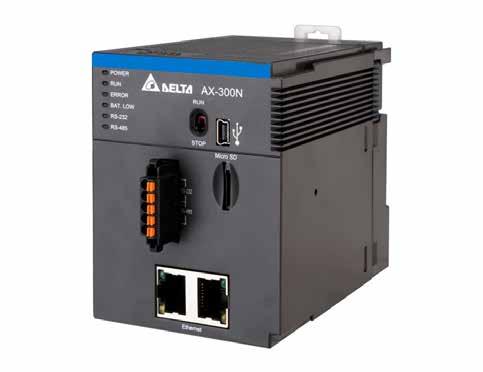
Distributed RIO or conventional setups
The new PLC controllers expand Delta’s product portfolio, offering customers more options both for conventional control systems with I/O capabilities integrated into the controller as well as distributed remote input/output (distributed RIO) setups.
The AX-300N is a cost-effective solution that provides compatibility with the complete Delta AS-Series IO portfolio. It’s well-suited to distributed RIO environments which can offer considerable advantages including savings on cabling, easier scalability, and greater system design flexibility.
For conventional installations, the AX-324N offers 16 integrated digital inputs, 8 digital outputs, and 6 HSC channels at 200 kHz. Both models provide dual Ethernet ports with support for EtherNet /IP (scanner/ adapter) and OPC UA server.
AX-324N
High-performance CPU and broad protocol support
With the most recent update, the highperformance CPU inside both the AX-300N and AX-324N provides support for FTP/SFTP, MQTT, Profinet Slave and IOLink communications protocols. These communications features now make it possible to import third-party CODESYS.
Faster time-to-market with DIADesigner-AX
DIADesigner-AX software integrates CODESYS into Delta’s DIAStudio software platform. The environment provides support from the planning stage through execution and commissioning. It simplifies the implementation of both simple and
complex motion control, including singleand multi-axis movements, gearing, ECAMs and interpolation. It also helps to ensure compliance with international standards such as IEC 61131-3 and PLCopen. Software developers will benefit from integrated tools including an oscilloscope, simulator, and CAM editor.
AX-300N and AX-324N at a glance
• High performance processing with high data capacity and execution speed AS
module compatibility for access to Delta’s comprehensive IO portfolio
• Support for major fieldbus technologies simplifies integration of 3rd-party devices Cost-effective access to CODESYS-based motion control
The AX-300N and AX-324N PLCs are now available throughout the EMEA region
62 industrial ethernet book 07.2023 Product News
Delta Learn More
SOURCE: DELTA
AX-300N
AX-324N
WiFi Access point extends networks
New HDMI feature from Red Lion boosts productivity with real-time visual awareness.
The FlexEdge® Intelligent Edge Automation Platform with HDMI quickly and effortlessly creates real-time productivity scoreboards.
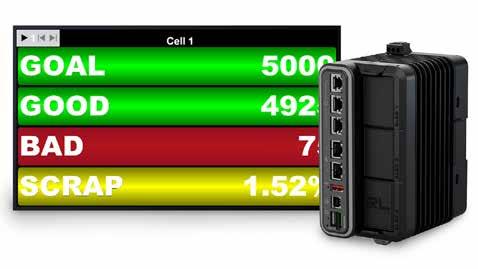
As industries around the world digitalize their operation, the need to securely access and visualize data to power their performance in real-time is crucial. FlexEdge with HDMI, powered by Crimson®, is designed with userfriendly configuration capabilities to easily develop and deploy customized dashboards to keep production teams informed of critical KPIs, helping to drive efficiency, and enabling real-time, actionable insights.
Access and visualize data
FlexEdge with HDMI, powered by Crimson, gives you easier, more powerful ways to access and visualize your data:
Directly collect data from devices such as PLCs, drives, bar code scanners and more. Map data to PLCs, PCs and SCADA systems with a simple no-code drag-and-drop interface, allow a Siemens® PLC to communicate with an Allen Bradley® drive in mere seconds.
Use the built-in graphics library, with over 5,000 drag-and-drop elements to visually represent your application, including tanks,
gauges and other industrial graphics choices.
Sync data to FTP servers and MS SQL Server to send information where it needs to go.
Set up alerts for important events using the built-in mail manager, which sends notifications to one or more specified recipients via email, with attached report or logged data files.
Use the built-in Cloud Connectors to link
your productivity application data to one or multiple cloud providers, including Azure, AWS, Google or other MQTT brokers.
Choose from commonly used templates available as demo databases in Crimson.
Compact gigabit Ethernet switches
Westermo industrial Ethernet switches help future-proof data communication networks. SOURCE:
A powerful range of compact industrial Ethernet switches and routers to meet the increasing demands for high-performance data communication networks within transportation, manufacturing and energy distribution. The new Lynx 3000 series has been designed to provide outstanding levels of performance, reliability and security, with gigabit speeds and advanced functionality to support the requirements of both current and future networks.

The Lynx 3000 series provides layer 2 and layer 3 functionality, enabling the management of complex ring networks and routing solutions. A wide range of models ensure suitability for many different use cases, including applications requiring very high performance. With entrylevel models optimised for Fast Ethernet application and variants supporting up to 2.5 gigabit speeds, the series is ideal for handling big data, high bandwidth and mission-critical applications. As with all Westermo Ethernet products, the Lynx 3000 series is powered by the WeOS operating system, which along with an intuitive web interface for set-up and configuration reduces complexity by simplifying the installation, operation and maintenance of
individual devices and complete networks. This removes the need for specialised IT support or training. WeOS also protects investments by ensuring continuous support for an expanding range of communication protocols and features.
Recognising the growing sophistication of cyberattacks, a suite of cybersecurity tools is available to reduce risk and increase cyber
resilience. These can be used to build networks in compliance with the IEC 62443 standard, which defines technical security requirements for data communication network components.
Westermo
Learn More
63 Focus 07.2023 industrial ethernet book Product News
Lion Controls Visit Website
Red
SOURCE: RED LION
WESTERMO
Industrial computer with IEC 62443-4-2
With the release of the latest Moxa Industrial Linux 3 (MIL3) platform, Moxa delivers what they claim is the world's first IEC 62443-4-2 certified host device—the UC-8200 Series Arm-based computers to the market. IEC 62443-4-2 certification ensures that the 4-cm ultra-thin UC-8200 computers provide a security-enabling Linux platform that integrates a suite of secure-by-design hardware and software features to protect IIoT data and infrastructure against cyberthreats.
“Moxa’s UC-8200 Series, running on the MIL3 platform, is the world’s first host device to attain ISA/IEC 62442-4-2 certification,” said Pascal LeRay, Head of Cybersecurity at Bureau Veritas (BV), the global certification body that issued the ISASecure CSA Security Level 2 certification for the UC-8200 Series industrial computers.
“It is a great honor to assist Moxa to successfully obtain IEC 62443-4-2 certification to empower the company to better grasp the overall security issues and quality of product development through IEC 62443 to enhance its competitiveness. IEC 62443 universal standards for industrial control and information security have become mandatory technical requirements in many countries. Furthermore, as demand for product security increases, the importance of IEC 62443-4-2 has grown significantly, resulting in a growing number of customers requiring proof of security level from manufacturers for their Industrial IoT equipment,” Pascal LeRay added.
Security-certified platform for efficient application development
“The IEC 62443-4-2 certified UC-8200 Series computer makes it easier for asset owners and system integrators to integrate IIoT applications by providing a secure platform that has already been tested and validated,” said George Y Hsiao, Product Manager of Moxa IPC Business. “Without such a certified platform, asset owners and system integrators would need to spend a significant amount of time testing and validating the security of the computing platform and its components before integrating their applications. This process is necessary to ensure the overall security of the IIoT system, but it can be time-consuming.”
The UC-8200 Series computer comes with a security-hardening guide to help maintain the security of the computer throughout its entire lifecycle, from integration and installation to operation, maintenance, and decommissioning. It also includes a security diagnostics utility, which allows customers to confirm that the UC-8200 Series computer
remains compliant with IEC 62443-4-2 during the integration stage.
Increasing operational resilience
As OT/IT convergence continues to advance, the need for enhanced network security, endpoint protection, strong reliability, and a long lifecycle becomes critical for the development of next-generation industrial IoT systems that can effectively defend against cyberthreats.
Hardware Root of Trust
The UC-8200 Series computer incorporates a one-time programmable (OTP) fuse and Trusted Platform Module (TPM) 2.0 technology to establish a hardware-based chain of trust that safeguards the Secure Boot process and software updates. This blocks hackers from taking control of the device during boot time and prevents malicious updates from being used for malware exploitation.
Reliable and fast recovery
Device availability is critical in industrial automation and control systems (IACS). That is why Moxa Industrial Linux 3 (MIL3) comes equipped with quick backup and restore utilities, as well as automated system recovery features based on an overlay file system architecture. This helps to reduce downtime in the event of a security breach, process failure, and file corruption, such as a power outage during a critical update.
Robust connectivity and network management
MCM (Moxa Connect Manager) easily optimizes LAN and WAN network availability by automatically switching between Ethernet, Wi-Fi, and LTE connections, which can minimize downtime caused by network unavailability or DOS attacks
UC-8200 Series Highlights
• Developed according to IEC 62443-4-1 standard and compliant with IEC 62443-4-2 industrial cybersecurity Security Level 2 standard
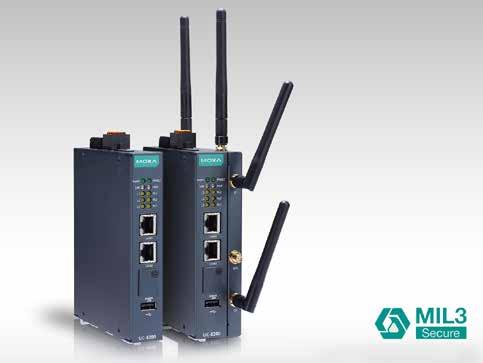
• IEC 62443-4-2 compliant diagnostic tool and security-hardening guide
• Automatic failover between Wi-Fi, cellular, and Ethernet connections for reliability and high availability
• Automatic system failover for system recovery and file backup
• TPM 2.0 for hardware root of trust authentication to prevent malware takeover or tampering
• Host-based Intrusion detection system (HIDS) and network security monitoring
• Optional built-in cellular and additional Mini PCI Express (mPCIe) slot for Wi-Fi modules
• Moxa Industrial Linux with 10-year support
64 industrial ethernet book 07.2023 Product News
Moxa Learn More
Moxa Launches World's First Industrial Computer With IEC 62443-4-2 Host Device Certification
SOURCE: MOXA
UC-8200 Series.
Industrial wireless solutions
Routeco and CoreTigo engage in partnership to revolutionize UK factory automation.
To meet demand for Industry 4.0 factory automation solutions keeps across the United Kingdom, a new partnership was created between UK’s industrial automation distributor Routeco, and global wireless industrial automation solution provider CoreTigo.
The two companies agreed on pursuing a joint effort, leaping industrial automation forward and creating numerous new applications and capabilities. By doing so, Routeco is expending the spread of IO-Link Wireless communication in its territories, shifting machines to wireless communication, and unbinding their full capabilities.
IO-Link Wireless provides essential characteristics for advanced industrial manufacturing. From a 5 Msec low latency and deterministic nature, through scalability reliability and coexistence capabilities, it portrays must have abilities for a competitive market. IO-Link Wireless presents reliability of 1 e-9 Packet Error Rate (PER), which compared to everyday wireless communications protocols such as Wi-Fi, Zigbee and BLE (Bluetooth low energy), is 1 million times better (1e6).
Complementing Routeco’s portfolio, some of CoreTigo’s main solutions target challenges in
the Packaging, Automotive, Pharmaceuticals and Metal Works. Enabling for the first time real-time control and monitoring on industrial rotating devices, IO-Link Wireless enhances and opens the door for new capabilities with Rotary Tables & Carousels, Transport Tracks, Smart Machine Tooling, Robotic End-of-Arm, Condition Monitoring and many others.
IO-Link Wireless is a deterministic, low
latency (5 msec), highly-reliable and scalable universal wireless communication protocol. Based on the IO-Link IEC 61131-9 standard, it is designed for factory automation, coexisting with both wired and wireless networks.
Routeco and CoreTigo
Learn More
Industrial DataOps solutions

Belden Horizon Data Operations and Data Manager address industrial data complexity.
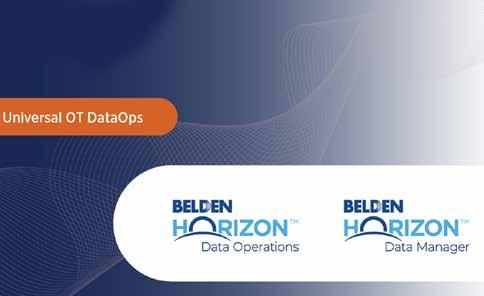
Belden announced the launch of its new Belden Horizon Data Operations (BHDO) and Belden Horizon Data Manager (BHDM) industrial data operations solutions. As the adoption of the industrial internet of things (IIoT) and Industry 4.0 advances, the volume of data available from connected operational technology (OT) devices grows, providing opportunities for enterprises to use data to improve business decision-making. The new additions to the Belden Horizon softwarebased services suite work in concert to meet these expanding requirements by empowering industrial organizations to address data complexity through secure and managed data access, analytics and integration.
BHDO and BHDM enable industrial organizations to extract actionable insights from OT assets in a more efficient and secure manner to reveal areas to streamline production processes, enhance operational efficiency and improve uptime. BHDO collects and analyzes OT data at the network edge and transmits it to information technology (IT) destinations for further analysis and action, while BHDM manages distributed BHDO deployments.
BHDO and BHDM offer powerful features:
• 250+ supported OT protocols and easy integration into dozens of IT system types.
• Digital twins and analytics tooling empower users to collect, contextualize and analyze data at the edge.
• Scalable to support large or remote deployments by using BHDM software to manage many BHDO instances.
Belden
Learn More
65 07.2023 industrial ethernet book Product News
SOURCE: CORETIGO
SOURCE: BELDEN
Industrial Edge AI platform
Neousys powerful industrial Edge AI platform offers extensive I/O capabilities.
The new Nuvo-10208GC is the latest member of the industrial Edge GPU family of computers from the industry-leading provider of rugged embedded systems Neousys. These systems can support up to two of the latest Ada Lovelace generation NVIDIA RTX 4080 graphics cards, offering exceptional compute performance for GPU-accelerated Edge AI applications such as autonomous driving, vision inspection, and intelligent video analytics.
Powered by the Intel 13th Gen Core i9/i7/ i5/i3 processor family, the Intel R680E chipset supports up to 64GB of DDR5 4800MHz memory with additional support for ECC memory for mission-critical applications. Additionally, the Nuvo-10208GC supports TPM2.0 and AMT for remote management and comes with a selection of high-speed I/O including:
• 6x 10Gbps USB3.2 Gen2 ports
• 2x COM ports supporting RS-232/422/485 serial signals
• 2x 2.5 Gigabit Ethernet ports
• 1x Gigabit Ethernet port
The Nuvo-10208GC is an industrial Edge AI system designed around supporting the two 350W graphics cards and has two PCIe Gen 4 x16 slots supporting eight lanes each, with
additional expansion options available via three PCIe Gen 3 slots supporting four lanes as well as two Mini PCIe sockets with SIM, and 1x M.2 2242/3052 B-key socket with SIM.
The Industrial-grade Edge AI Platform includes Neousys' proven heat dissipation design, ensuring that both the CPU and GPU can offer 100% performance in temperatures of up to 60°C. Patented damping brackets
also ensure the system can withstand up to 3Grms of vibration and a wide-range 8 to 48V DC power input, making the Nuvo-10208GC suitable for a variety of demanding industrial applications and environments.
Impulse Embedded
24 V power supply for machine building
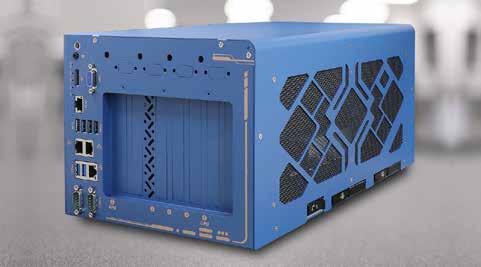
Plug-and-play solution optionally available with an integrated electronic circuit breaker.
The Trio Power 24 V power supply from Phoenix Contact sets a new standard in machine building. The plug-and-play solution for the control cabinet is optionally available with an integrated electronic circuit breaker.
The power supplies are particularly spacesaving due to their narrow overall width and capability of being mounted directly side by side. The low overall depth enables installation in 210 mm small housings. The power supply units also enable easy handling: Push-in connection technology allows for quick and tool-free installation. Integrated marking fields can be used to easily display equipment identifications and circuits. Due to an intuitive commissioning concept, the devices are quickly ready for use. The mechanical lock of the potentiometers ensures that the devices are also tamper-proof.
Furthermore, the power supplies have various diagnostic options. The multicolor LEDs and a collective relay contact are used to signal all relevant states, such as DC OK, overload, and short circuit. An optional IO-Link interface is available for diagnostics and parameterization. With up to 960 W output power in 1 AC and 3 AC versions, the power
supply is suitable for drive technology. The dynamic boost (150 percent for five seconds) also enables difficult loads to be started. With the powerful output characteristic curve, even capacitive loads can be charged without any problems. As an option, the power supply is
available with a built-in electronic circuit breaker, thus offering high system availability. Phoenix Contact Learn More
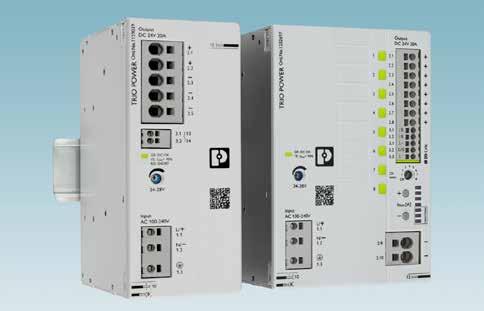
66 Product News
Learn More
SOURCE: IMPULSE EMBEDDED industrial ethernet book 07.2023
SOURCE: PHOENIX CONTACT
IS3800-Vial-OCR
Industrial Ethernet Book
The only publication worldwide dedicated to Industrial Ethernet Networking and the IIoT. Visit iebmedia.com for latest updates.

View and/or download latest issue of Industrial Ethernet Book and past issues. Search our database for in-depth technical articles on industrial networking.



Learn what's trending from 5G and TSN, to Single Pair Ethernet and more. Keep up-to-date with new product introductions and industry news.
 New website offers deepest, richest archive of Industrial Ethernet and IIoT content on the web.
New website offers deepest, richest archive of Industrial Ethernet and IIoT content on the web.














































































































































































































 New website offers deepest, richest archive of Industrial Ethernet and IIoT content on the web.
New website offers deepest, richest archive of Industrial Ethernet and IIoT content on the web.